
Eds: K Kaluwa, E. Kruger
Photos: P Martin
Lima RDF
From: Cedara report no N\A\99\18, P.
Breedt
For: KZNDAE, 2012
Natural Pest and Disease Control
Handbook

2
1. INTRODUCTION
NATURALPEST AND DISEASECONTROL
HANDBOOK
1. INTRODUCTION
Plant pests and diseases are significant to farmers because they can cause damage to plants and plant
products. It is estimated that the home gardener can lose up to 25% of his crop if pests and diseases are
left uncontrolled. In some cases this figure might be 100%.
There are a number of methods available for controlling pests and diseases. The general belief amongst
farmers and extension workers is that synthetic chemicals (fungicides, bactericides and insecticides) are
the only way to manage pests and diseases in crops. These sprays give very impressive results in an
instant, but could result in serious problems in the longer term. Non target interactions, pollution and
resistance are common issues, as is the fact that many pesticides are extremely poisonous and can be
harmful to human beings, animals and the environment.
It is however possible to produce high-quality vegetables with sufficiently high yields, without using
these chemicals. At the same time, soil fertility and the quality of the environment can be improved.
The best approach to good vegetable production would be to try to avoid problems as far as possible,
instead of trying to cure them. The only way to avoid problems from occurring in your garden is to make
sure that the soil is healthy and that the environment that the plant is growing in is stable and balanced.
There are a number of things that should be kept in mind when trying to implement natural control in a
system:
Crop protection builds on traditional knowledge: developing and improving it.
Pesticides can be used, but only in cases of emergency.
Methods should be locally adapted, simple, inexpensive and easy to manage.
The small-scale farmer needs to understand correlations and act independently. S/he must be
the crop protection expert.
People must learn to use nature itself to help them in their struggle against pests and diseases.

3
2. ENEMIES OR FRIENDS
2. ENEMIES OR FRIENDS
Plants, animals and micro-organisms can influence the productivity in your garden. About 99% of all
plants, animals and microorganisms are beneficial to agriculture and the general economy. It is only 1%
of all living creatures that causes so much trouble in gardens around the world. If left undisturbed,
natural enemies could mostly keep this troublesome 1% under control. Modern agriculture techniques
generally do not consider the relationship between organisms, or the balance between different
populations that keep pest explosions in check.
Small scale farmers may attempt to grow crops in poor soils under less than ideal conditions. Plants
stressed in this way are easily susceptible to pest and disease attack.
2.1 PLANTS
Unwanted plants are called weeds. Weeds can cause damage to crops in several ways:
They take up water and nutrients from the soil, in competition with the crop.
They can shade crops from the sun. Sunlight is very important for the growth of crop plants.
They can host insect pests that can damage the crops.
They can reduce the quality of the produce, e.g. weed seeds found in cotton would reduce the
price considerably.
Weeds aren’t always pests
They can be used to your advantage:
-Weeds can be slashed and used as a green manure to feed the soil.
-They cover the soil and can prevent soil erosion.
-They can attract and host very valuable beneficial insects (predators and parasites).
-They can act as wind breaks.
2.2 ANIMALS
These include large mammals, rodents, birds,
slugs and snails, insects and nematodes.
2.2.1 Large mammals
Buck, pigs, goats, cattle, rabbits, dogs and cats
are considered to be large mammals. If these
are not kept out of the garden they could
cause considerable damage.
Animal manure can bevery useful in
feeding the soil.

4
2. ENEMIES OR FRIENDS
2.2.2 Rodents
Rodents include mice, rats and mole
rats and moles. These animals can cause
damage to your crops and stored grain
and should be controlled.
2.2.3 Birds
Birds can be divided into two large groups: the
meat-eaters and the plant/seed eaters. The
plant/seed eating birds can damage your
crops by eating the seedlings, fruits and seeds
of the crop. Such birds are: crows, sparrows,
pigeons and finches.
Not all birds are pests
The meat-eating birds can be very beneficial in
your lands, as they will reduce the numbers of
insects and rodents in the crops. Such birds
are owls, swallows and hawks.
2.2.4 Slugs and snails
These creatures can cause considerable damage
to your crops if they are not controlled.
2.2.5 Insect Pests
Insect pests can be divided into two categories:
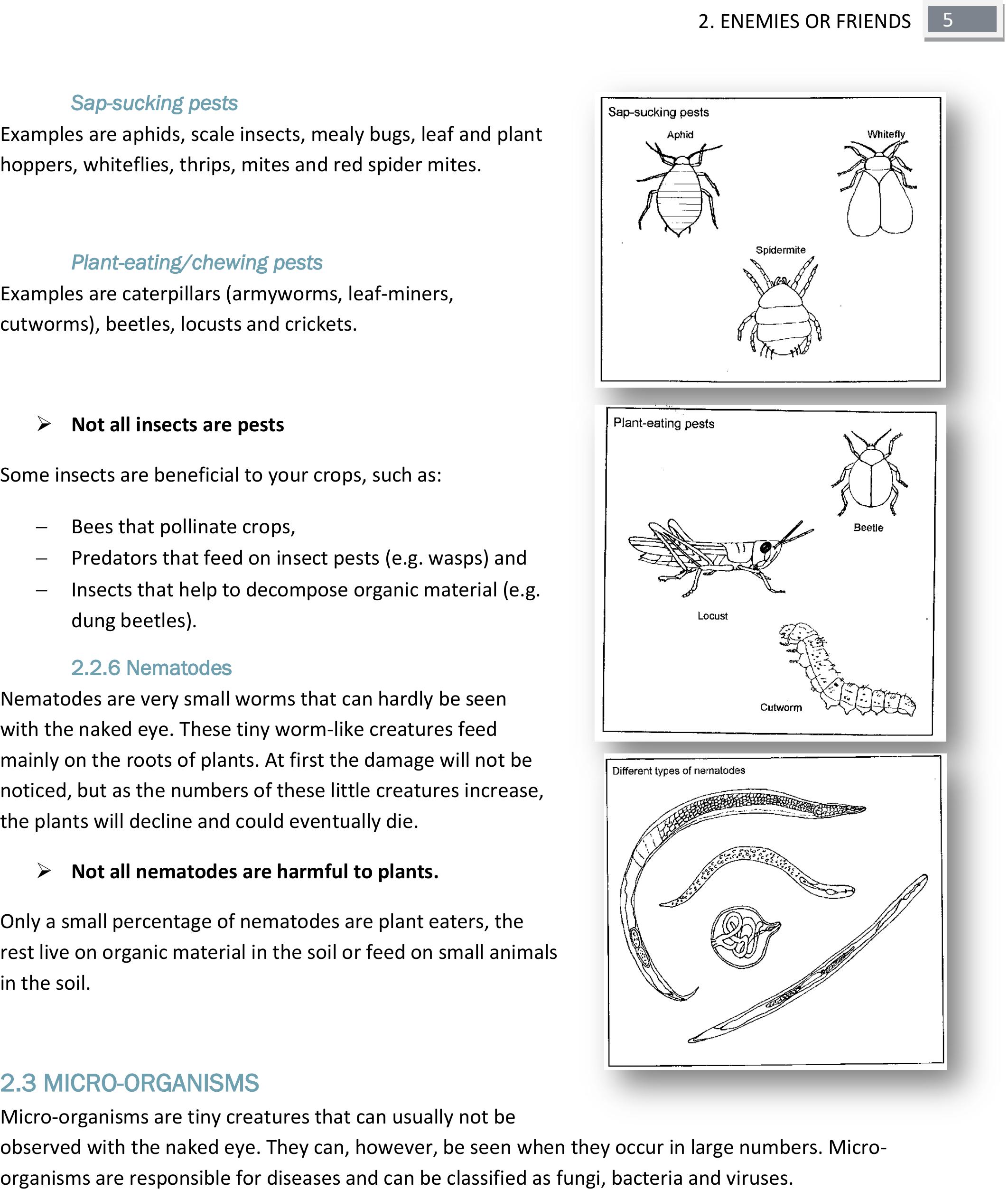
5
2. ENEMIES OR FRIENDS
Sap-sucking pests
Examples are aphids, scale insects, mealy bugs, leaf and plant
hoppers, whiteflies, thrips, mites and red spider mites.
Plant-eating/chewing pests
Examples are caterpillars (armyworms, leaf-miners,
cutworms), beetles, locusts and crickets.
Not all insects are pests
Some insects are beneficial to your crops, such as:
Bees that pollinate crops,
Predators that feed on insect pests (e.g. wasps) and
Insects that help to decompose organic material (e.g.
dung beetles).
2.2.6 Nematodes
Nematodes are very small worms that can hardly be seen
with the naked eye. These tiny worm-like creatures feed
mainly on the roots of plants. At first the damage will not be
noticed, but as the numbers of these little creatures increase,
the plants will decline and could eventually die.
Not all nematodes are harmful to plants.
Only a small percentage of nematodes are plant eaters, the
rest live on organic material in the soil or feed on small animals
in the soil.
2.3 MICRO-ORGANISMS
Micro-organisms are tiny creatures that can usually not be
observed with the naked eye. They can, however, be seen when they occur in large numbers. Micro-
organisms are responsible for diseases and can be classified as fungi, bacteria and viruses.
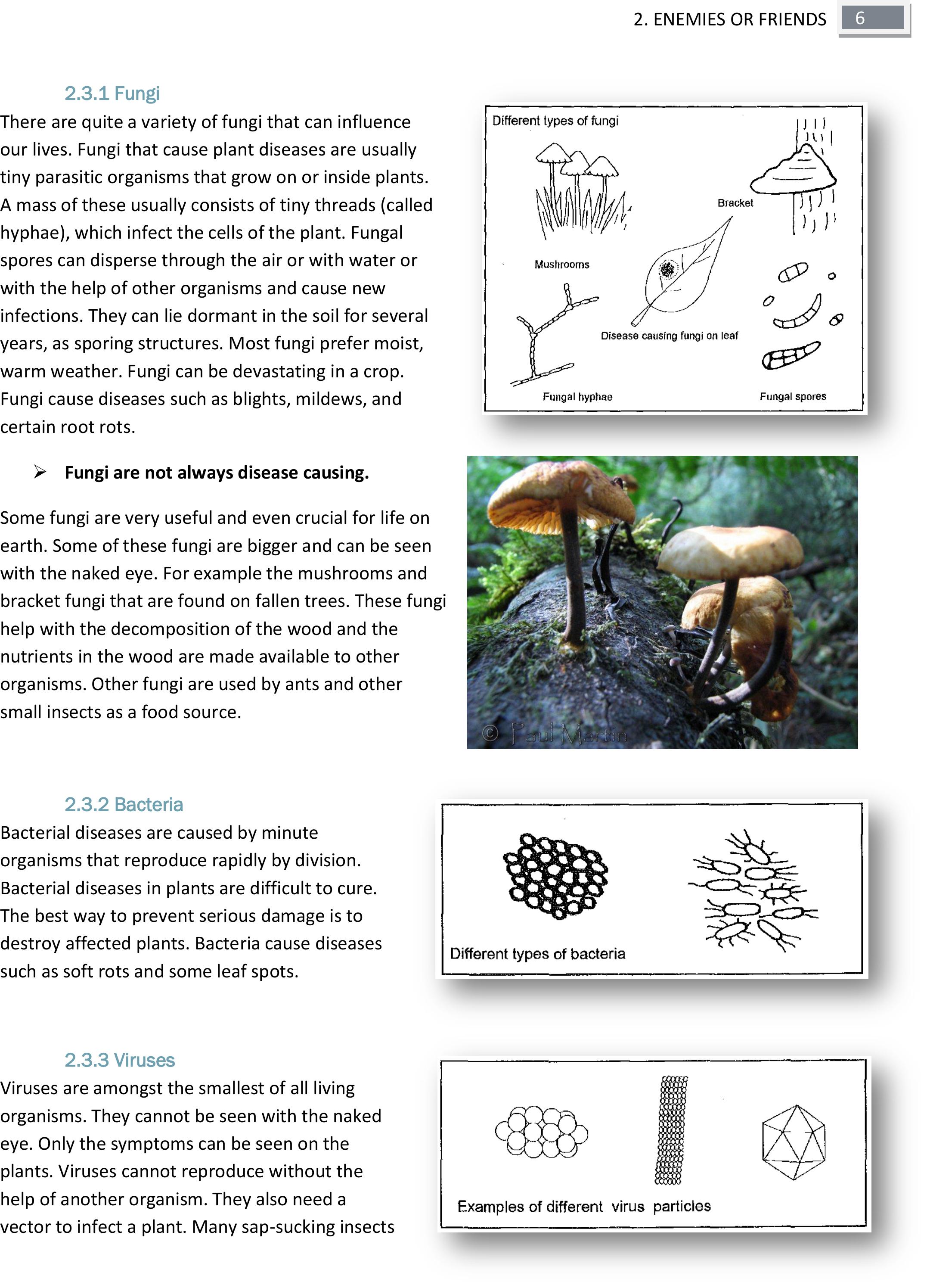
6
2. ENEMIES OR FRIENDS
2.3.1 Fungi
There are quite a variety of fungi that can influence
our lives. Fungi that cause plant diseases are usually
tiny parasitic organisms that grow on or inside plants.
A mass of these usually consists of tiny threads (called
hyphae), which infect the cells of the plant. Fungal
spores can disperse through the air or with water or
with the help of other organisms and cause new
infections. They can lie dormant in the soil for several
years, as sporing structures. Most fungi prefer moist,
warm weather. Fungi can be devastating in a crop.
Fungi cause diseases such as blights, mildews, and
certain root rots.
Fungi are not always disease causing.
Some fungi are very useful and even crucial for life on
earth. Some of these fungi are bigger and can be seen
with the naked eye. For example the mushrooms and
bracket fungi that are found on fallen trees. These fungi
help with the decomposition of the wood and the
nutrients in the wood are made available to other
organisms. Other fungi are used by ants and other
small insects as a food source.
2.3.2 Bacteria
Bacterial diseases are caused by minute
organisms that reproduce rapidly by division.
Bacterial diseases in plants are difficult to cure.
The best way to prevent serious damage is to
destroy affected plants. Bacteria cause diseases
such as soft rots and some leaf spots.
2.3.3 Viruses
Viruses are amongst the smallest of all living
organisms. They cannot be seen with the naked
eye. Only the symptoms can be seen on the
plants. Viruses cannot reproduce without the
help of another organism. They also need a
vector to infect a plant. Many sap-sucking insects

7
2. ENEMIES OR FRIENDS
act as vectors. Generally there are no cures for virus diseases and affected plants should be destroyed.
Not all micro-organisms are pests
Many species of micro-organisms can help plants by feeding them. Such beneficial micro-organisms are
encouraged by healthy soils.
2.4 DIAGNOSING PLANT PROBLEMS
Before symptoms can be treated it is important to have an idea of the
cause of the problem. Damage to plants can be caused by insects,
animals, micro-organisms, natural causes (such as drought and
nutritional disorders), or by chemical injury.
It is not always easy to identify the cause of a problem immediately
from visual symptoms. There are hundreds of causes of plant problems
and two or more of the causes might produce the same symptoms. A
single visual symptom can also be caused by a number of different
problems.
Identification of the cause of a particular symptom requires years of experience, but guidelines can be
given to make it easier.
2.4.1 Ways to identify insect damage
SYMPTOMS
CAUSE
Ragged leaves, holes in wood, fruit or seed. Mining
on leaves. Wilted or dead plants. The presence of
larvae
Chewing insects
Foliage and fruit are off-colour and sometimes a bit
distorted
Sucking insects removing sap and cell contents
from the plant and injecting toxins into the plant
Black sooty substance covering the leaves, twigs,
branches and fruit. The sooty cover can easily be
removed by rubbing the leaves.
Honeydew excreted by certain insects leads to
the growth of sooty mould. Leaves suffocate and
plants do not grow well.
Galls on leaves, twigs, buds and roots
Gall forming insects
Scars on stems, twigs, bark and fruit. Fruit is
sometimes infested with larvae
Insects laying their eggs in or on the plants.
The symptoms of
diseases are often
similar to nutrient
deficiencies and can
easily be confused.
It is important to
note that the
following are
rough guidelines.
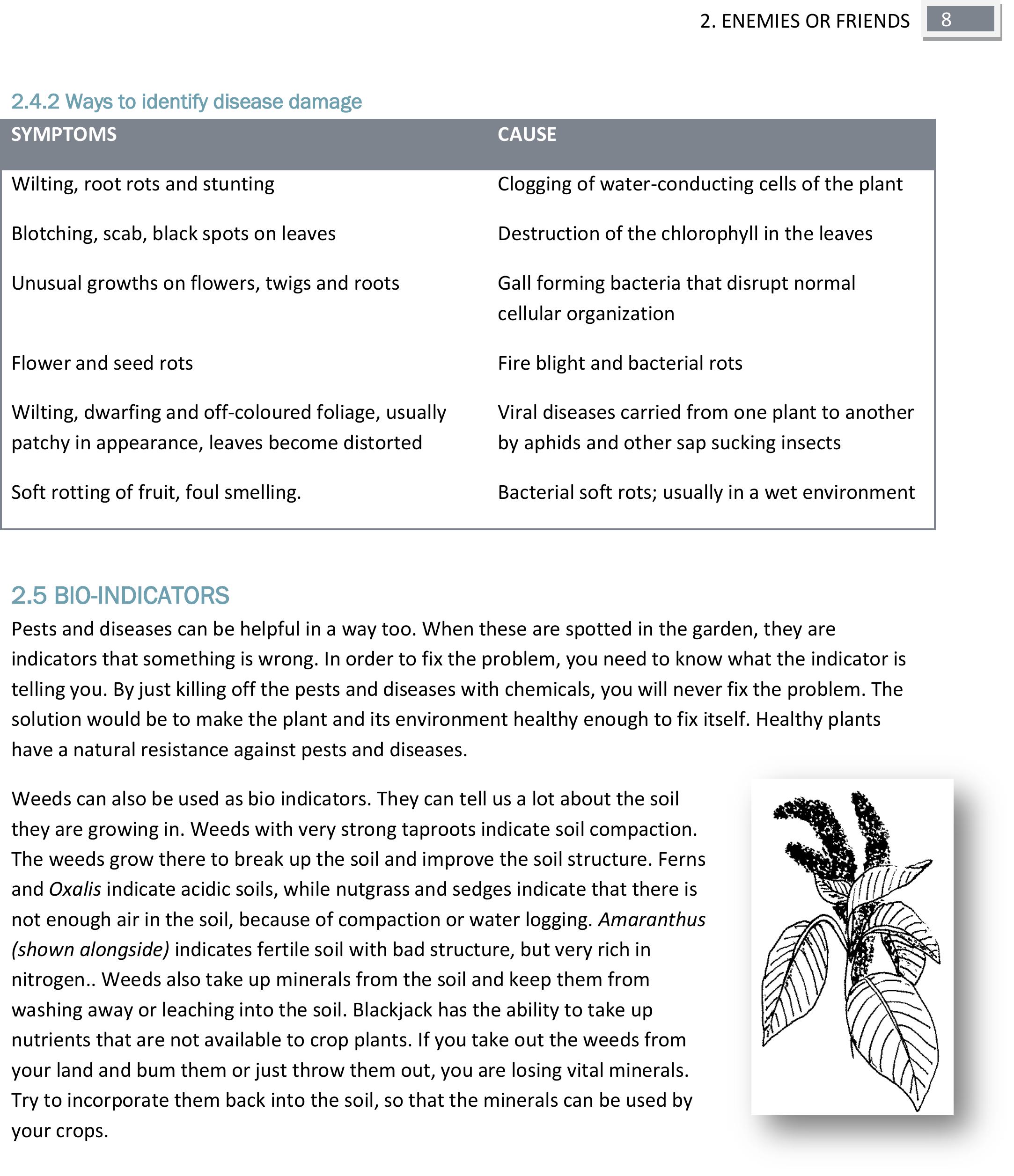
8
2. ENEMIES OR FRIENDS
2.4.2 Ways to identify disease damage
SYMPTOMS
CAUSE
Wilting, root rots and stunting
Clogging of water-conducting cells of the plant
Blotching, scab, black spots on leaves
Destruction of the chlorophyll in the leaves
Unusual growths on flowers, twigs and roots
Gall forming bacteria that disrupt normal
cellular organization
Flower and seed rots
Fire blight and bacterial rots
Wilting, dwarfing and off-coloured foliage, usually
patchy in appearance, leaves become distorted
Viral diseases carried from one plant to another
by aphids and other sap sucking insects
Soft rotting of fruit, foul smelling.
Bacterial soft rots; usually in a wet environment
2.5 BlO-INDICATORS
Pests and diseases can be helpful in a way too. When these are spotted in the garden, they are
indicators that something is wrong. In order to fix the problem, you need to know what the indicator is
telling you. By just killing off the pests and diseases with chemicals, you will never fix the problem. The
solution would be to make the plant and its environment healthy enough to fix itself. Healthy plants
have a natural resistance against pests and diseases.
Weeds can also be used as bio indicators. They can tell us a lot about the soil
they are growing in. Weeds with very strong taproots indicate soil compaction.
The weeds grow there to break up the soil and improve the soil structure. Ferns
and Oxalis indicate acidic soils, while nutgrass and sedges indicate that there is
not enough air in the soil, because of compaction or water logging. Amaranthus
(shown alongside) indicates fertile soil with bad structure, but very rich in
nitrogen.. Weeds also take up minerals from the soil and keep them from
washing away or leaching into the soil. Blackjack has the ability to take up
nutrients that are not available to crop plants. If you take out the weeds from
your land and bum them or just throw them out, you are losing vital minerals.
Try to incorporate them back into the soil, so that the minerals can be used by
your crops.

9
3. CONTROL
3. CONTROL
3.1 THE CHOICE
Pests and diseases have been with us from the very beginning. We read about them in the Bible: moths,
ants, mosquitoes, rust, locusts, etc. The war against pests was declared about 10 000 years ago, when
we first got serious about agriculture. In those times the only means of controlling pests was
mechanically. Our ancestors probably used the sun, water, mud, ashes, salt and their bodies (hands, feet
and voice) to control these pests.
As humanity developed, so control methods developed. As a result we have access to highly
technological solutions such as specialised chemicals and hybrid and genetically modified plant varieties.
Because of all this new technology, many of the older methods of controlling pests have been forgotten
or neglected. The purpose of this book
is to make people aware of the
existence of these forgotten processes
and remedies to control pests.
Unlike our ancestors, we have a
choice today of how to control the
pests in our gardens. The choice lies
between chemical control and natural
control; or a combination of both.
3.2 CHEMICAL CONTROL
In this book chemical control will refer to synthetic
pesticides, which includes any pesticide that is man-
made in a chemical laboratory or factory.
Chemical control of agricultural pests originated during
the First World War. The chemicals that were discovered
and used were later introduced into agriculture to be
used to control pests.
Chemical control has its advantages. It is effective and
results can be expected almost immediately. In many
cases only the positive side of chemicals is shown tothe
farmers, and the farmers regard chemicals as a “quick
fix” to all their problems.
Many chemicals are not suitable for use by ordinary small-scale farmers, for the following reasons:
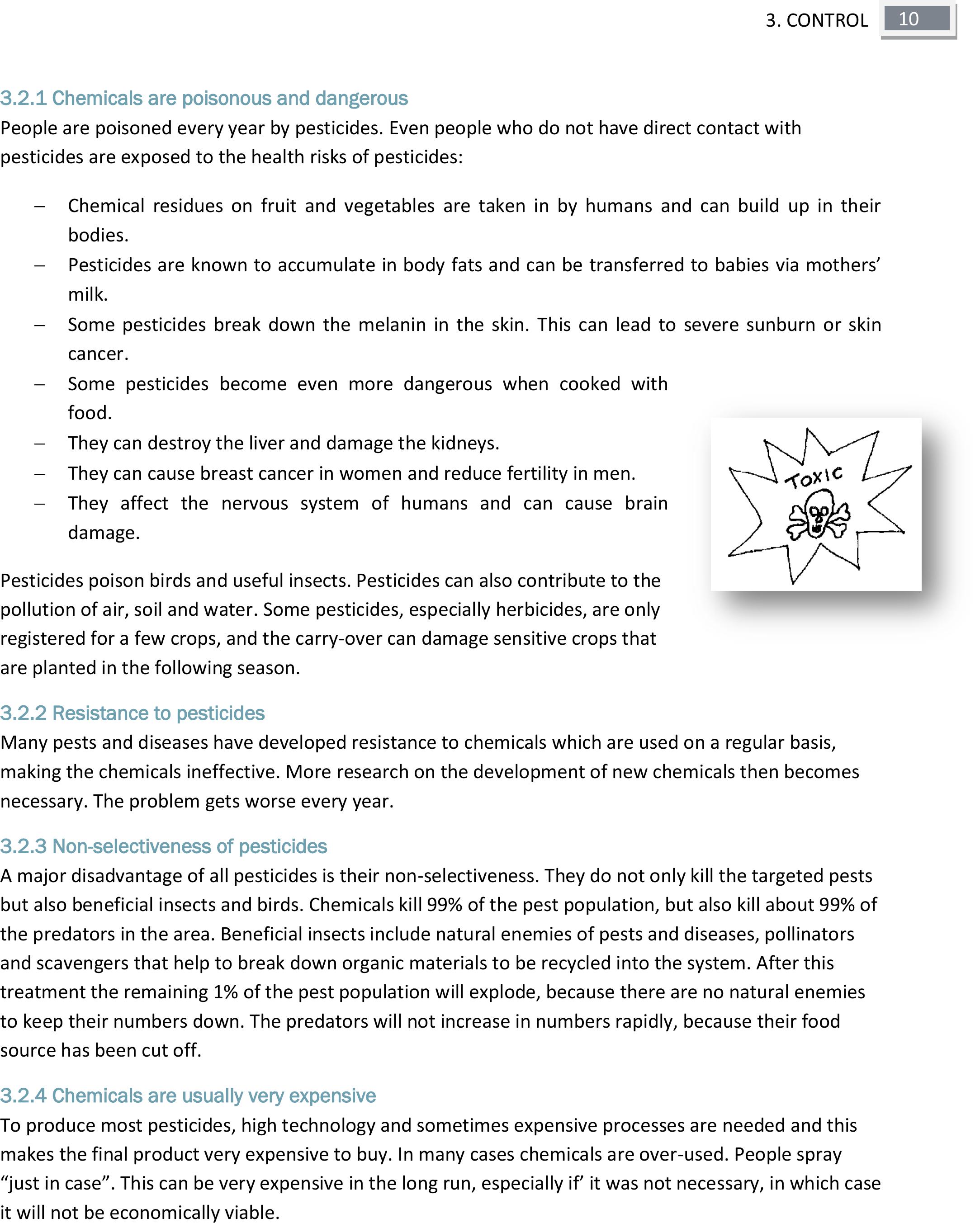
10
3. CONTROL
3.2.1 Chemicals are poisonous and dangerous
People are poisoned every year by pesticides. Even people who do not have direct contact with
pesticides are exposed to the health risks of pesticides:
Chemical residues on fruitand vegetables are takenin by humans and can build up in their
bodies.
Pesticides are known to accumulate in body fats and can be transferred to babies via mothers’
milk.
Some pesticides break down the melanin in the skin. This can lead to severe sunburn or skin
cancer.
Some pesticides become even more dangerous when cooked with
food.
They can destroy the liver and damage the kidneys.
They can cause breast cancer in women and reduce fertility in men.
They affect the nervous system of humans and can cause brain
damage.
Pesticides poison birds and useful insects. Pesticides can also contribute to the
pollution of air, soil and water. Some pesticides, especially herbicides, are only
registered for a few crops, and the carry-over can damage sensitive crops that
are planted in the following season.
3.2.2 Resistance to pesticides
Many pests and diseases have developed resistance to chemicals which are used on a regular basis,
making the chemicals ineffective. More research on the development of new chemicals then becomes
necessary. The problem gets worse every year.
3.2.3 Non-selectiveness of pesticides
A major disadvantage of all pesticides is their non-selectiveness. They do not only kill the targeted pests
but also beneficial insects and birds. Chemicals kill 99% of the pest population, but also kill about 99% of
the predators in the area. Beneficial insects include natural enemies of pests and diseases, pollinators
and scavengers that help to break down organic materials to be recycled into the system. After this
treatment the remaining 1% of the pest population will explode, because there are no natural enemies
to keep their numbers down. The predators will not increase in numbers rapidly, because their food
source has been cut off.
3.2.4 Chemicals are usually very expensive
To produce most pesticides, high technology and sometimes expensive processes are needed and this
makes the final product very expensive to buy. In many cases chemicals are over-used. People spray
“justin case”. This can be very expensive in the long run, especially if’ it was not necessary, in which case
it will not be economically viable.
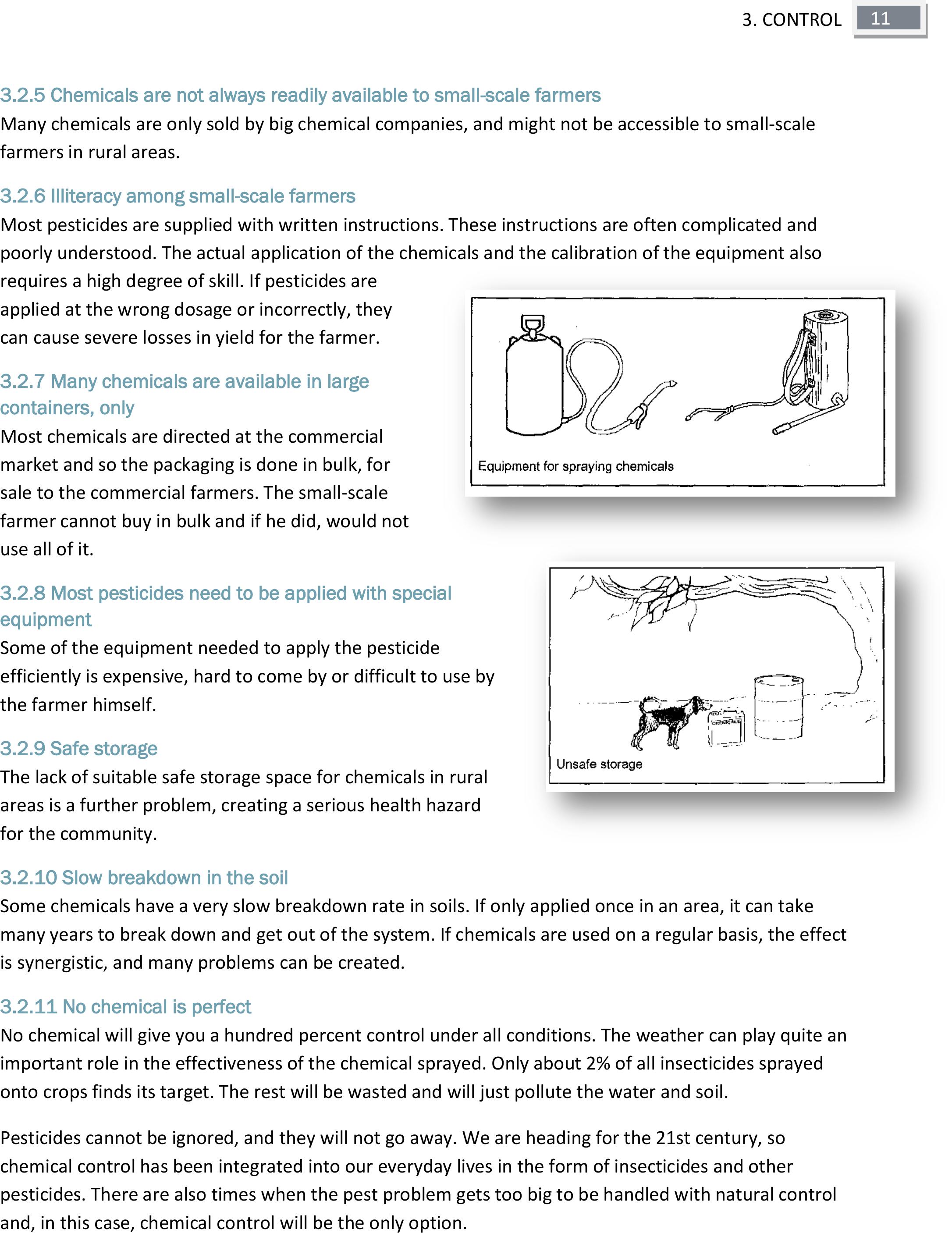
11
3. CONTROL
3.2.5 Chemicals are not always readily available to small-scale farmers
Many chemicals are only sold by big chemical companies, and might not be accessible to small-scale
farmers in rural areas.
3.2.6 Illiteracy among small-scale farmers
Most pesticides are supplied with written instructions. These instructions are often complicated and
poorly understood. The actual application of the chemicals and the calibration of the equipment also
requires a high degree of skill. If pesticides are
applied at the wrong dosage or incorrectly, they
can cause severe losses in yield for the farmer.
3.2.7 Many chemicals are available in large
containers, only
Most chemicals are directed at the commercial
market and so the packaging is done in bulk, for
sale to the commercial farmers. The small-scale
farmer cannot buy in bulk and if he did, would not
use all of it.
3.2.8 Most pesticides need to be applied with special
equipment
Some of the equipment needed to apply the pesticide
efficiently is expensive, hard to come by or difficult to use by
the farmer himself.
3.2.9 Safe storage
The lack of suitable safe storage space for chemicals in rural
areas is a further problem, creating a serious health hazard
for the community.
3.2.10 Slow breakdown in the soil
Some chemicals have a very slow breakdown rate in soils. If only applied once in an area, it can take
many years to break down and get out of the system. If chemicals are used on a regular basis, the effect
is synergistic, and many problems can be created.
3.2.11 No chemical is perfect
No chemical will give you a hundred percent control under all conditions. The weather can play quite an
important role in the effectiveness of the chemical sprayed. Only about 2% of all insecticides sprayed
onto crops finds its target. The rest will be wasted and will just pollute the water and soil.
Pesticides cannot be ignored, and they will not go away. We are heading for the 21st century, so
chemical control has been integrated into our everyday lives in the form of insecticides and other
pesticides. There are also times when the pest problem gets too big to be handled with natural control
and, in this case, chemical control will be the only option.
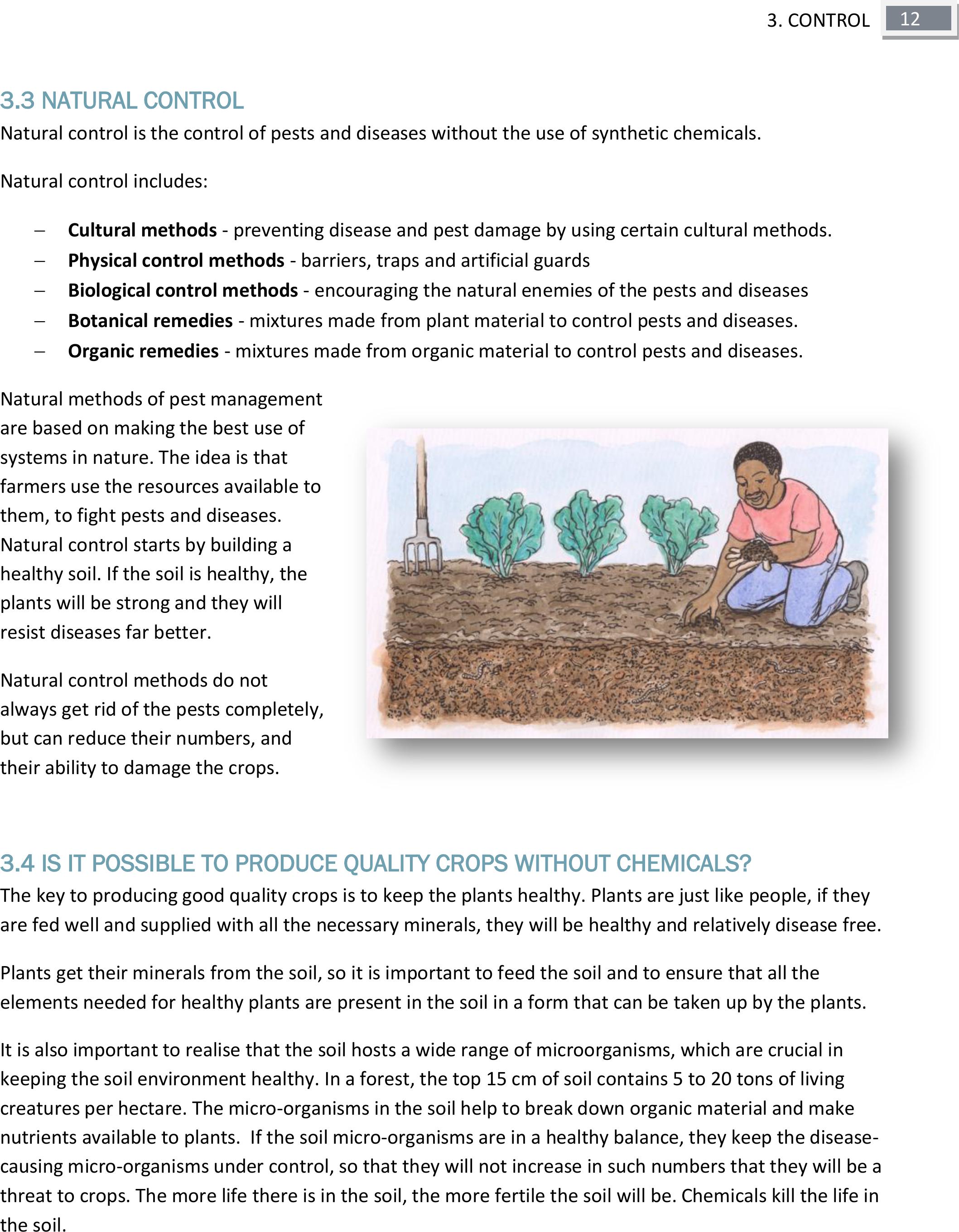
12
3. CONTROL
3.3 NATURAL CONTROL
Natural control is the control of pests and diseases without the use of synthetic chemicals.
Natural control includes:
Cultural methods - preventing disease and pest damage by using certain cultural methods.
Physical control methods - barriers, traps and artificial guards
Biological control methods - encouraging the natural enemies of the pests and diseases
Botanical remedies - mixtures made from plant material to control pests and diseases.
Organic remedies - mixtures made from organic material to control pests and diseases.
Natural methods of pest management
are based on making the best use of
systems in nature. The idea is that
farmers use the resources available to
them, to fight pests and diseases.
Natural control starts by building a
healthy soil. If the soil is healthy, the
plants will be strong and they will
resist diseases far better.
Natural control methods do not
always get rid of the pests completely,
but can reduce their numbers, and
their ability to damage the crops.
3.4 IS IT POSSIBLE TO PRODUCE QUALITY CROPS WITHOUT CHEMICALS?
The key to producing good quality crops is to keep the plants healthy. Plants are just like people, if they
are fed well and supplied with all the necessary minerals, they will be healthy and relatively disease free.
Plants get their minerals from the soil, so it is important to feed the soil and to ensure that all the
elements needed for healthy plants are present in the soil in a form that can be taken up by the plants.
It is also important to realise that the soil hosts a wide range of microorganisms, which are crucial in
keeping the soil environment healthy. In a forest, the top 15 cm of soil contains 5 to 20 tons of living
creatures per hectare. The micro-organisms in the soil help to break down organic material and make
nutrients available to plants. If the soil micro-organisms are in a healthy balance, they keep the disease-
causing micro-organisms under control, so that they will not increase in such numbers that they will be a
threat to crops. The more life there is in the soil, the more fertile the soil will be. Chemicals kill the life in
the soil.

13
4 PREVENTION
4 PREVENTION
Prevention is always better than cure. By creating a healthy environment, you will not have serious
problems with pests and diseases. It is possible to create a pest disease-discouraging environment. The
following methods should help with this:
Garden sanitation
Timing of planting
Plant spacing
Mixed cropping
Correct plant feeding
Resistant or tolerant varieties of plants
Cultivation methods
Protecting crops with other plants
4.1 GARDEN SANITATION
By removing infected plant material, the chance of disease spread is reduced. Infested crop residues can
be burned (although this loses valuable organic matter), or used in compost heaps (as long as they are
hot enough to kill the disease causing organisms).
Try not to walk on infested soil and then on a new, clean land. The soil clinging to your boots or feet can
carry the disease causing organism to the new field and other crops can be infected.
When working with infected plants, clean your hands and the implements used in the infected field,
before moving on to a new area. Implements, boots and your hands can spread several of the diseases
from one plant to another. Do not wash your hands in the same water that is used to water the plants.
You will spread diseases.
4.2 TIMING OF PLANTING
Many pests and diseases can be avoided by planting crops when the pests and diseases are dormant or
relatively inactive. This is called escape cropping. Generally, cold weather reduces pest and disease
activity. It is important to know if the crops can survive the cold, if this method is to be used.By knowing
the pest’s life cycle, one can partially prevent trouble with pests. Early planting and the use of fast
maturing varieties are well known strategies for endemic pests to an area. Early cultivation of seedlings
also gives the crop an advantage over weeds.
It is also important to plant crops in the season that they prefer. Planting crops out of season places
them under stress and makes them more susceptible to pest attacks and diseases.

14
4 PREVENTION
4.3 PLA NT SPACING
Plant spacing can make a big difference, especially in the case of
diseases. Most diseases like wet conditions. If plants are sown
too close together, the incidence of certain diseases can be
increased or favoured.
4.3 MIXED CROPPING
Crops can be inter-cropped to gain advantages such as sharing
of:
Nutrients through different uptake by different crop
types.
Space above the ground. Different crops have different growth habits , some growing closer to
the ground some growing taller and can share space in this way.
Space below the ground. Different crops have different shapes and sizes of root systems and can
thus easily share space underground
Sunlight. Some crops are shade tolerant and need cooler conditions than others and can be
planted under the partial canopies of larger crops.
4.4 CORRECT PLANT FEEDING
Pests tend to attack weak plants. It is claimed that plants
grown on rich organic soils are more healthy and less
attractive to pests. One of the most important minerals that
helps prevent attack from pests and diseases is calcium. This
mineral reinforces the cell walls in the plant itself, thus
making it more difficult to be penetrated by insects and
diseases.
4.4.1 Natural fertilizers
Composted plant wastes
Animal manure
Green manure
Earthworms
Composted plant wastes
Compost is the best organic fertilizer, because it contains all
16 elements or plant nutrients in the proper amounts.
Compost discourages a number of diseases and it balances
the soil by neutralizing it. If diseased materials are composted
well, they are safe to use in the garden, as disease-causing
An old gardener’s way of
getting rid of potato scab was
to incorporate grass clippings in
the soil. The increase in organic
matter increased the hyper-
parasitic and competitive fungi
and led to a lower incidence of
disease in the soil
How to make a compost heap
Dig out a square in the soil. Put layers of
coarse plant material at the bottom of the
hole for drainage and air circulation.
Make layers with plant material and soil and
bone meal and cover the top with soil. Put
some hay right at the top of the heap. This
will ensure that the heap won’t dry out.
Turn compost heaps on a regular basis to
ensure good composting throughout the
heap. Leave to compost.
Compost can be used as a mulch as well. A
mulch is very effective in keeping the soil
moist and in restricting weeds.
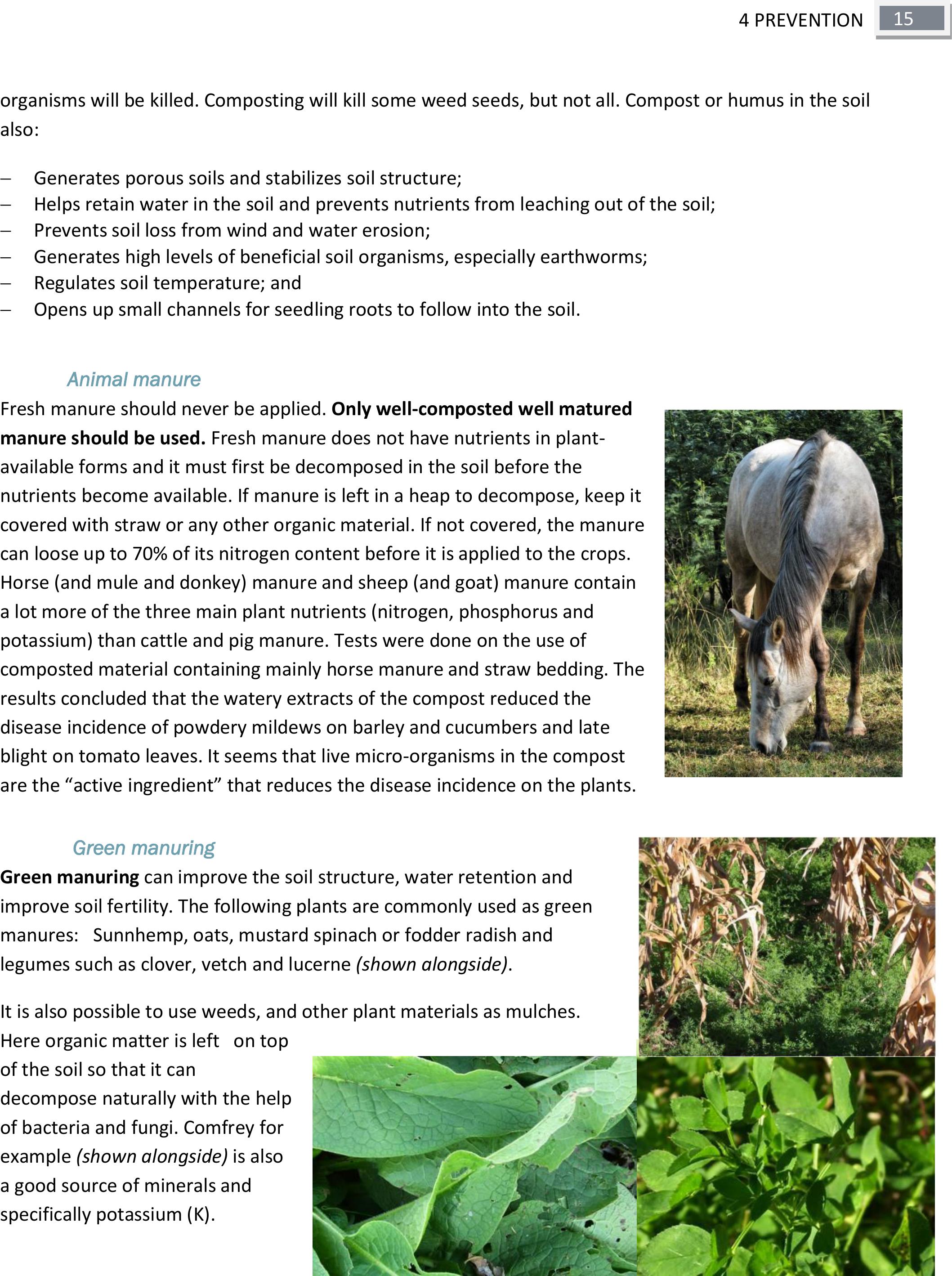
15
4 PREVENTION
organisms will be killed. Composting will kill some weed seeds, but not all. Compost or humus in the soil
also:
Generates porous soils and stabilizes soil structure;
Helps retain water in the soil and prevents nutrients from leaching out of the soil;
Prevents soil loss from wind and water erosion;
Generates high levels of beneficial soil organisms, especially earthworms;
Regulates soil temperature; and
Opens up small channels for seedling roots to follow into the soil.
Animal manure
Fresh manure should never be applied. Only well-composted well matured
manure should be used. Fresh manure does not have nutrients in plant-
available forms and it must first be decomposed in the soil before the
nutrients become available. If manure is left in a heap to decompose, keep it
covered with straw or any other organic material. If not covered, the manure
can loose up to 70% of its nitrogen content before it is applied to the crops.
Horse (and mule and donkey) manure and sheep (and goat) manure contain
a lot more of the three main plant nutrients (nitrogen, phosphorus and
potassium) than cattle and pig manure. Tests were done on the use of
composted material containing mainly horse manure and straw bedding. The
results concluded that the watery extracts of the compost reduced the
disease incidence of powdery mildews on barley and cucumbers and late
blight on tomato leaves. It seems that live micro-organisms in the compost
are the “active ingredient” that reduces the disease incidence on the plants.
Green manuring
Green manuring can improve the soil structure, water retention and
improve soil fertility. The following plants are commonly used as green
manures: Sunnhemp, oats, mustard spinach or fodder radish and
legumes such as clover, vetch and lucerne (shown alongside).
It is also possible to use weeds, and other plant materials as mulches.
Here organic matter is left on top
of the soil so that it can
decompose naturally with the help
of bacteria and fungi. Comfrey for
example (shown alongside) is also
a good source of minerals and
specifically potassium (K).

16
4 PREVENTION
Earthworms
Normal digging of the soil can help with the drainage and
aeration of the soil. There are natural diggers in the soil-
earthworms. They can dig just as well or even better than
humans can dig with tools. Ploughing with tractors and hoes
can kill many of these natural diggers and will compact the
soil.
A way of increasing the fertility of the soil is to add
earthworms to it. Earthworms serve several vital functions,
including:
Breaking down dead organic matter in the soil.
Burrowing and moving under the soil, thus naturally
aerating the soil.
Providing a source of nutrients to other
organisms when they die.
It is also possible and well worth while to farm with
earth worms to create vermin-compost and vermi-
compost liquid manure for use in gardens (shown
alongside).The worms create compost from the
organic matter, including kitchen scraps, crop residues,
manure or almost any other organic material.
4.5 RESISTANT OR TOLERANT VARIETIES OF PLANTS
In nature it is the law that the fittest will survive. Weak plants are eliminated by pests and diseases. In
traditional farming systems, farmers saved the seeds from the best plants in the crop to use for the next
season. By doing this the farmers speeded up the natural selection process of nature. They also selected
the best varieties for their specific area. Plants adapt to the environment they are grown in and produce
Making vermi-compost
To start, use any dark container with a
drainage hole at the bottom. Place a layer of
stones and paper at the bottom. Fill around
half the container with grass, manure,
kitchen scarps and other organic matter.
Place the worms in the container and
continue to fill. Make sure this mixture
remains moist and continue to ‘feed’ the
wormery on a weekly basis. In time
everything will be reduced to thick crumbly
humus. The worms move to the top of the
bin/container and the humus can be
removed from the bottom, with a few
worms, and used in garden beds.
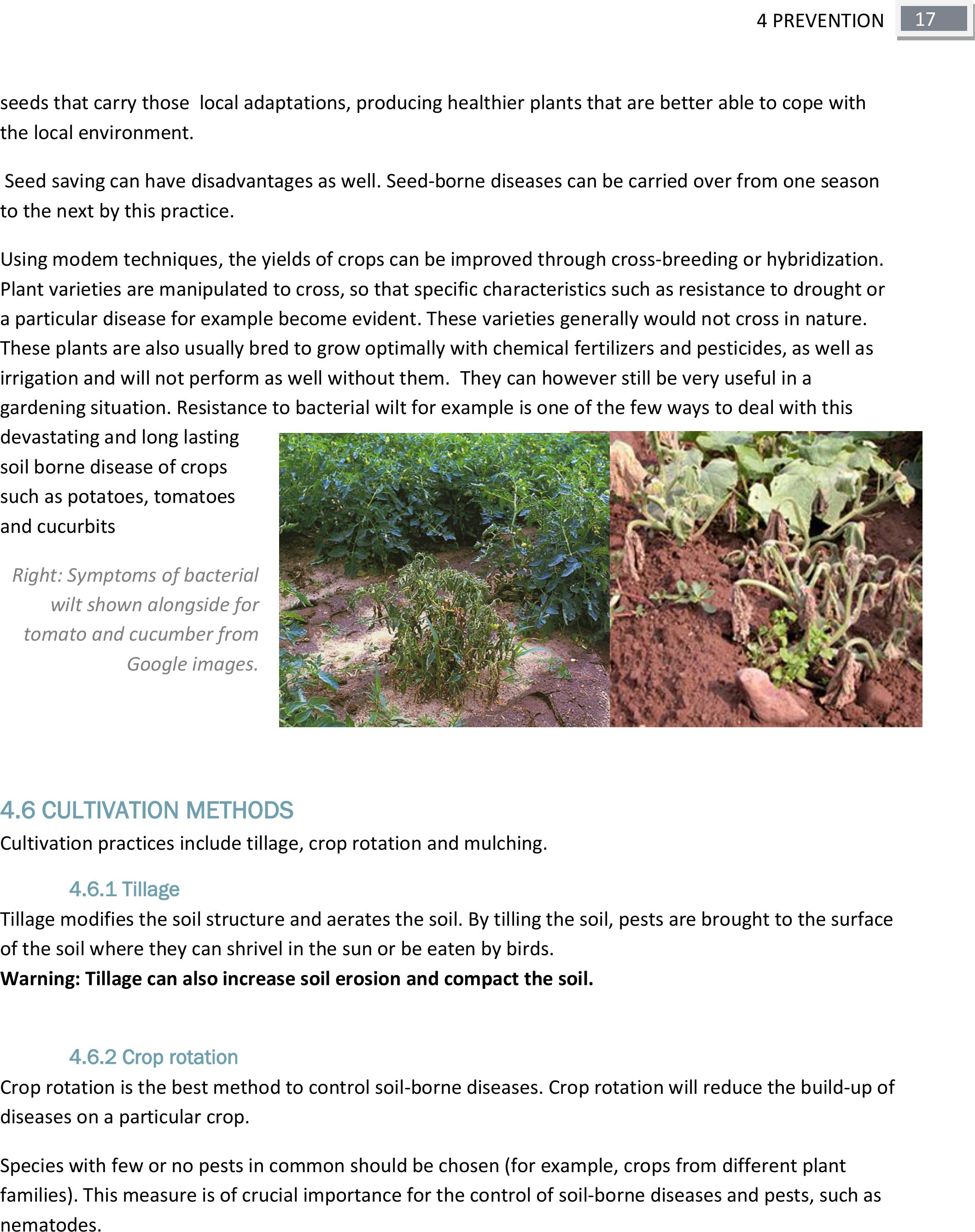
17
4 PREVENTION
seeds that carry those local adaptations, producing healthier plants that are better able to cope with
the local environment.
Seed saving can have disadvantages as well. Seed-borne diseases can be carried over from one season
to the next by this practice.
Using modem techniques, the yields of crops can be improved through cross-breeding or hybridization.
Plant varieties are manipulated to cross, so that specific characteristics such as resistance to drought or
a particular disease for example become evident. These varieties generally would not cross in nature.
These plants are also usually bred to grow optimally with chemical fertilizers and pesticides, as well as
irrigation and will not perform as well without them. They can however still be very useful in a
gardening situation. Resistance to bacterial wilt for example is one of the few ways to deal with this
devastating and long lasting
soil borne disease of crops
such as potatoes, tomatoes
and cucurbits
Right: Symptoms of bacterial
wilt shown alongside for
tomato and cucumber from
Google images.
4.6 CULTIVATION METHODS
Cultivation practices include tillage, crop rotation and mulching.
4.6.1 Tillage
Tillage modifies the soil structure and aerates the soil. By tilling the soil, pests are brought to the surface
of the soil where they can shrivel in the sun or be eaten by birds.
Warning: Tillage can also increase soil erosion and compact the soil.
4.6.2 Crop rotation
Crop rotation is the best method to control soil-borne diseases. Crop rotation will reduce the build-up of
diseases on a particular crop.
Species with few or no pests in common should be chosen (for example, crops from different plant
families). This measure is of crucial importance for the control of soil-borne diseases and pests, such as
nematodes.

18
4 PREVENTION
If crops like sunflower, sorghum and other small grain crops are planted and the residues, after
harvesting, are left on the surface to decompose they release natural herbicides called allelochemicals
that can be very useful in weed control. Cover crops also suppress the growth of weeds.
Rotations can improve soil fertility, as different families add and subtract different things in their
growing cycle. Legumes add nitrogen to the soil, while potatoes break up the soil, and leave their fibrous
roots behind, opening up the soil structure.
Commercial farmers are beginning to see the value of crop rotation and they are getting higher yields in
their crops, especially when maize is planted in a field where legumes (such as soya beans) have been
growing for a season.
A four year rotation for vegetable crops is advisable. This system is shown below.
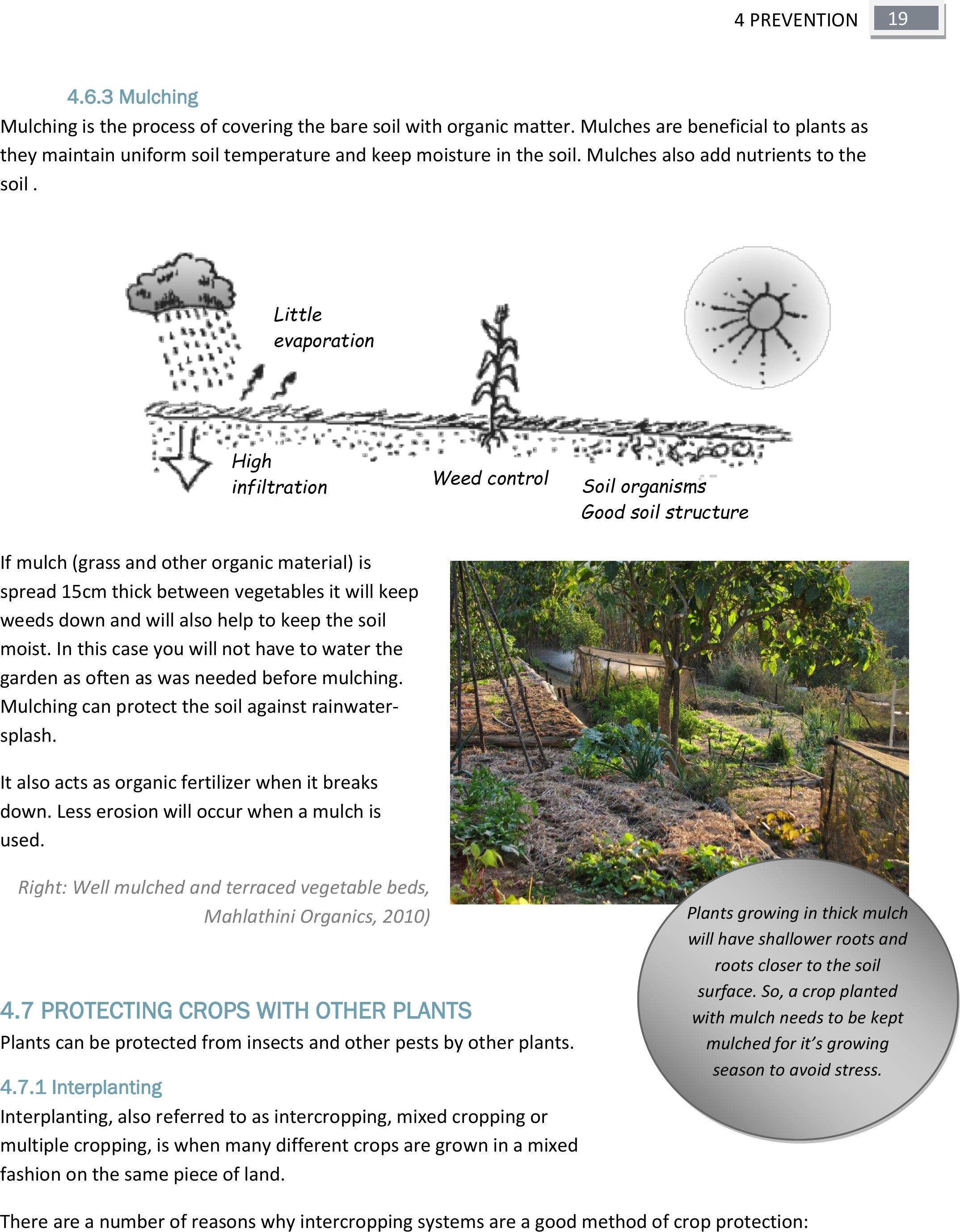
19
4 PREVENTION
4.6.3 Mulching
Mulching is the process of covering the bare soil with organic matter. Mulches are beneficial to plants as
they maintain uniform soil temperature and keep moisture in the soil. Mulches also add nutrients to the
soil .
If mulch (grass and other organic material) is
spread 15cm thick between vegetables it will keep
weeds down and will also help to keep the soil
moist. In this case you will not have to water the
garden as often as was needed before mulching.
Mulching can protect the soil against rainwater-
splash.
It also acts as organic fertilizer when it breaks
down. Less erosion will occur when a mulch is
used.
Right: Well mulched and terraced vegetable beds,
Mahlathini Organics, 2010)
4.7 PROTECTING CROPS WITH OTHER PLANTS
Plants can be protected from insects and other pests by other plants.
4.7.1 Interplanting
Interplanting, also referred to as intercropping, mixed cropping or
multiple cropping, is when many different crops are grown in a mixed
fashion on the same piece of land.
There are a number of reasons why intercropping systems are a good method of crop protection:
Little
evaporation
High
infiltration
Weed control
Soil organisms
Good soil structure
Plants growing in thick mulch
will have shallower roots and
roots closer to the soil
surface. So, a crop planted
with mulch needs to be kept
mulched for it’s growing
season to avoid stress.
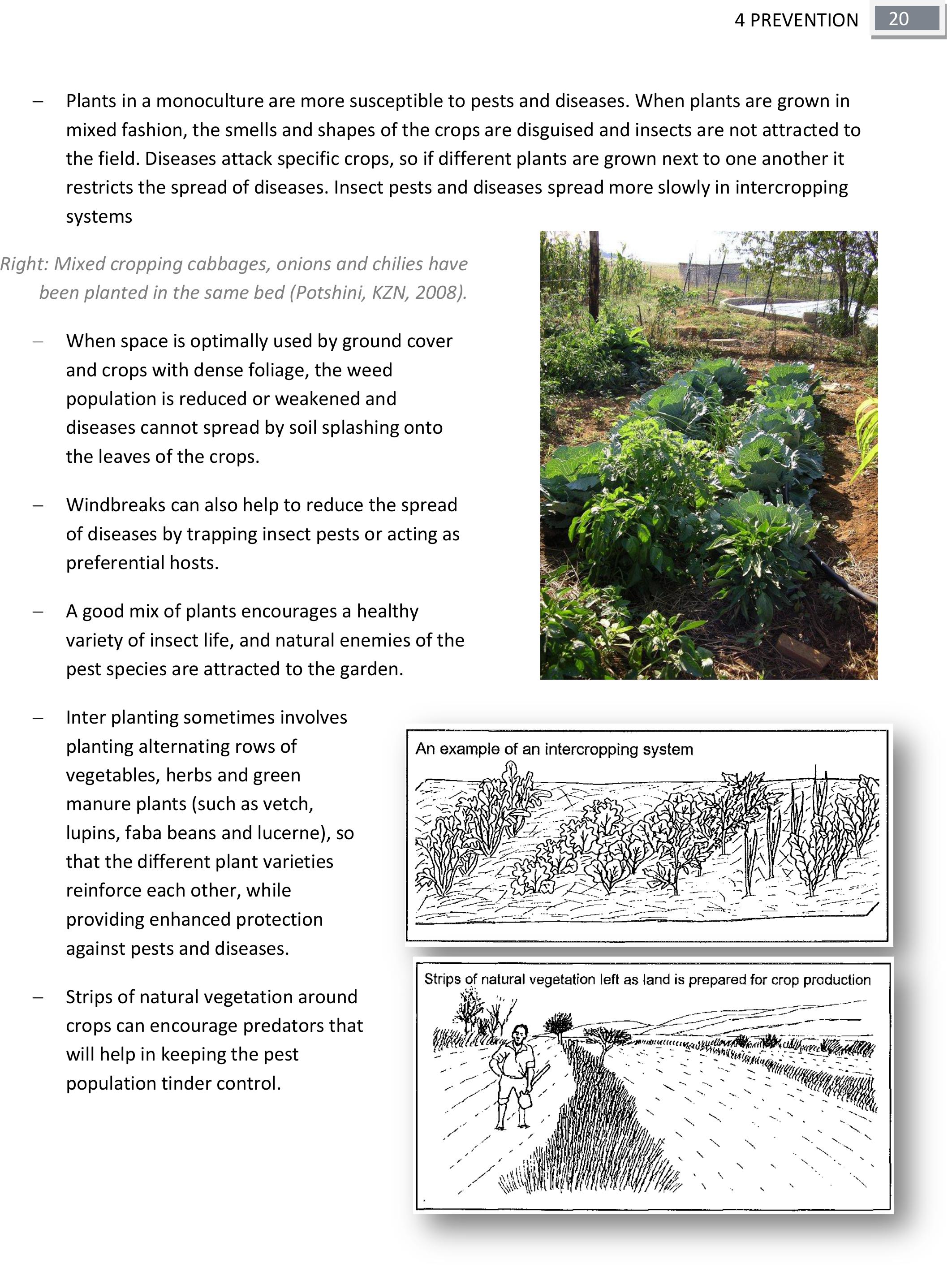
20
4 PREVENTION
Plants in a monoculture are more susceptible to pests and diseases. When plants are grown in
mixed fashion, the smells and shapes of the crops are disguised and insects are not attracted to
the field. Diseases attack specific crops, so if different plants are grown next to one another it
restricts the spread of diseases. Insect pests and diseases spread more slowly in intercropping
systems
Right: Mixed cropping cabbages, onions and chilies have
been planted in the same bed (Potshini, KZN, 2008).
When space is optimally used by ground cover
and crops with dense foliage, the weed
population is reduced or weakened and
diseases cannot spread by soil splashing onto
the leaves of the crops.
Windbreaks can also help to reduce the spread
of diseases by trapping insect pests or acting as
preferential hosts.
A good mix of plants encourages a healthy
variety of insect life, and natural enemies of the
pest species are attracted to the garden.
Inter planting sometimes involves
planting alternating rows of
vegetables, herbs and green
manure plants (such as vetch,
lupins, faba beans and lucerne), so
that the different plant varieties
reinforce each other, while
providing enhanced protection
against pests and diseases.
Strips of natural vegetation around
crops can encourage predators that
will help in keeping the pest
population tinder control.
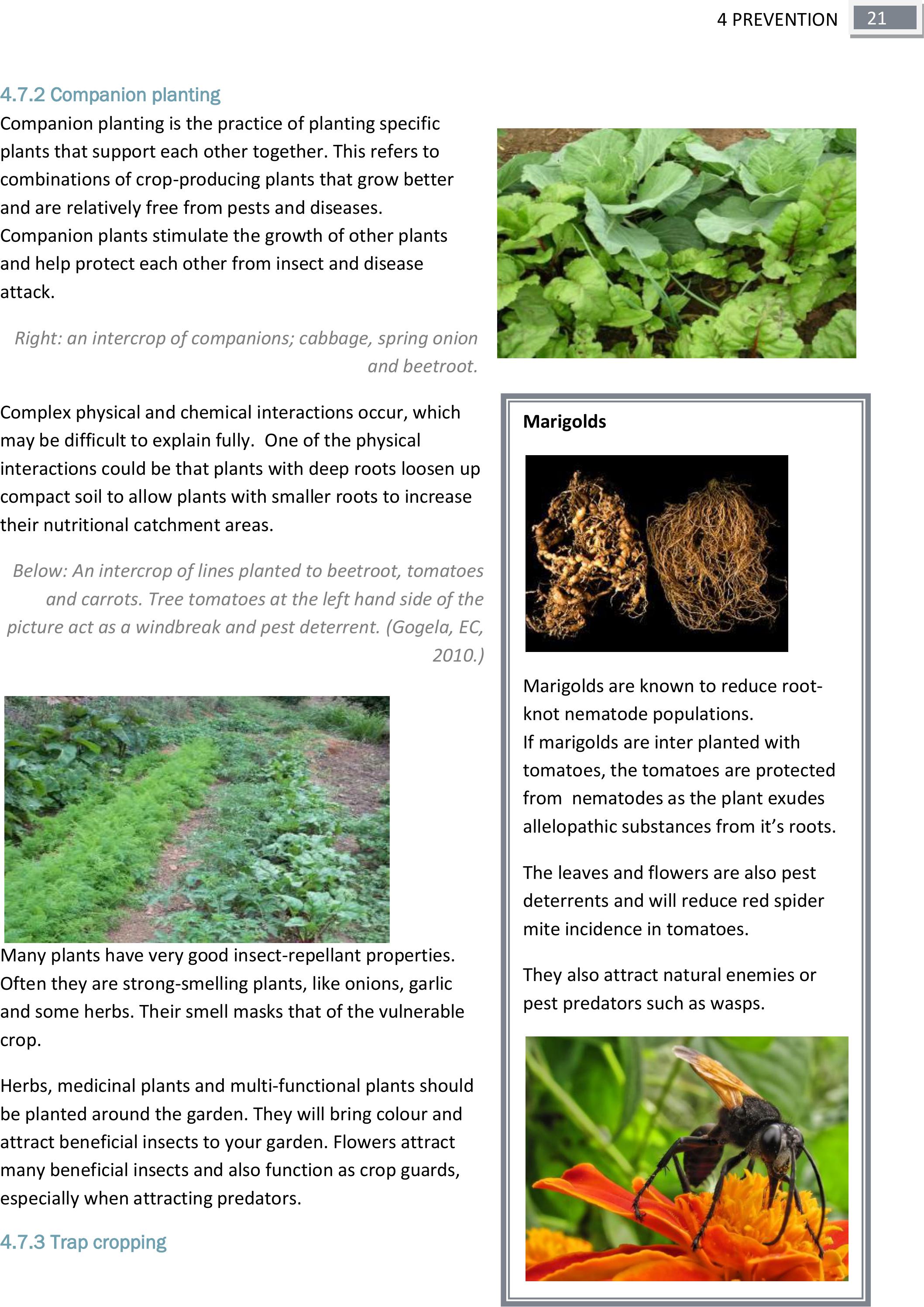
21
4 PREVENTION
4.7.2 Companion planting
Companion planting is the practice of planting specific
plants that support each other together. This refers to
combinations of crop-producing plants that grow better
and are relatively free from pests and diseases.
Companion plants stimulate the growth of other plants
and help protect each other from insect and disease
attack.
Right: an intercrop of companions; cabbage, spring onion
and beetroot.
Complex physical and chemical interactions occur, which
may be difficult to explain fully. One of the physical
interactions could be that plants with deep roots loosen up
compact soil to allow plants with smaller roots to increase
their nutritional catchment areas.
Below: An intercrop of lines planted to beetroot, tomatoes
and carrots. Tree tomatoes at the left hand side of the
picture act as a windbreak and pest deterrent. (Gogela, EC,
2010.)
Many plants have very good insect-repellant properties.
Often they are strong-smelling plants, like onions, garlic
and some herbs. Their smell masks that of the vulnerable
crop.
Herbs, medicinal plants and multi-functional plants should
be planted around the garden. They will bring colour and
attract beneficial insects to your garden. Flowers attract
many beneficial insects and also function as crop guards,
especially when attracting predators.
4.7.3 Trap cropping
Marigolds
Marigolds are known to reduce root-
knot nematode populations.
If marigolds are inter planted with
tomatoes, the tomatoes are protected
from nematodes as the plant exudes
allelopathic substances from it’s roots.
The leaves and flowers are also pest
deterrents and will reduce red spider
mite incidence in tomatoes.
They also attract natural enemies or
pest predators such as wasps.
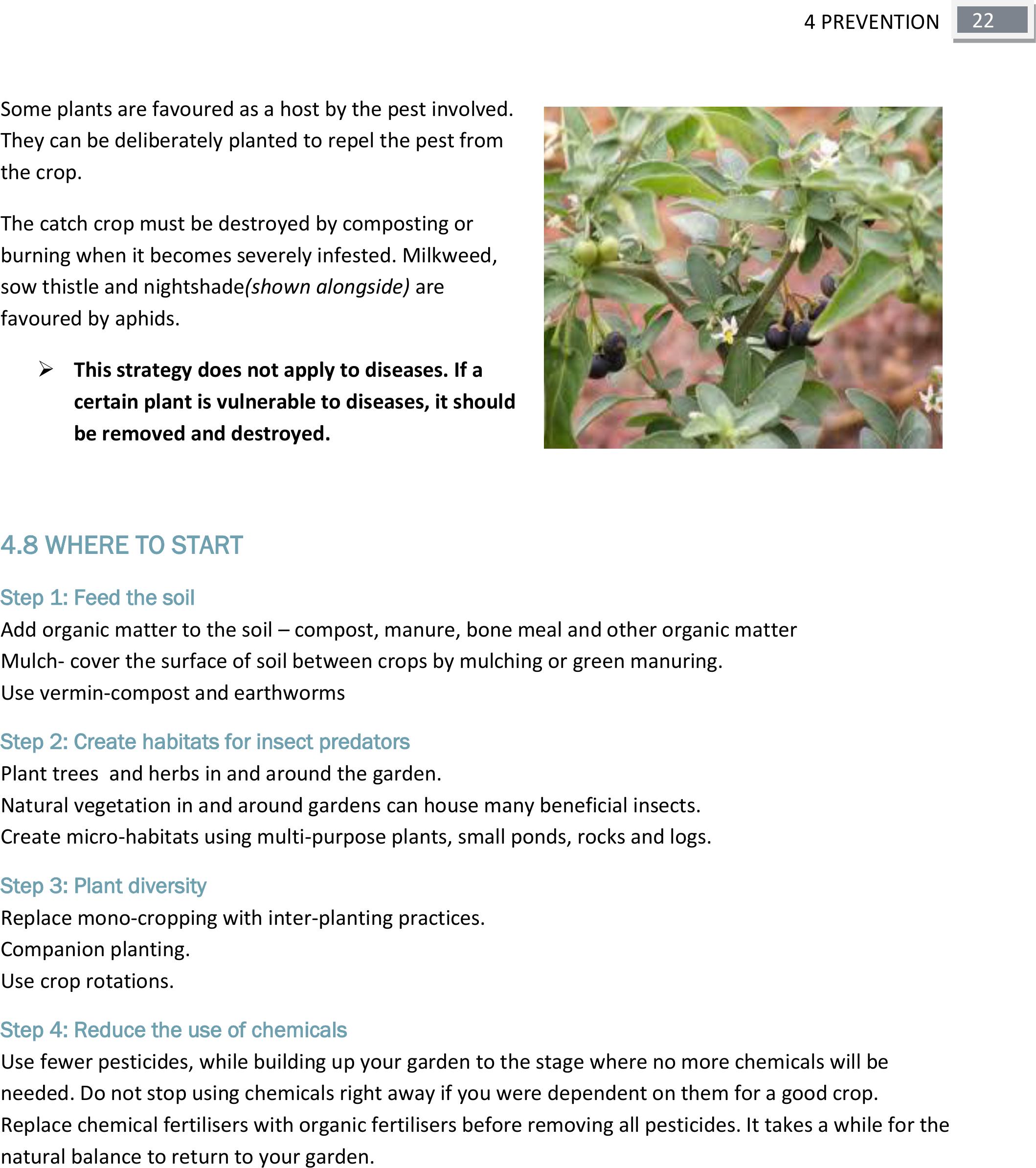
22
4 PREVENTION
Some plants are favoured as a host by the pest involved.
They can be deliberately planted to repel the pest from
the crop.
The catch crop must be destroyed by composting or
burning when it becomes severely infested. Milkweed,
sow thistle and nightshade(shown alongside) are
favoured by aphids.
This strategy does not apply to diseases. If a
certain plant is vulnerable to diseases, it should
be removed and destroyed.
4.8 WHERE TO START
Step 1: Feed the soil
Add organic matter to the soil –compost, manure, bone meal and other organic matter
Mulch- cover the surface of soil between crops by mulching or green manuring.
Use vermin-compost and earthworms
Step 2: Create habitats for insect predators
Plant trees and herbs in and around the garden.
Natural vegetation in and around gardens can house many beneficial insects.
Create micro-habitats using multi-purpose plants, small ponds, rocks and logs.
Step 3: Plant diversity
Replace mono-cropping with inter-planting practices.
Companion planting.
Use crop rotations.
Step 4: Reduce the use of chemicals
Use fewer pesticides, while building up your garden to the stage where no more chemicals will be
needed. Do not stop using chemicals right away if you were dependent on them for a good crop.
Replace chemical fertilisers with organic fertilisers before removing all pesticides. It takes a while for the
natural balance to return to your garden.
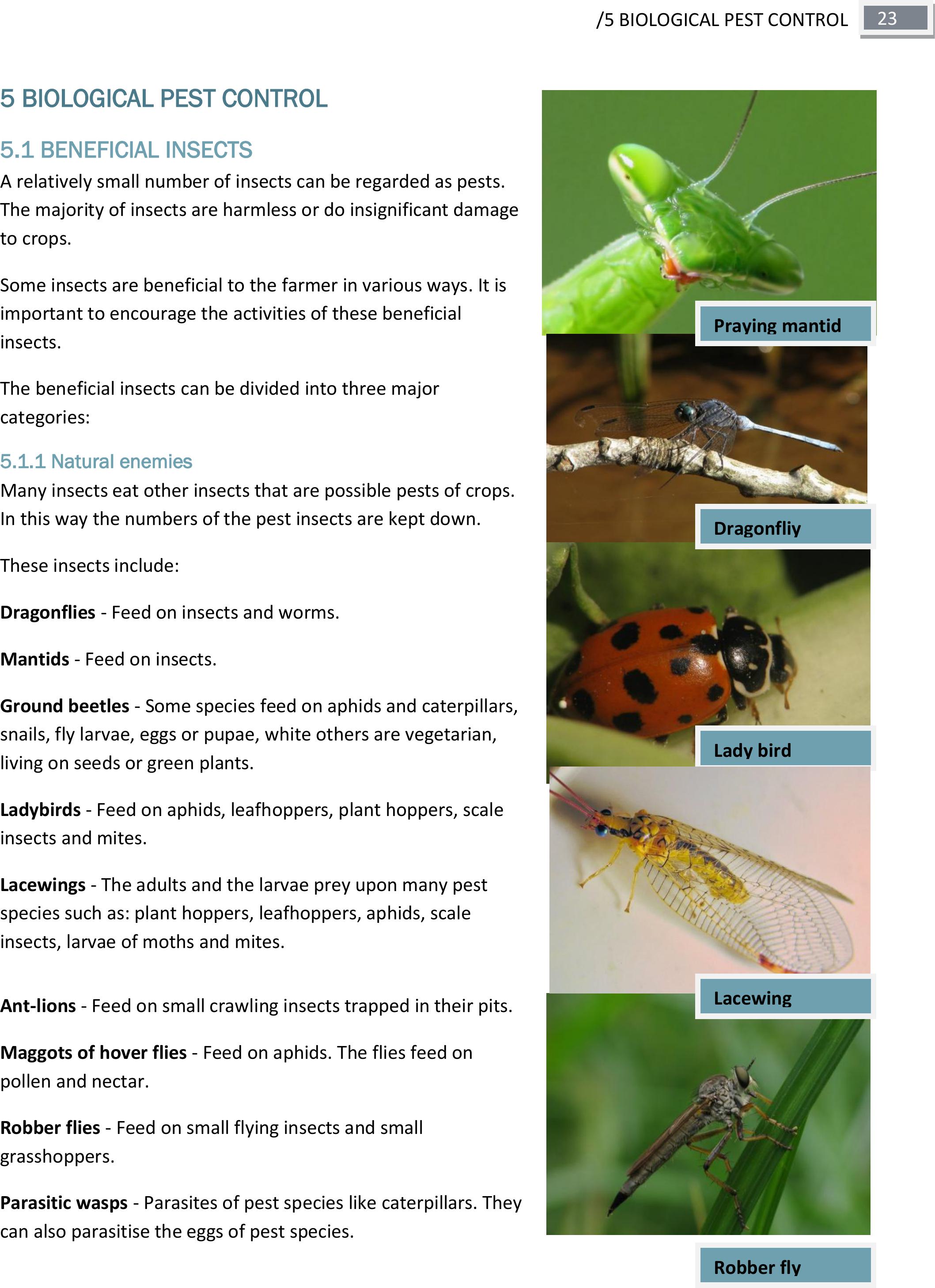
23
/5 BIOLOGICAL PEST CONTROL
5 BIOLOGICAL PEST CONTROL
5.1 BENEFICIAL INSECTS
A relatively small number of insects can be regarded as pests.
The majority of insects are harmless or do insignificant damage
to crops.
Some insects are beneficial to the farmer in various ways. It is
important to encourage the activities of these beneficial
insects.
The beneficial insects can be divided into three major
categories:
5.1.1 Natural enemies
Many insects eat other insects that are possible pests of crops.
In this way the numbers of the pest insects are kept down.
These insects include:
Dragonflies - Feed on insects and worms.
Mantids - Feed on insects.
Ground beetles - Some species feed on aphids and caterpillars,
snails, fly larvae, eggs or pupae, white others are vegetarian,
living on seeds or green plants.
Ladybirds - Feed on aphids, leafhoppers, plant hoppers, scale
insects and mites.
Lacewings - The adults and the larvae prey upon many pest
species such as: plant hoppers, leafhoppers, aphids, scale
insects, larvae of moths and mites.
Ant-lions - Feed on small crawling insects trapped in their pits.
Maggots of hover flies - Feed on aphids. The flies feed on
pollen and nectar.
Robber flies - Feed on small flying insects and small
grasshoppers.
Parasitic wasps - Parasites of pest species like caterpillars. They
can also parasitise the eggs of pest species.
Robber fly
Lady bird
Dragonfliy
Praying mantid
Lacewing
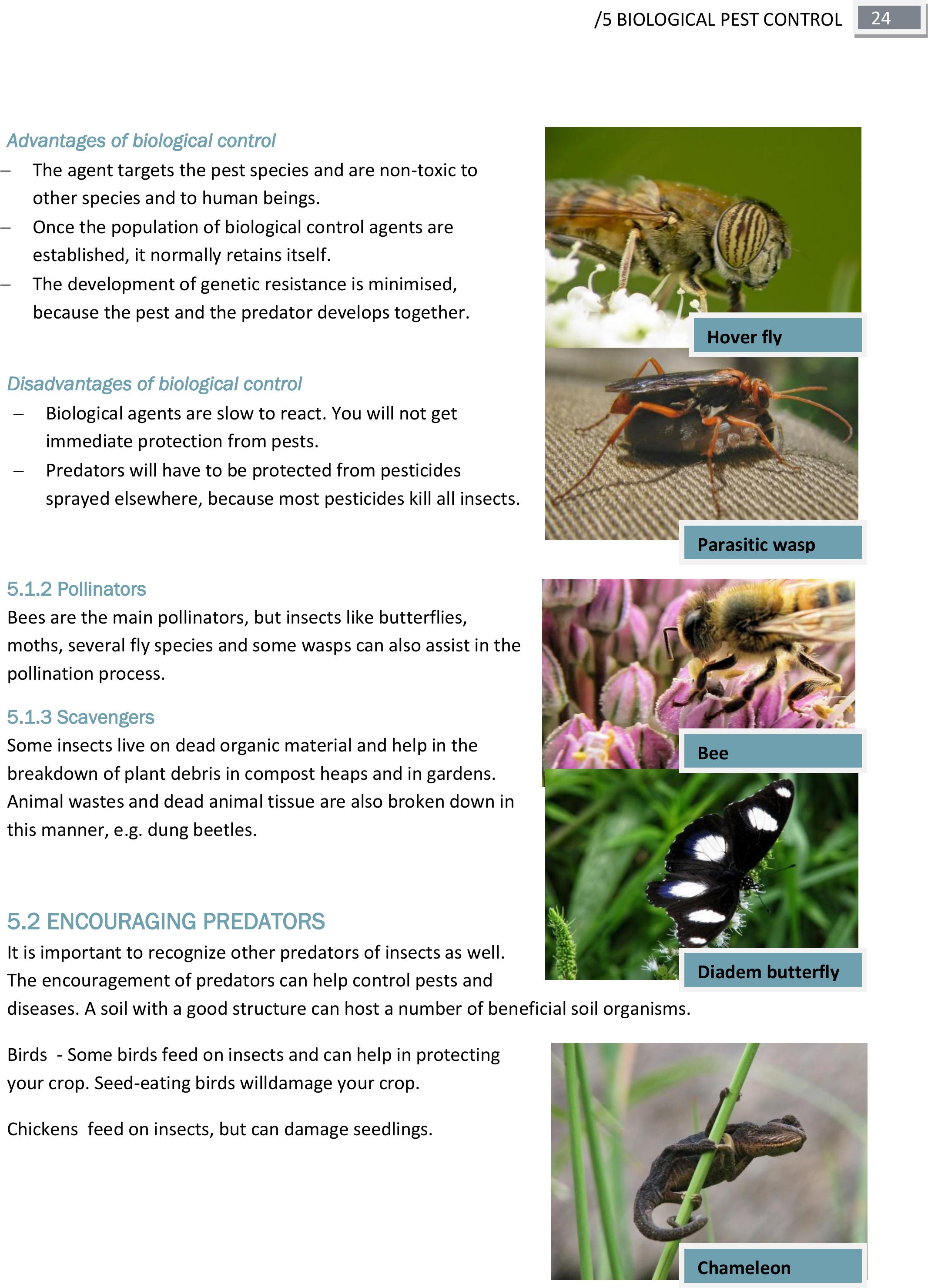
24
/5 BIOLOGICAL PEST CONTROL
Advantages of biological control
The agent targets the pest species and are non-toxic to
other species and to human beings.
Once the population of biological control agents are
established, it normally retains itself.
The development of genetic resistance is minimised,
because the pest and the predator develops together.
Disadvantages of biological control
Biological agents are slow to react. You will not get
immediate protection from pests.
Predators will have to be protected from pesticides
sprayed elsewhere, because most pesticides kill all insects.
5.1.2 Pollinators
Bees are the main pollinators, but insects like butterflies,
moths, several fly species and some wasps can also assist in the
pollination process.
5.1.3 Scavengers
Some insects live on dead organic material and help in the
breakdown of plant debris in compost heaps and in gardens.
Animal wastes and dead animal tissue are also broken down in
this manner, e.g. dung beetles.
5.2 ENCOURAGING PREDATORS
It is important to recognize other predators of insects as well.
The encouragement of predators can help control pests and
diseases. A soil with a good structure can host a number of beneficial soil organisms.
Birds - Some birds feed on insects and can help in protecting
your crop. Seed-eating birds willdamage your crop.
Chickensfeed on insects, but can damage seedlings.
Hover fly
Parasitic wasp
Bee
Diadem butterfly
Chameleon

25
/5 BIOLOGICAL PEST CONTROL
Geese are used for weeding of orchards. They will eat fruit that has dropped from the trees, preventing
them from rotting and contaminating other fruit.
Chameleons - Feed on insects that can damage your crops.
Lizards - Predators of insects.
Frogs are good for controlling insect pests.
Snakes eat rodents and insects.
Spiders eat insects. The majority of spiders are harmless to
human beings and they can be very helpful in keeping pests
away.
Spider
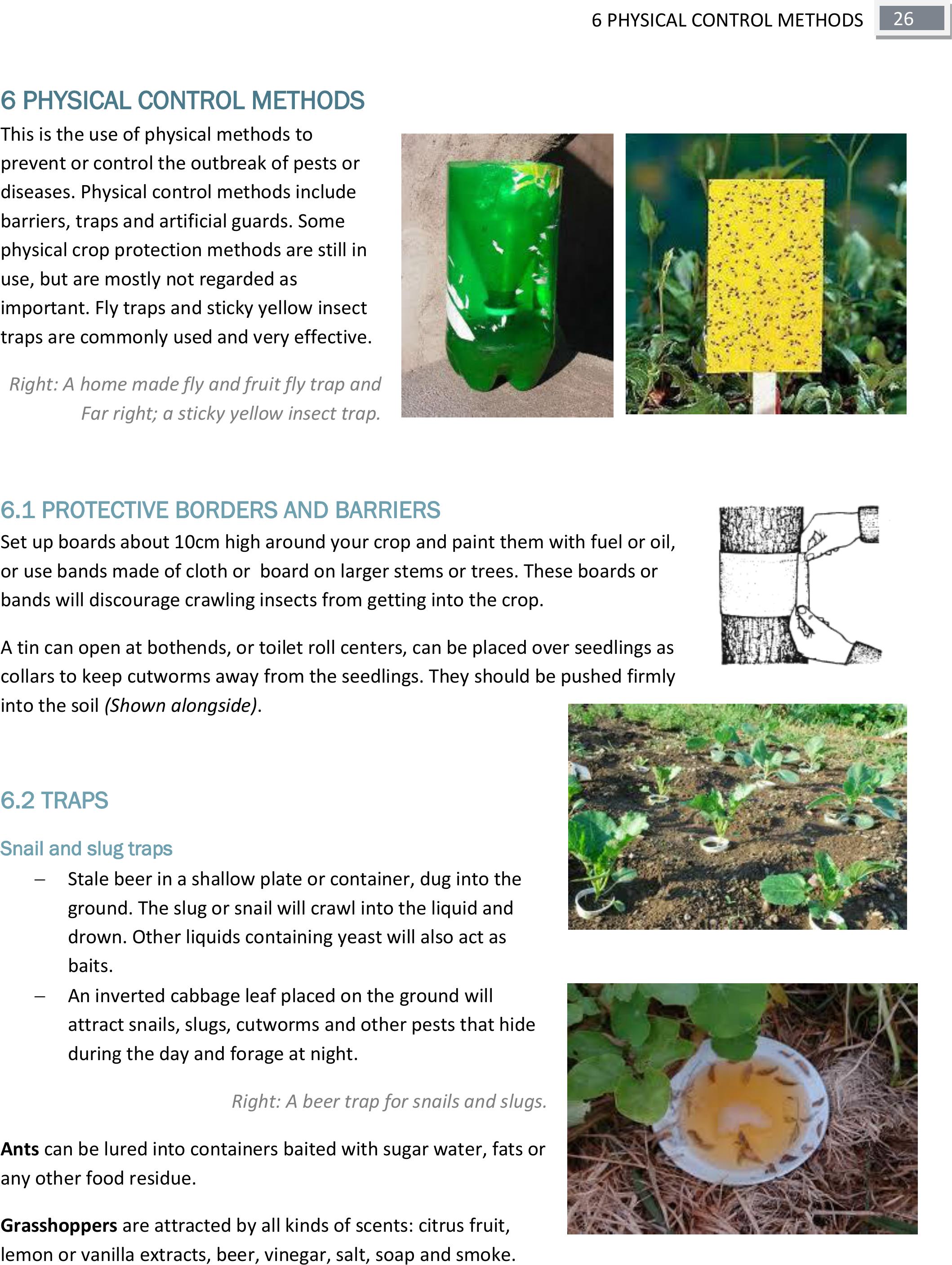
26
6 PHYSICAL CONTROL METHODS
6 PHYSICAL CONTROL METHODS
This is the use of physical methods to
prevent or control the outbreak of pests or
diseases. Physical control methods include
barriers, traps and artificial guards. Some
physical crop protection methods are still in
use, but are mostly not regarded as
important. Fly traps and sticky yellow insect
traps are commonly used and very effective.
Right: A home made fly and fruit fly trap and
Far right; a sticky yellow insect trap.
6.1 PROTECTIVE BORDERS AND BARRIERS
Set up boards about 10cm high around your crop and paint them with fuel or oil,
or use bands made of cloth or board on larger stems or trees. These boards or
bands will discourage crawling insects from getting into the crop.
A tin can open at bothends, or toilet roll centers, can be placed over seedlings as
collars to keep cutworms away from the seedlings. They should be pushed firmly
into the soil (Shown alongside).
6.2 TRAPS
Snail and slug traps
Stale beer in a shallow plate or container, dug into the
ground. The slug or snail will crawl into the liquid and
drown. Other liquids containing yeast will also act as
baits.
An inverted cabbage leaf placed on the ground will
attract snails, slugs, cutworms and other pests that hide
during the day and forage at night.
Right: A beer trap for snails and slugs.
Ants can be lured into containers baited with sugar water, fats or
any other food residue.
Grasshoppers are attracted by all kinds of scents: citrus fruit,
lemon or vanilla extracts, beer, vinegar, salt, soap and smoke.

27
6 PHYSICAL CONTROL METHODS
Cockroaches can be trapped by greasing the inner neck of a bottle baited with a raw potato or stale
beer.
Some flying insects can be attracted by light. Red, orange and yellow lights are avoided or ignored by
almost all insects.
Aphids, wasps and all kind of flies are attracted to the colour yellow. A trap can be made with a shallow
yellow-painted bowl, filled with soapy water.
Many insects are attracted to different colours. Try experimenting with
different colours. The collected pests can provide food for fish and chickens.
Rodents can be trapped in several ways. It is important to place the traps in
the regular paths of the rodents, and they must be attractive to the rodents,
so that they will investigate and not avoid the trap.
Rodents can be trapped and drowned when a large bucket is dug into the soil
and almost filled with water. About 3 cm below the top edge a line of peanut
butter is smeared. The animals fall into the trap and drown when trying to eat
the peanut butter.
6.3 ARTIFICIAL GUARDS
Black cotton threads can be used to scare birds away from crops. The threads
should be spread wide and loosely between the branches of fruit trees or around
crops. The birds will fly into the threads and be scared away, without being
trapped.
Scarecrows, cans and aluminium foil strips on strings,, as well as old cds’ can be
very effective in scaring birds and other animals away shown alongside). Care
should be taken to move them on a regular basis so that the animals don’t get
used to them.
Rodents and seed-eating birds can be scared by cutting out cardboard
silhouettes of owls or other birds of prey and suspending them over the
ground by attaching them to a rope and on top of a high pole. The shadow is
cast on the ground and is mistaken for the real thing (shown alongside).
Other physical control methods
Burning of infected plant material, ploughing back, etc., can be regarded as
physical control.
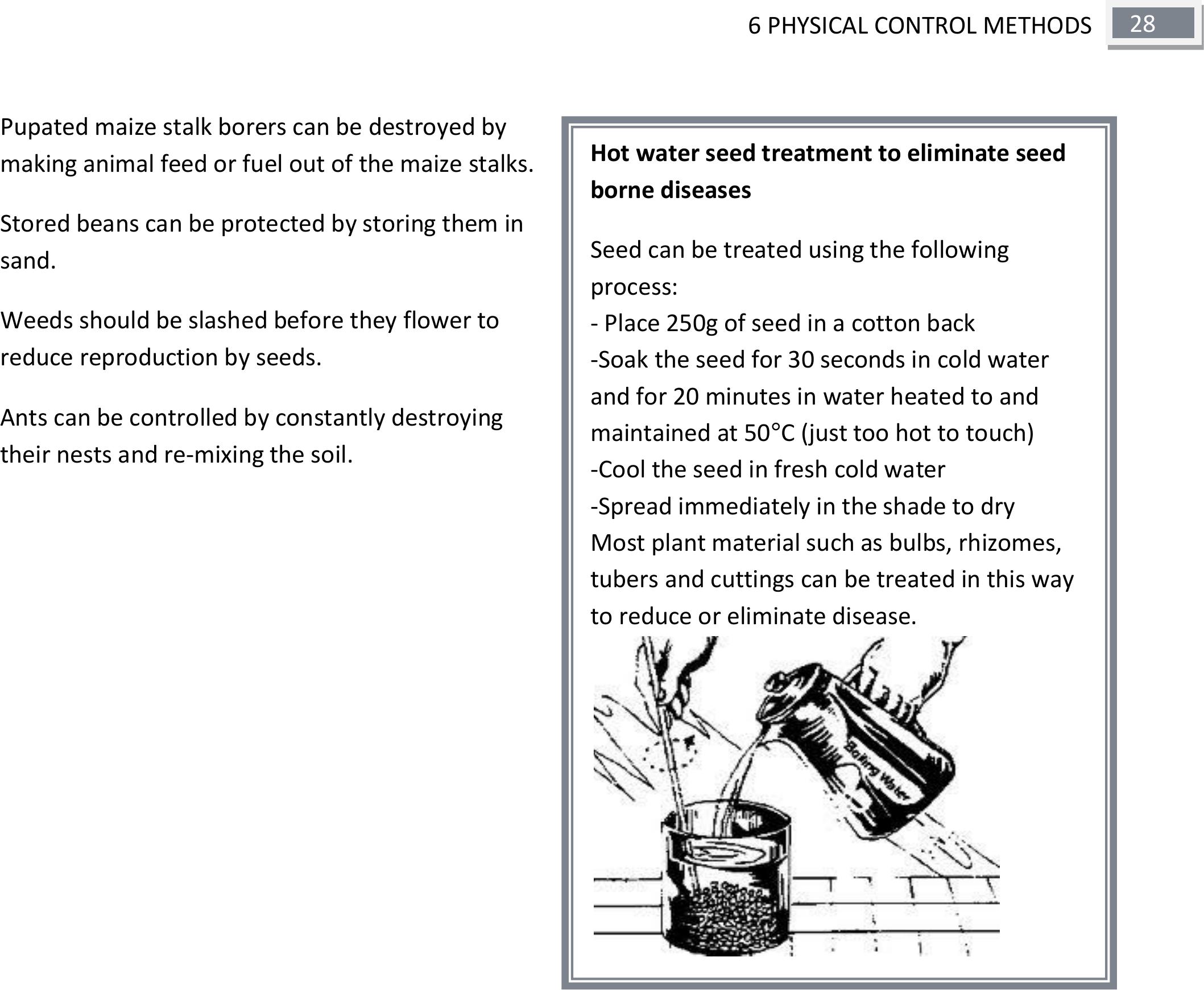
28
6 PHYSICAL CONTROL METHODS
Pupated maize stalk borers can be destroyed by
making animal feed or fuel out of the maize stalks.
Stored beans can be protected by storing them in
sand.
Weeds should be slashed before they flower to
reduce reproduction by seeds.
Ants can be controlled by constantly destroying
their nests and re-mixing the soil.
Hot water seed treatment to eliminate seed
borne diseases
Seed can be treated using the following
process:
- Place 250g of seed in a cotton back
-Soak the seed for 30 seconds in cold water
and for 20 minutes in water heated to and
maintained at 50°C (just too hot to touch)
-Cool the seed in fresh cold water
-Spread immediately in the shade to dry
Most plant material such as bulbs, rhizomes,
tubers and cuttings can be treated in this way
to reduce or eliminate disease.

29
7 BOTANICAL REMEDIES
7 BOTANICAL REMEDIES
7.1 REMEDIES MADE FROM PLANT MATERIAL
In this chapter a few recipes for plant mixtures are given that can be used to control insects and
diseases. Be sure to read the warnings, where present, carefully. No responsibility will be taken for
damage to plants, animals, people or property.
Spraying with herbal poisons or plant teas can control pests and diseases to a large extent. Some of the
most widely used insecticides originally came from plants. The flowers, leaves, or roots have been finely
ground and used in this form, or the toxic
ingredients have been extracted and used alone or in
mixtures with other toxicants. The active chemical
from the plant was then identified and reproduced
as a synthetic chemical in the laboratory and sold as
a chemical. These synthetic chemicals have the same
properties as the natural chemicals but do not break
down as easily as the natural chemicals and can thus
damage the environment.
Another advantage of natural or organic remedies is
that they are cheap. But it must be realized that
some organic remedies are as poisonous as some
chemicals and that some chemicals are less
poisonous than some of the organic remedies.
Many plants with control possibilities are known and
probably many others are yet to be discovered.
Leaves of many strong-smelling, bitter-tasting plants
like gums, lantana, khaki weed, tomato or any other
herbs have great potential for insect sprays. Plants
that do not get attacked while in among affected
plants are also potential remedies.
At least 3000 plant species have already been
studied in laboratories to determine their
effectiveness for controlling plant pests and
diseases. Of these, approximately 1800 plants have
been shown to be more or less effective against
certain pests.
General points regarding aromatic plant
sprays
Sprays can be made up from the chopped up
leaves of different strong smelling plants.
Plants like garlic, chilli and onion work well.
The sprays have to be re-applied after rain or
irrigation as they are washed off with water
Green bar soap can be added to make the
spray stick to the plants and the insects
Generally the sprays are made up in 1 liter of
water. They are diluted from there; 1 part
solution to four parts water before being
applied
Most botanical insecticides are contact
poisons. Spraying has to be done rather
intensively to ensure all insects have been
covered by the spray.
Sunlight breaks down the sprays, so they
should be prepared and stored out of direct
sunlight
Some crops are damaged by sap from other
plants and it is possible for some of these
remedies to ‘burn’ the leaves of plants they
are applied to. Always test a new remedy on a
small number of plants first
For most applications against insects the best
time of day to spray is in the late afternoon
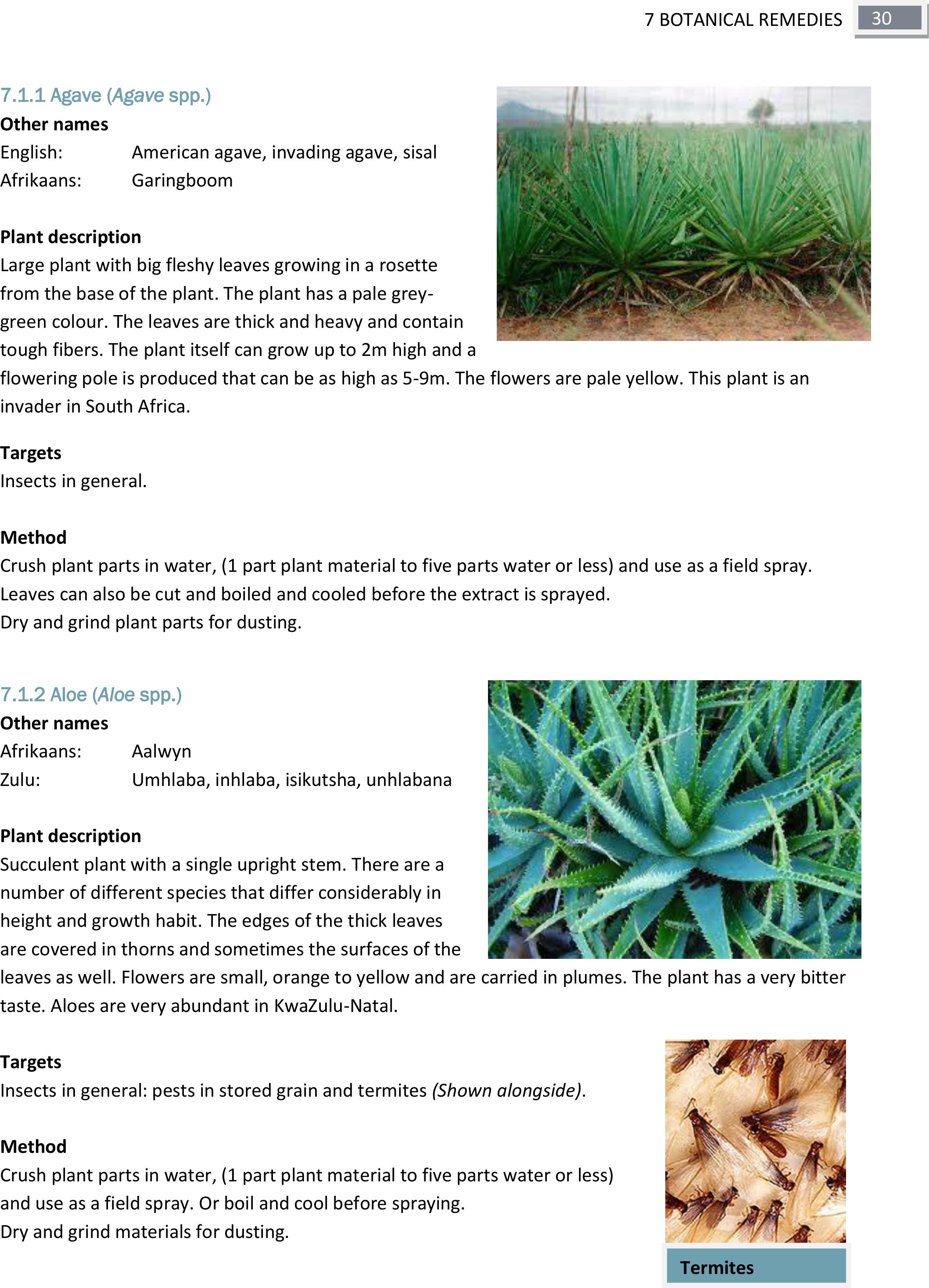
30
7 BOTANICAL REMEDIES
7.1.1 Agave (Agave spp.)
Other names
English: American agave, invading agave, sisal
Afrikaans: Garingboom
Plant description
Large plant with big fleshy leaves growing in a rosette
from the base of the plant. The plant has a pale grey-
green colour. The leaves are thick and heavy and contain
tough fibers. The plant itself can grow up to 2m high and a
flowering pole is produced that can be as high as 5-9m. The flowers are pale yellow. This plant is an
invader in South Africa.
Targets
Insects in general.
Method
Crush plant parts in water, (1 part plant material to five parts water or less) and use as a field spray.
Leaves can also be cut and boiled and cooled before the extract is sprayed.
Dry and grind plant parts for dusting.
7.1.2 Aloe (Aloe spp.)
Other names
Afrikaans: Aalwyn
Zulu: Umhlaba, inhlaba, isikutsha, unhlabana
Plant description
Succulent plant with a single upright stem. There are a
number of different species that differ considerably in
height and growth habit. The edges of the thick leaves
are covered in thorns and sometimes the surfaces of the
leaves as well. Flowers are small, orange to yellow and are carried in plumes. The plant has a very bitter
taste. Aloes are very abundant in KwaZulu-Natal.
Targets
Insects in general: pests in stored grain and termites (Shown alongside).
Method
Crush plant parts in water, (1 part plant material to five parts water or less)
and use as a field spray. Or boil and cool before spraying.
Dry and grind materials for dusting.
Termites

31
7 BOTANICAL REMEDIES
7.1.3 Amaranth (Amaranthus spp.)
Other names
English: Pigweed
Afrikaans: Misbredie, rooikatstert
Zulu: Imbuya
Plant description
Upright, annual weed. Stems are rough and can have a red tinge.
Flowers are very small and carried in a spike on the growing tips. Flowers
can be red or green in colour. Plants can grow up to 2m high. This plant
is used and sold as a spinach. If cattle eat large quantities of this plant,
they may be poisoned and die.
Targets
Various fungi, such as:
Alternaria - fruit rot, early blight, purple blotch, leaf spot.
Right: Alternaria symptoms on cabbage(above and
tomato(below) In tomatoes it is known as late blight
Cercospora - leaf mould, leaf spot, early blight, frog-eye
Colletotrichurn - leaf spot, anthracnose, fruit rot, smudge.
Curvularia - leaf spot, leaf blight.
Helminthosporium - leaf blight.
Pestalotia - leaf spot.
Method
Extract the juice of 1 kg leaves, then mix the juice with 3 litres
of water and use as a spray.
7.1.4 Basil (Ocimurn basilicum)
Other names
English: Sweet basil
Afrikaans: Basiliekruid
Zulu: Amakha
Plant description
Herbaceous plant with light green leaves, sometimes with a
purple tinge on the underside. Whitish flowers are produced. A
delightful smell is released when the leaves are bruised.

32
7 BOTANICAL REMEDIES
Targets
Insects in general: flies, mosquitoes, aphids, cockroaches,
cotton strainers, mites and ticks.
Fungi in general.
Method
The oil of this plant has been used to control pests in fields and
buildings. Various extracts can be prepared from dried and
powdered leaves, flowers or the entire plant. Whole plants, when dried, can act as
an insect repellent. Dusting powder can be made by drying the leaves in the sun.
Soak crushed leaves in water for 24 hours, filter and spray, or drench the soil before planting. Basil is
traditionally used for treating seedbeds against all kinds of soil-borne diseases and pests.
7.1.5 Blackjack (Bidens pilosa)
Other names
English: Common blackjack
Afiikaans: Gewone knapsekérel, wewenaar
Zulu: Amalenjane, uqadolo, ucucuza
Plant description
Annual weed. Flowers are white with yellow centers. Seeds are small, black
and slender with little claws on one end. These seeds can stick to your clothes
or to an animal’s fur.
Targets
Insects in general: aphids, ants, beetles, cabbage root fly,
caterpillars, crickets, mites, termites and whitefly.
Method
All the plant parts can be used, but in particular the mature seeds.
Cover a cupful of mature seeds with water, boil for 10 min (or soak
for 24 hours), cool, add 1 litre of water and a teaspoon of soap and
spray immediately.
Seeds can be spread around bushes to deter termites. If this method
is used the plants can get out of hand, creating a weed problem.
Cotton stainers
Beetle; Emerald
fruit chafer
Aphids
Warning
High concentrations may affect the flowers
of some plants.
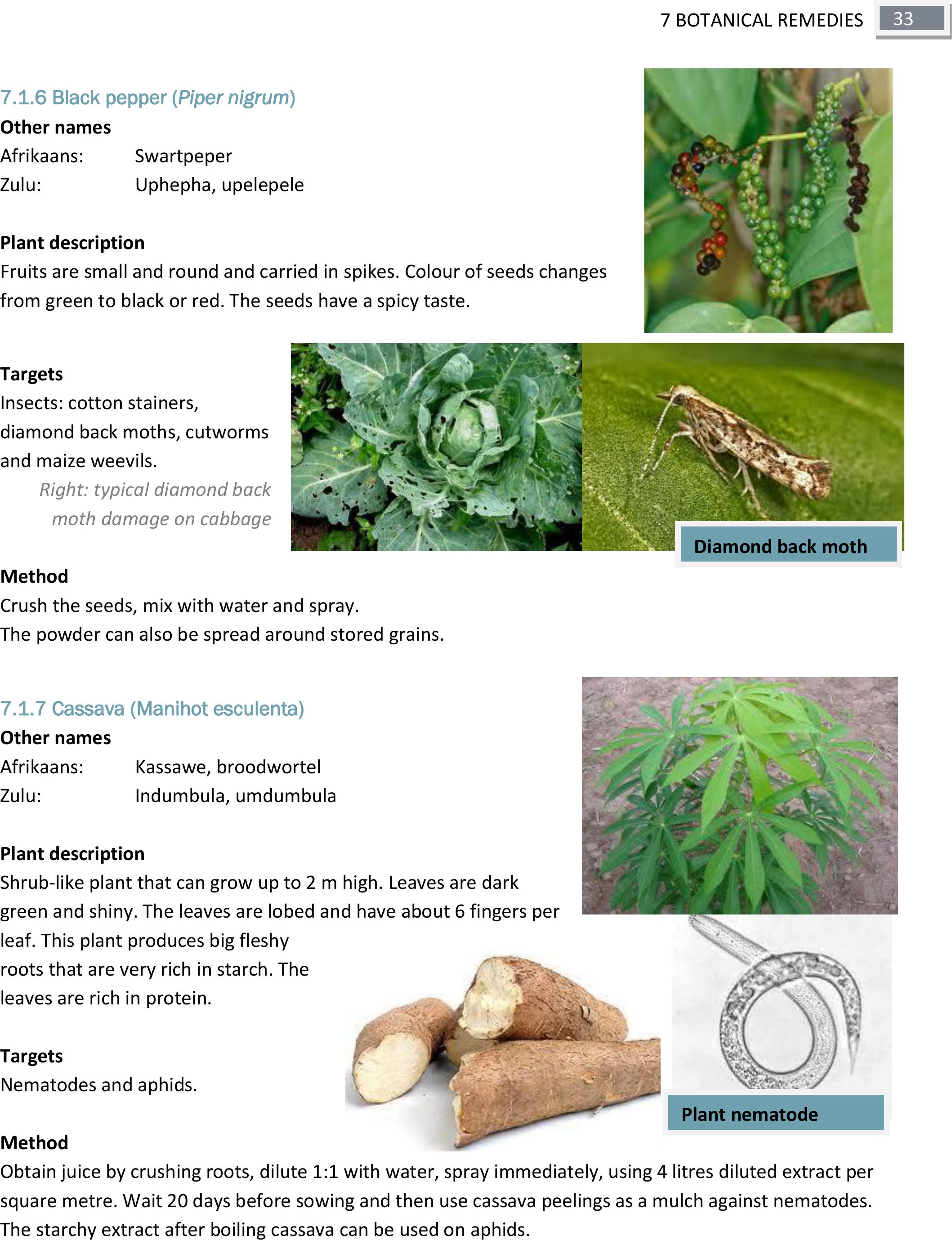
33
7 BOTANICAL REMEDIES
7.1.6 Black pepper (Piper nigrum)
Other names
Afrikaans: Swartpeper
Zulu: Uphepha, upelepele
Plant description
Fruits are small and round and carried in spikes. Colour of seeds changes
from green to black or red. The seeds have a spicy taste.
Targets
Insects: cotton stainers,
diamond back moths, cutworms
and maize weevils.
Right: typical diamond back
moth damage on cabbage
Method
Crush the seeds, mix with water and spray.
The powder can also be spread around stored grains.
7.1.7 Cassava (Manihot esculenta)
Other names
Afrikaans: Kassawe, broodwortel
Zulu: Indumbula, umdumbula
Plant description
Shrub-like plant that can grow up to 2 m high. Leaves are dark
green and shiny. The leaves are lobed and have about 6 fingers per
leaf. This plant produces big fleshy
roots that are very rich in starch. The
leaves are rich in protein.
Targets
Nematodes and aphids.
Method
Obtain juice by crushing roots, dilute 1:1 with water, spray immediately, using 4 litres diluted extract per
square metre. Wait 20 days before sowing and then use cassava peelings as a mulch against nematodes.
The starchy extract after boiling cassava can be used on aphids.
Diamond back moth
Plant nematode
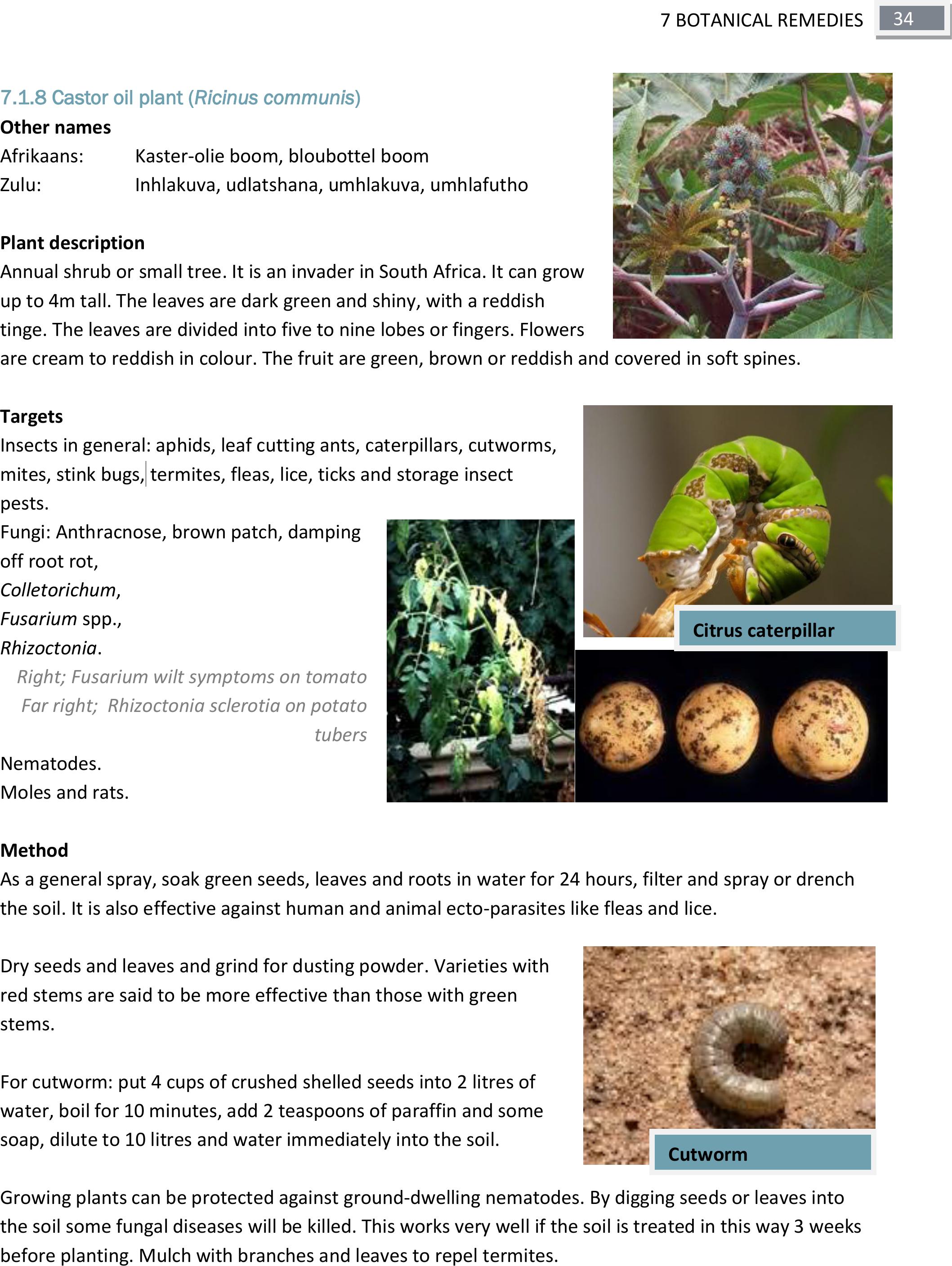
34
7 BOTANICAL REMEDIES
7.1.8 Castor oil plant (Ricinus communis)
Other names
Afrikaans: Kaster-olie boom, bloubottel boom
Zulu: Inhlakuva, udlatshana, umhlakuva, umhlafutho
Plant description
Annual shrub or small tree. It is an invader in South Africa. It can grow
up to 4m tall. The leaves are dark green and shiny, with a reddish
tinge. The leaves are divided into five to nine lobes or fingers. Flowers
are cream to reddish in colour. The fruit are green, brown or reddish and covered in soft spines.
Targets
Insects in general: aphids, leaf cutting ants, caterpillars, cutworms,
mites, stink bugs, termites, fleas, lice, ticks and storage insect
pests.
Fungi: Anthracnose, brown patch, damping
off root rot,
Colletorichum,
Fusarium spp.,
Rhizoctonia.
Right; Fusarium wilt symptoms on tomato
Far right; Rhizoctonia sclerotia on potato
tubers
Nematodes.
Moles and rats.
Method
As a general spray, soak green seeds, leaves and roots in water for 24 hours, filter and spray or drench
the soil. It is also effective against human and animal ecto-parasites like fleas and lice.
Dry seeds and leaves and grind for dusting powder. Varieties with
red stems are said to be more effective than those with green
stems.
For cutworm: put 4 cups of crushed shelled seeds into 2 litres of
water, boil for 10 minutes, add 2 teaspoons of paraffin and some
soap, dilute to 10 litres and water immediately into the soil.
Growing plants can be protected against ground-dwelling nematodes. By digging seeds or leaves into
the soil some fungal diseases will be killed. This works very well if the soil is treated in this way 3 weeks
before planting. Mulch with branches and leaves to repel termites.
Citrus caterpillar
Cutworm

35
7 BOTANICAL REMEDIES
The oil of the caster-oil plant
is used for protection of
stored peas and beans against
storage pests nad weevils, by
mixing it with the seeds to be
protected. Five to 10 ml per
kg are sufficient to ensure
good protection for 4 to 6
months. No effects have been experienced by people or animals that
ate food treated in this way. Put green seeds into mole holes or rat
nests as an effective repellant.
7.1.9 Chilli (Capsicum frutescens)
Other names
English: Hot pepper
Aftikaans: Rissie
Zulu: Ibelebile, upelepele
Plant description
Small shrub-like plant with a shiny leaf. Bears small red
fruit with a very strong, stinging taste.
Targets
Insects in general: aphids, ants, cabbage worms,
caterpillars, cutworms, rice moths and storage insect
pests.
Slugs and snails.
Fungi and bacteria in general.
Viruses: Cucumber Mosaic Virus (shown alongside) and
ringspot virus.
Method
Grind 2 handfuls of ripe chilli pods, soak in 1 litre of
water for 1 day. Shake well for a few minutes, filter, and
add 5 litres of water and a little soap. Sieve and spray.
Chilli powder can be applied around the base of plants to
repel ants, cutworm, slugs, snails, and a wide range of soil pests. Chillies are often planted as a repellant.
Warning
Seeds are poisonous to
human beings, and
poultry ten seeds can be
fatal to and adults and
even one seed can be
fatal to a child.
No adverse effects have
been noted for the oil
from the castor oil plant.
Bean weevil
Slugs
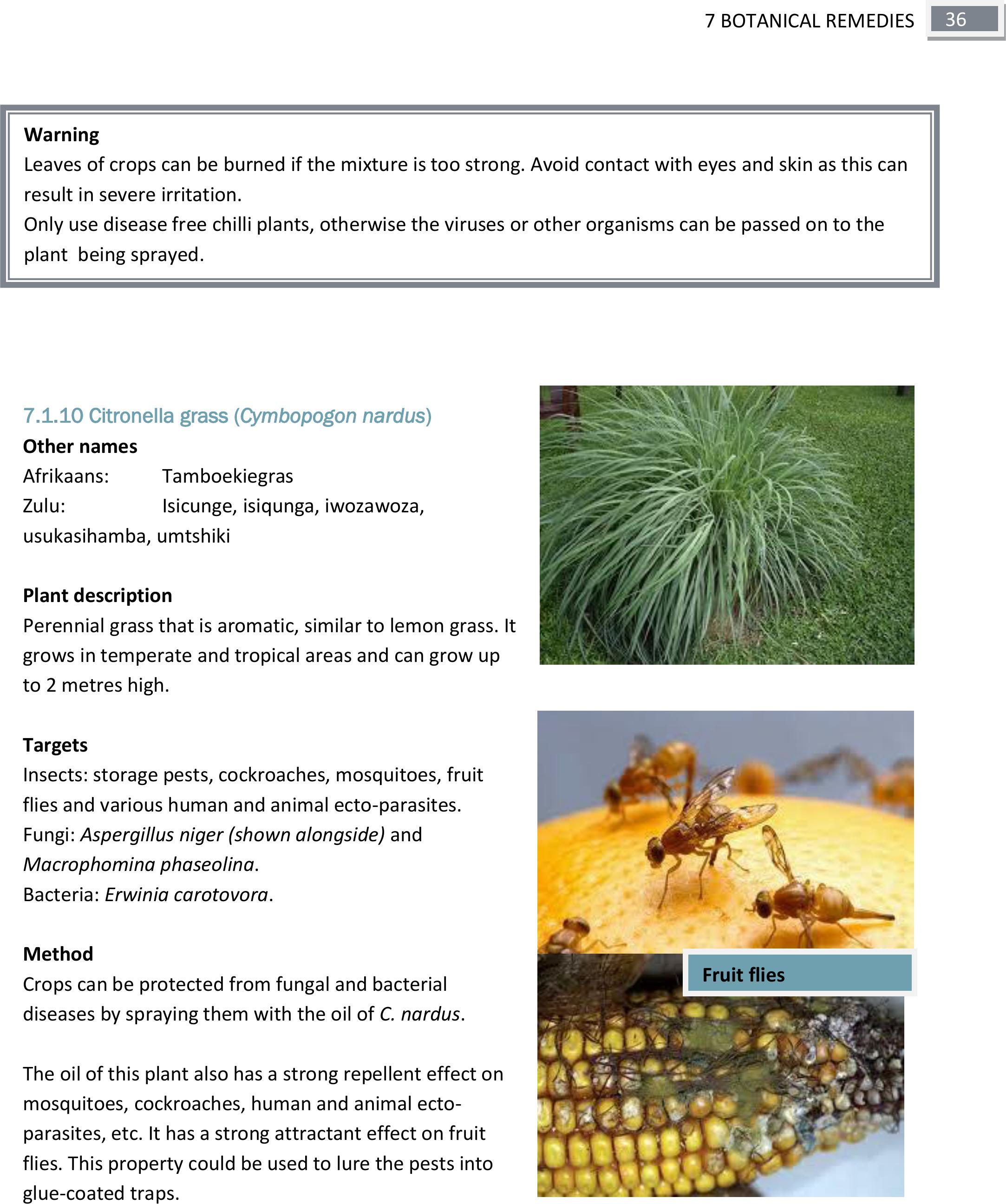
36
7 BOTANICAL REMEDIES
7.1.10 Citronella grass (Cymbopogon nardus)
Other names
Afrikaans: Tamboekiegras
Zulu: Isicunge, isiqunga, iwozawoza,
usukasihamba, umtshiki
Plant description
Perennial grass that is aromatic, similar to lemon grass. It
grows in temperate and tropical areas and can grow up
to 2 metres high.
Targets
Insects: storage pests, cockroaches, mosquitoes, fruit
flies and various human and animal ecto-parasites.
Fungi: Aspergillus niger (shown alongside) and
Macrophomina phaseolina.
Bacteria: Erwinia carotovora.
Method
Crops can be protected from fungal and bacterial
diseases by spraying them with the oil of C. nardus.
The oil of this plant also has a strong repellent effect on
mosquitoes, cockroaches, human and animal ecto-
parasites, etc. It has a strong attractant effect on fruit
flies. This property could be used to lure the pests into
glue-coated traps.
Warning
Leaves of crops can be burned if the mixture is too strong. Avoid contact with eyes and skin as this can
result in severe irritation.
Only use disease free chilli plants, otherwise the viruses or other organisms can be passed on to the
plant being sprayed.
Fruit flies
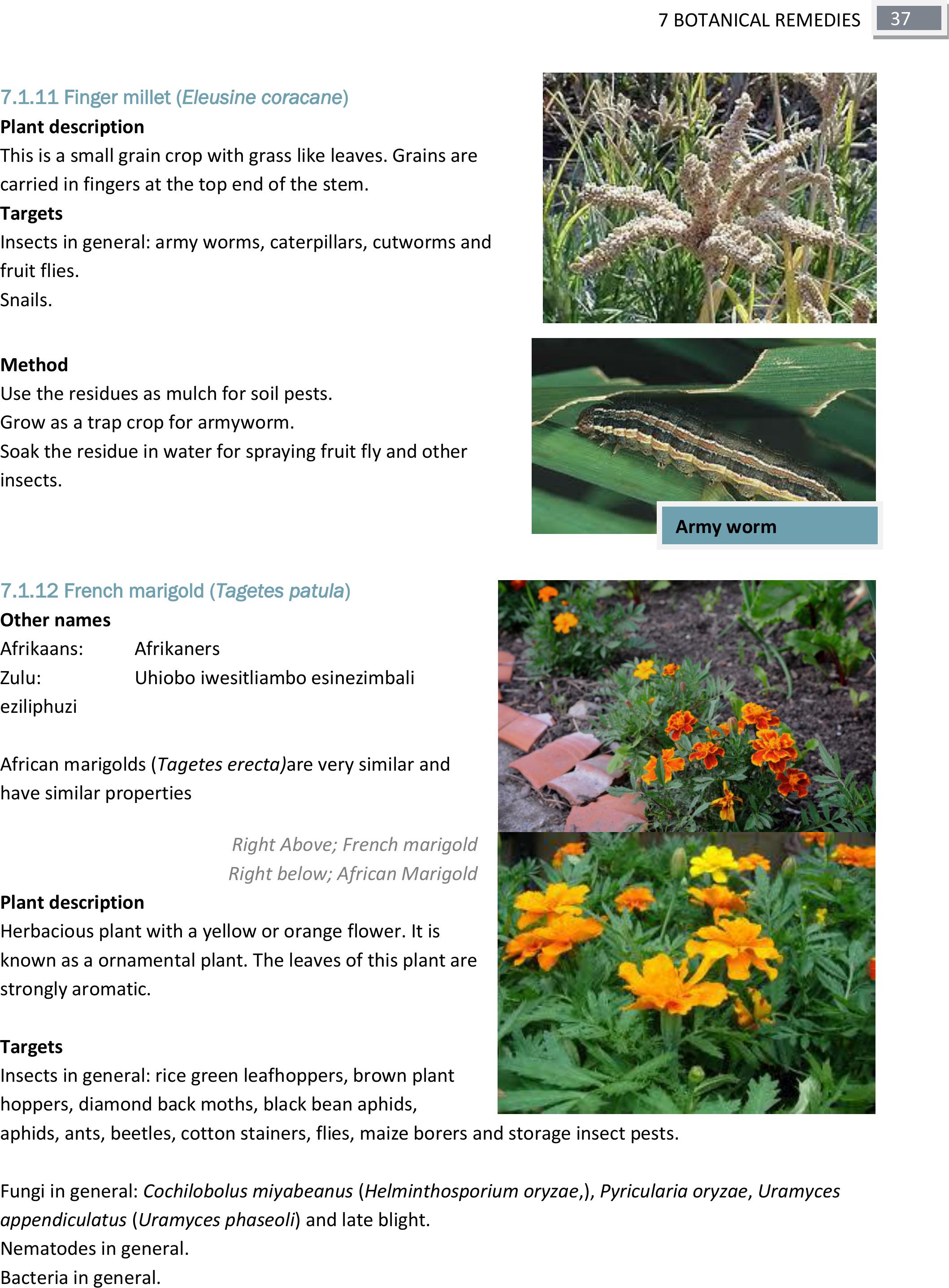
37
7 BOTANICAL REMEDIES
7.1.11 Finger millet (Eleusine coracane)
Plant description
This is a small grain crop with grass like leaves. Grains are
carried in fingers at the top end of the stem.
Targets
Insects in general: army worms, caterpillars, cutworms and
fruit flies.
Snails.
Method
Use the residues as mulch for soil pests.
Grow as a trap crop for armyworm.
Soak the residue in water for spraying fruit fly and other
insects.
7.1.12 French marigold (Tagetes patula)
Other names
Afrikaans: Afrikaners
Zulu: Uhiobo iwesitliambo esinezimbali
eziliphuzi
African marigolds (Tagetes erecta)are very similar and
have similar properties
Right Above; French marigold
Right below; African Marigold
Plant description
Herbacious plant with a yellow or orange flower. It is
known as a ornamental plant. The leaves of this plant are
strongly aromatic.
Targets
Insects in general: rice green leafhoppers, brown plant
hoppers, diamond back moths, black bean aphids,
aphids, ants, beetles, cotton stainers, flies, maize borers and storage insect pests.
Fungi in general: Cochilobolus miyabeanus (Helminthosporiumoryzae,), Pyriculariaoryzae, Uramyces
appendiculatus (Uramycesphaseoli) and late blight.
Nematodes in general.
Bacteria in general.
Army worm

38
7 BOTANICAL REMEDIES
It can suppress some weeds.
Method
Crush 100-200g of leaves, roots, flowers, pour on 1 litre of boiling water, soak for 24 hours, add 1 litre of
cold water and some green bar soap, mix and spray on plants or into soil.
Soak 10 to 15 mature, chopped marigold plants in 20 litres of boiled hot water. Add sieved wood ash.
Strain and spray the affected plants or water around them. The coarse materials remaining from the
solution can be used as a mulch around plants and to repel insects.
Usually, the Tagetes spp. have been planted together with other plants susceptible to attack by
nematodes; the roots exude a substance with nematicidal effect, qualifying marigolds as natural
enemies of free-living nematodes that attack the roots of plants. For a mixture that can kill nematodes,
pound around 1kg of roots, collect the extract, mix with 1 litre water and spray into the soil
Leaves of marigold can be dug into the soil or the tea sprinkled on the soil to discourage many insects
from feeding. The leaves can also be mixed with
stored grain to prevent damage.
A number of pests can also be controlled by dusting
plants with dried and powdered parts ofTagetes
erecta.
7.1.13 Garlic (Allium sativum)
Other names
Afrikaans: Knoffel
Zulu: Ugaliga
Plant description
Strong-smelling bulbous herb.
Targets
Insects in general:
mosquitoes, cotton
stainers, aphids, flies,
army worms, ticks, ants,
beetles, caterpillars,
diamondback moths, false
codling moths, grubs,
mites, peach borers and termites.
False codling moth larvae and moth
The flowers, in powdered form are
added to the feed of laying chickens to
give the yolk of the eggs a bright orange
colour.

39
7 BOTANICAL REMEDIES
Others: birds, mice, moles, mole
rats and nematodes.
Right: A mole rat. Notice large
teeth. These creatures eat roots
and bulbs of plants
Far right; A cape mole. They have
very pronounced claws, eyes are
sometimes so small as to be
almost invisible and they are
insectivorous.
Fungi: scab, mildew, bean rust and tomato blight.
Alternaria - fruit rot, early blight, purple blotch, leaf spot.
Cercospora - leaf mould, leaf spot, early blight, frog-eye.
Colletotrichurn - leaf spot, anthracnose, fruit rot, smudge.
Right: Symptoms of antrachnose caused by the Colletotrichum
fungus; above on a capsicum plant and fruit and below on an
apple
Curvularia - leaf spot, leaf blight.
Diplodia - fruit and stem rot.
Fusarium - damping off, stein and root rot, early blight, wilt and curly top.
Helminthosporium - leaf blight.
Pestalotia - leaf spot.
Cochliobolusmiyabeanus (Helminthosporium oryzae).
Pyricidariaoryzae.
Bacteria: Xanthomonas spp.
Right: Bacterial blight on strawberries, caused by Xanthomonas
campestris
Method
Chop some cloves finely (one large bulb, or two medium bulbs) and
soak in 2 teaspoons of oil for one day or in liquid paraffin for two days.
Use a glass jar, not a tin. Mix with half a litre of soapy water and filter.
Mix 1 part solution with 10 parts of water and use as a spray. Shake
well before applying.
The bulbs can be dried, crushed and used as a powder. The powder can be made into a spray
recommended for scab, mildew, bean rust and tomato blight.
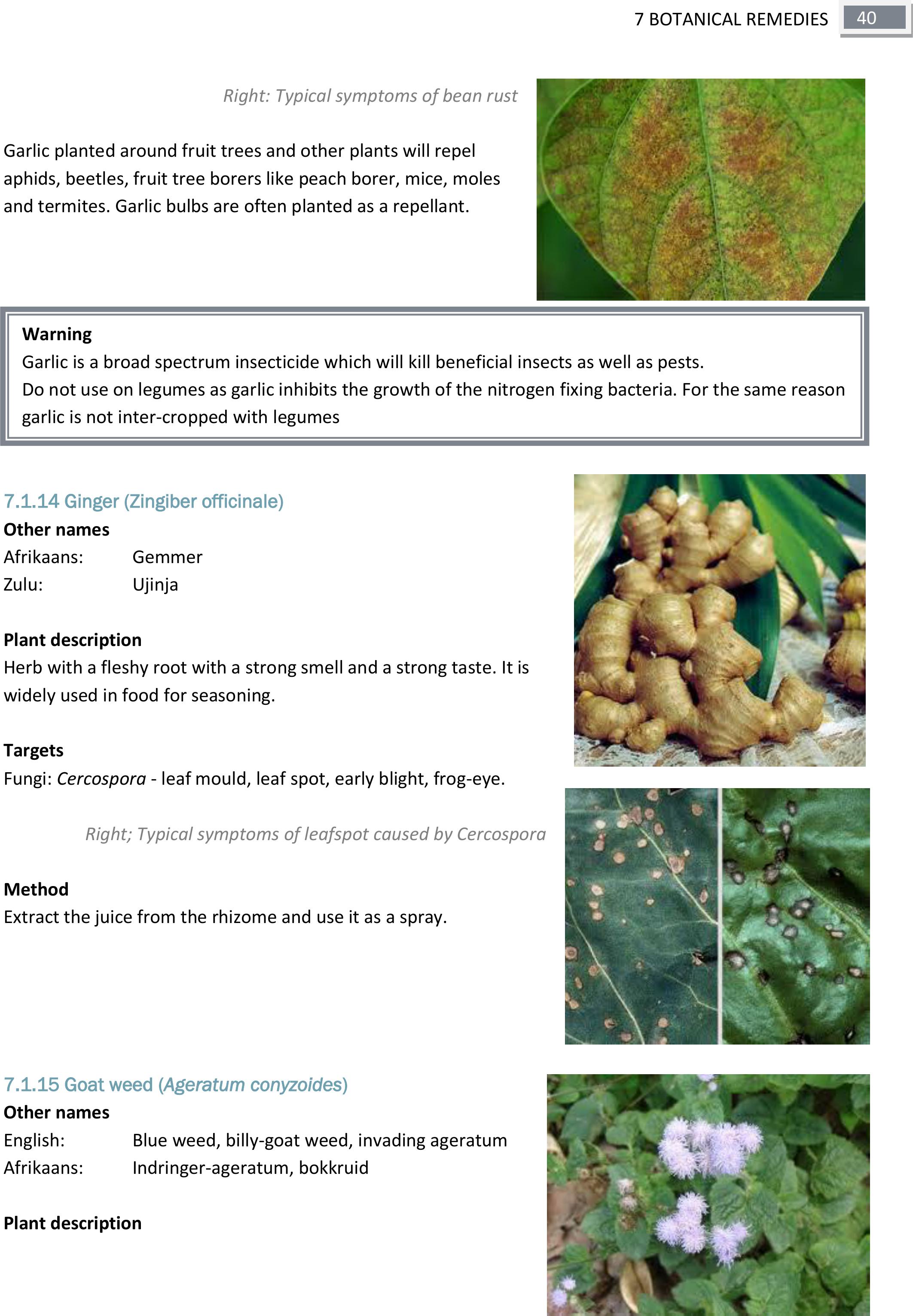
40
7 BOTANICAL REMEDIES
Right: Typical symptoms of bean rust
Garlic planted around fruit trees and other plants will repel
aphids, beetles, fruit tree borers like peach borer, mice, moles
and termites. Garlic bulbs are often planted as a repellant.
7.1.14 Ginger (Zingiber officinale)
Other names
Afrikaans: Gemmer
Zulu: Ujinja
Plant description
Herb with a fleshy root with a strong smell and a strong taste. It is
widely used in food for seasoning.
Targets
Fungi: Cercospora - leaf mould, leaf spot, early blight, frog-eye.
Right; Typical symptoms of leafspot caused by Cercospora
Method
Extract the juice from the rhizome and use it as a spray.
7.1.15 Goat weed (Ageratum conyzoides)
Other names
English: Blue weed, billy-goat weed, invading ageratum
Afrikaans: Indringer-ageratum, bokkruid
Plant description
Warning
Garlic is a broad spectrum insecticide which will kill beneficial insects as well as pests.
Do not use on legumes as garlic inhibits the growth of the nitrogen fixing bacteria. For the same reason
garlic is not inter-cropped with legumes
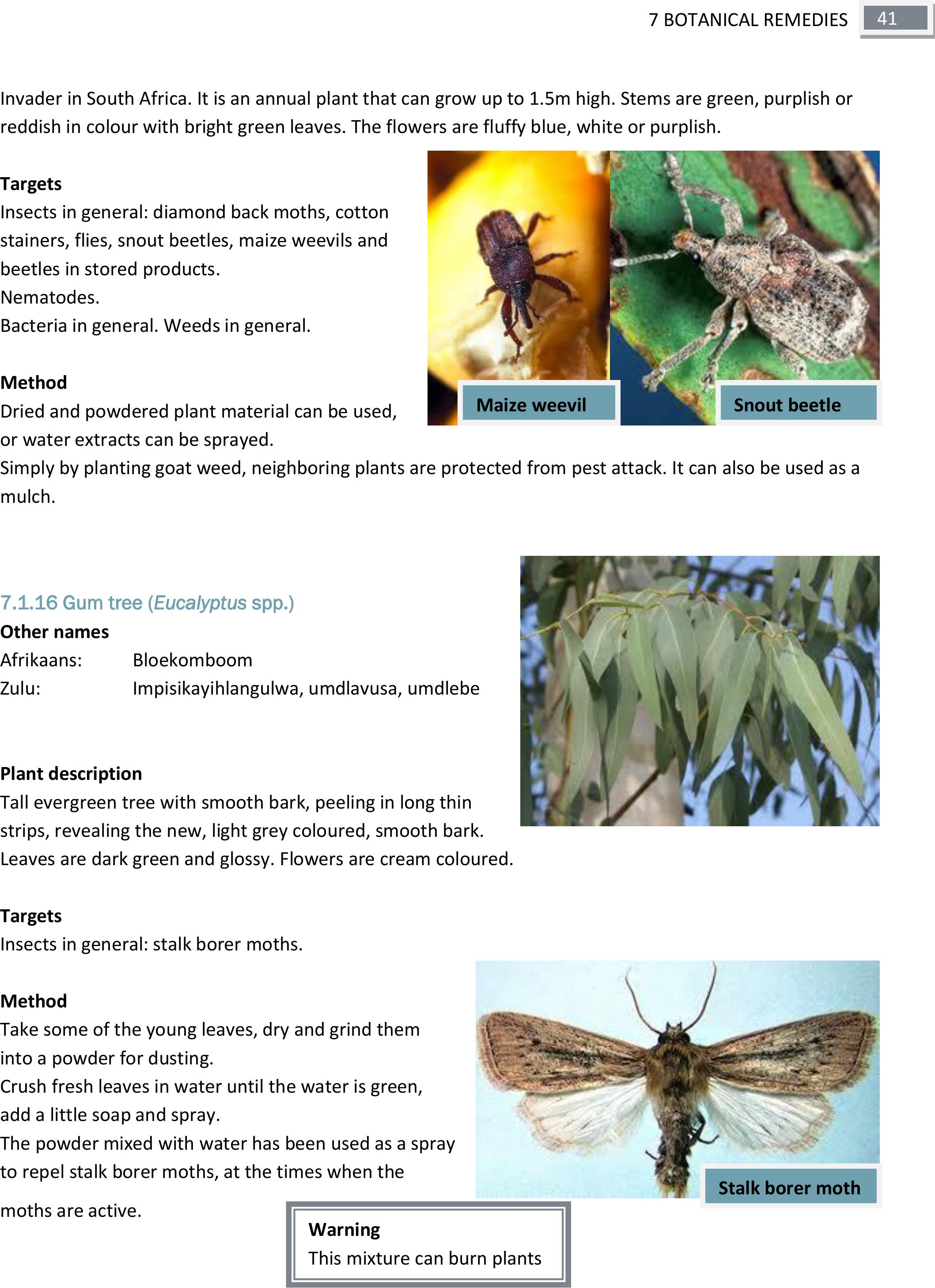
41
7 BOTANICAL REMEDIES
Invader in South Africa. It is an annual plant that can grow up to1.5m high. Stems are green, purplish or
reddish in colour with bright green leaves. The flowers are fluffy blue, white or purplish.
Targets
Insects in general: diamond back moths, cotton
stainers, flies, snout beetles, maize weevils and
beetles in stored products.
Nematodes.
Bacteria in general. Weeds in general.
Method
Dried and powdered plant material can be used,
or water extracts can be sprayed.
Simply by planting goat weed, neighboring plants are protected from pest attack. It can also be used as a
mulch.
7.1.16 Gum tree (Eucalyptus spp.)
Other names
Afrikaans: Bloekomboom
Zulu: Impisikayihlangulwa, umdlavusa, umdlebe
Plant description
Tall evergreen tree with smooth bark, peeling in long thin
strips, revealing the new, light grey coloured, smooth bark.
Leaves are dark green and glossy. Flowers are cream coloured.
Targets
Insects in general: stalk borer moths.
Method
Take some of the young leaves, dry and grind them
into a powder for dusting.
Crush fresh leaves in water until the water is green,
add a little soap and spray.
The powder mixed with water has been used as a spray
to repel stalk borer moths, at the times when the
moths are active.
Snout beetle
Maize weevil
Warning
This mixture can burn plants
Stalk borer moth

42
7 BOTANICAL REMEDIES
7.1.17 Lantana (Lantana camara)
Other names
English: Tickberry
Afrikaans: Gomdagga
Zulu: Ubuhobhe
Plant description
Invader that is a woody shrub up to 2m high. Stems are
usually rough. Leaves are dark green and strong smelling
when crushed. Flowers can be pink, red, crimson, orange,
yellow or white. Flowers are small and compact, usually with more than one colour per flowerhead.
Fruit are clumps of green to purplish-black, fleshy fruit.
Targets
Insects in general: maize weevils, beetles,
leaf miners and insects in stored grain.
Right; typical leaf miner damage
Method
Crush 1 handful of leaves in 1 litre of
water, add a little soap and spray.
Dry and grind into a dusting powder.
Burn the branches and dust the ashes over beetles and leaf miners.
Pound the flowers, leaves and/or branches and spread around stored
grains as an insect repellant.
7.1.18 Lemon grass (Andropogon citratus)
Other names
Afrikaans: Sitroengras, lemoengras, suurpol
Plant description
Tall grass with a strong lemon smell when crushed.
Targets
Insects in general: storage pests, mosquitoes, aphids, flies,
mites and ticks.
Nematodes: Meloidogyne incognita.
Warning
Poisonous to cattle- causes
photosensitivity
Leaf miner

43
7 BOTANICAL REMEDIES
Method
If an emulsion, containing oil, is sprayed onto pest-afflicted crops, it destroys aphids, mites and ticks.
Just by rubbing the fresh leaves of this plant onto a surface keeps away flies and mosquitoes. The
burning of the plant oil also repels insects.
A diluted solution of the juice obtained by pressing out the roots can also be used effectively for pest
control.
For control of nematodes, it is recommended to grow the grass on infested plots. This results in a rapid
decrease in the nematode population in the soil.
7.1.20 Mexican marigold (Tagetes minuta)
Other names
English: Tall khaki weed
Afrikaans: Kakiebos, langkakiebos
Plant description
Herbaceous weed with a very strong smell. Small yellow flowers are produced on
the plants.
Targets
Insects in general: ants, aphids, blowflies, caterpillars, flies, fleas, maggots,
mosquitoes and termites.
Fungi in general: Late blight and
mildews.
Near right: downy mildew and
powdery mildew symptoms
compared
Far right; Powdery mildew on a
squash plant.
Nematodes in general
Method
Soak crushed parts of 1 mature plant in 2 litres of water for 24 hours, filter and spray. A handful of wood
ash can be added to improve the insect range. Apply weekly for prevention of fungal diseases.
Ants can be repelled either by watering the liquid from the crushed plants well into the soil around the
plants to be protected or by digging the freshly crushed leaves of Tagetes into the soil before planting.
Grow in rotation for nematode control. Dry and grind for dusting powder against fleas, etc. Leaves
rubbed on the skin will repel mosquitoes. The Mexican marigold can also be used as a soil improver.

44
7 BOTANICAL REMEDIES
7.1.21 Mexican poppy (Agromone mexicana)
Other names
Afhkaans: Bloudistel, Mexikaanse papawer
Zulu: Uhlobo lwembali okwenziwa ngayo i-ophiyamu
Plant description
Herbaceous annual with pretty open yellow to orange flowers. The
flowers can look floppy and wrinkled. The fruit is a capsule that holds
seed.
Targets
Insects in general: stem borers, termites, ants, cotton stainers, army
worms, snout beetles, beetles, caterpillars, grubs and weevils.
Fungi in general: Alternaria alternata (Alternaria tenuis) and Cochliobolus miyabeanus
(Helminthosporium oryzaa).
Nematodes in general: Meloidogyne incognita and Meloidogyne javanica.
Bacteria in general.
Method
Water extracts, obtained from either the seeds or the whole plant, control some pests. The oil of the
plant is the best and is used for repelling ants and termites.
Dusting plants with the seeds of the Mexican poppy in powdered form is a quite successful method of
controlling pests.
7.1.22 Onion (Allium cepa)
Other names
Aftikaans: Ui
Zulu: U-anyanisi
Plant description
Strong-smelling, bulbous herb. Juice droplets irritate the human eye.
Targets
Insects: aphids, ants, cabbage butterfly, mites, scale insects, thrips,
tomato flies, ticks and whitefly.
Fungi: Cercospora - leaf mould, leaf spot, early blight, frog-eye.
Colletotrichum - leaf spot, anthracnose, fruit rot, smudge.
Curvularia - leaf spot, leaf blight.
Fusarium - damping off, stem and root rot, early blight, wilt and curly top.
Helminthosporium - leaf blight.
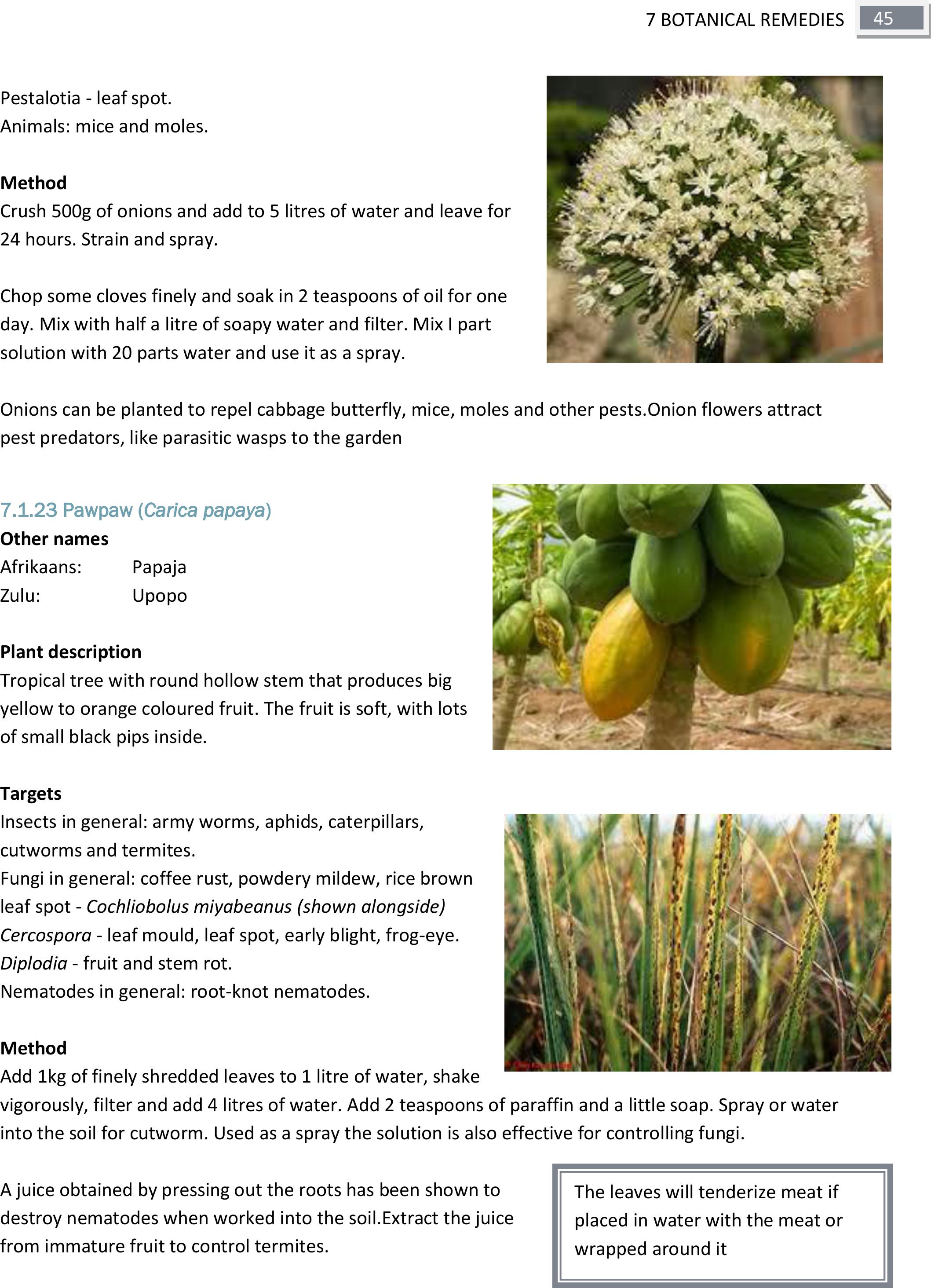
45
7 BOTANICAL REMEDIES
Pestalotia - leaf spot.
Animals: mice and moles.
Method
Crush 500g of onions and add to 5 litres of water and leave for
24 hours. Strain and spray.
Chop some cloves finely and soak in 2 teaspoons of oil for one
day. Mix with half a litre of soapy water and filter. Mix I part
solution with 20 parts water and use it as a spray.
Onions can be planted to repel cabbage butterfly, mice, moles and other pests.Onion flowers attract
pest predators, like parasitic wasps to the garden
7.1.23 Pawpaw (Carica papaya)
Other names
Afrikaans: Papaja
Zulu: Upopo
Plant description
Tropical tree with round hollow stem that produces big
yellow to orange coloured fruit. The fruit is soft, with lots
of small black pips inside.
Targets
Insects in general: army worms, aphids, caterpillars,
cutworms and termites.
Fungi in general: coffee rust, powdery mildew, rice brown
leaf spot - Cochliobolus miyabeanus(shown alongside)
Cercospora - leaf mould, leaf spot, early blight, frog-eye.
Diplodia - fruit and stem rot.
Nematodes in general: root-knot nematodes.
Method
Add 1kg of finely shredded leaves to 1 litre of water, shake
vigorously, filter and add 4 litres of water. Add 2 teaspoons of paraffin and a little soap. Spray or water
into the soil for cutworm. Used as a spray the solution is also effective for controlling fungi.
A juice obtained by pressing out the roots has been shown to
destroy nematodes when worked into the soil.Extract the juice
from immature fruit to control termites.
The leaves will tenderize meat if
placed in water with the meat or
wrapped around it

46
7 BOTANICAL REMEDIES
7.1.24 Pyrethrum (Chrysanthemum spp.)
Other names
Afrikaans: Krisant, aster, madeliefie
Plant description
Herbaceous ornamental plant which produces daisy-like
flowers of different colours: white and yellow, pink, orange or
just yellow. The variety with white flowers is the preferred
variety for insecticidal properties
Targets
Insects in general: white flies leafhoppers, spider mites, cabbage
worms, aphids, cockroaches, flies, mosquitos, caterpillars, tobacco
lice, beetles, locusts, mites, thrips and moths.
Method
Pyrethrum is a traditionally well-known insect poison derived from
the daisy species (Chrysanthemum spp.). Pyrethrin in the plant acts
as a nerve and contact poison on insects, but is harmless for all
warm-blooded creatures (human beings and animals).
To obtain natural pyrethrin, the flower heads of Chrysanthemum
are gathered by hand and dried. The powder can be applied mixed
either with gypsum or talc. The effectiveness of the powder
increases if ground finer. Make sure that you dust the underside of
the leaves. Under favourable conditions, the flowers can be
harvested throughout the year.
Draw one tablespoon of pyrethrum powder in half a litre of water,
with a little liquid soap for 30 min. Filtrate and spray immediately.
Pour 1 litre of boiling water over 50g pyrethrum flowers (or 20g powder), soak for several hours, add a
little soap, filter and spray. Apply late in the evening and spray selectively to protect beneficial insects.
The active constituents of Chrysanthemum spp. rapidly decompose when exposed to light and oxygen
(within 48 hours). As a result, crops must be treated at relatively short intervals.
White flies
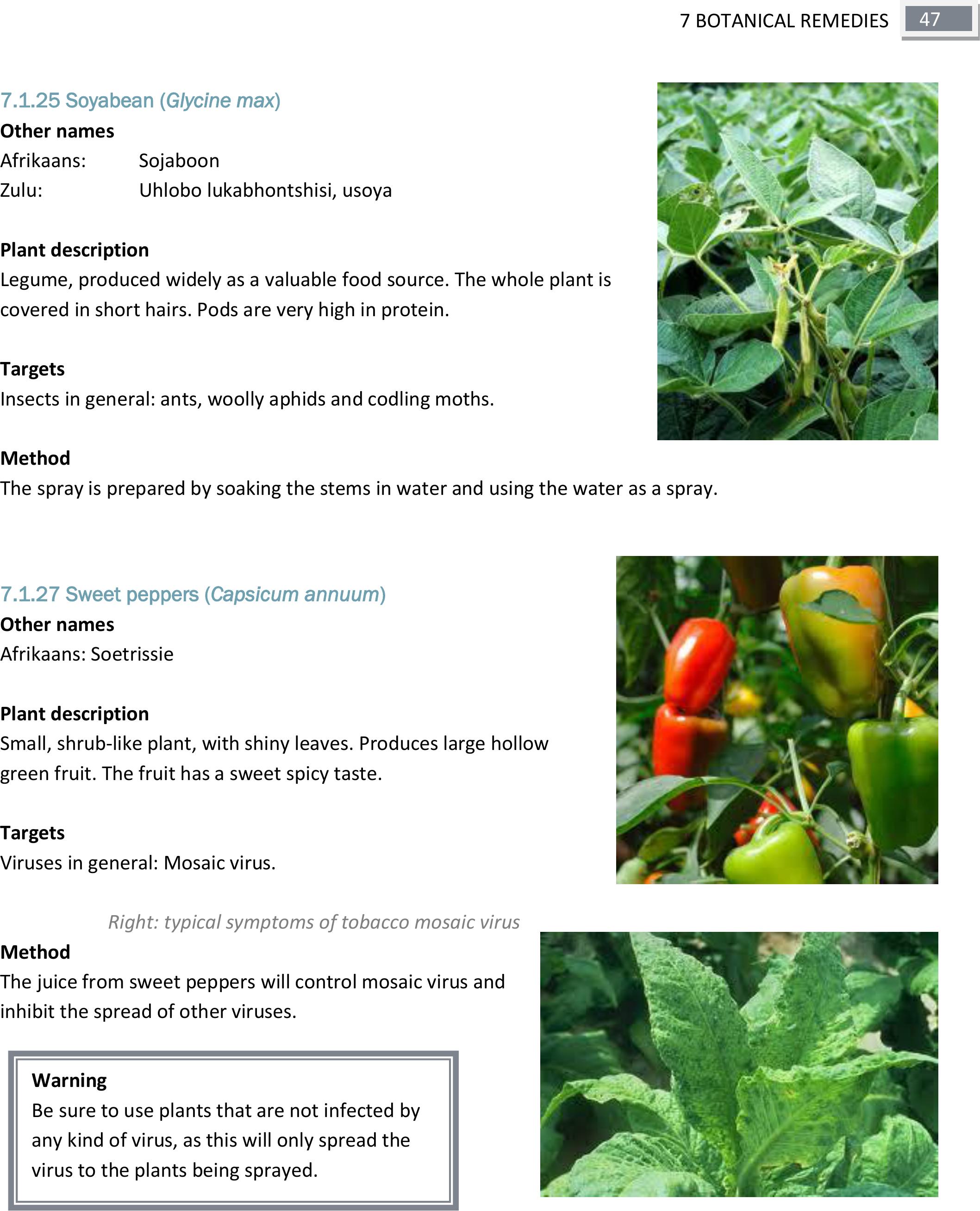
47
7 BOTANICAL REMEDIES
7.1.25 Soyabean (Glycine max)
Other names
Afrikaans: Sojaboon
Zulu: Uhlobo lukabhontshisi, usoya
Plant description
Legume, produced widely as a valuable food source. The whole plant is
covered in short hairs. Pods are very high in protein.
Targets
Insects in general: ants, woolly aphids and codling moths.
Method
The spray is prepared by soaking the stems in water and using the water as a spray.
7.1.27 Sweet peppers (Capsicum annuum)
Other names
Afrikaans: Soetrissie
Plant description
Small, shrub-like plant, with shiny leaves. Produces large hollow
green fruit. The fruit has a sweet spicy taste.
Targets
Viruses in general: Mosaic virus.
Right: typical symptoms of tobacco mosaic virus
Method
The juice from sweet peppers will control mosaic virus and
inhibit the spread of other viruses.
Warning
Be sure to use plants that are not infected by
any kind of virus, as this will only spread the
virus to the plants being sprayed.

48
7 BOTANICAL REMEDIES
7.1.27 Sweet potato (Impomoea batatas)
Other names
Afrikaans: Patat
Zulu: Ubhatata, umhlaza
Plant description
Vine with underground swollen roots that are used as a food
source. The swollen roots can have a dark red skin with
white flesh or a more brown-coloured skin. The flesh can
also be orange, depending on the cultivar. The roots are rich
in starch.
Targets
Insects: aphids.
Fungi in general: rice brown spot mid rice blast fungus.
Method
The leaves are crushed, soaked in water and sprayed. Heavily starched water from cooking the potatoes
can be tried on some smaller insects such as aphids.
7.1.28 Syringa (Melia azedarach)
Other names
English: Chinaberry tree, Persian lilac,
umbrella tree
Afrikaans: Bessieboom, Kaapse sering,
makboom
Zulu: Umsilinga
Plant description
Deciduous tree with small, purplish flowers and small, yellow, berry-like fruit. It is a declared weed.
Targets
Insects in general: ants, aphids,
armyworms, beetles, bollworms,
cabbage root fly, caterpillars, plant-
and leaf-hoppers, grubs, stem
borers, weevils, red spider mites and
termites.
Fungi and nematodes in general.
African bollworm
Cotton bollworm
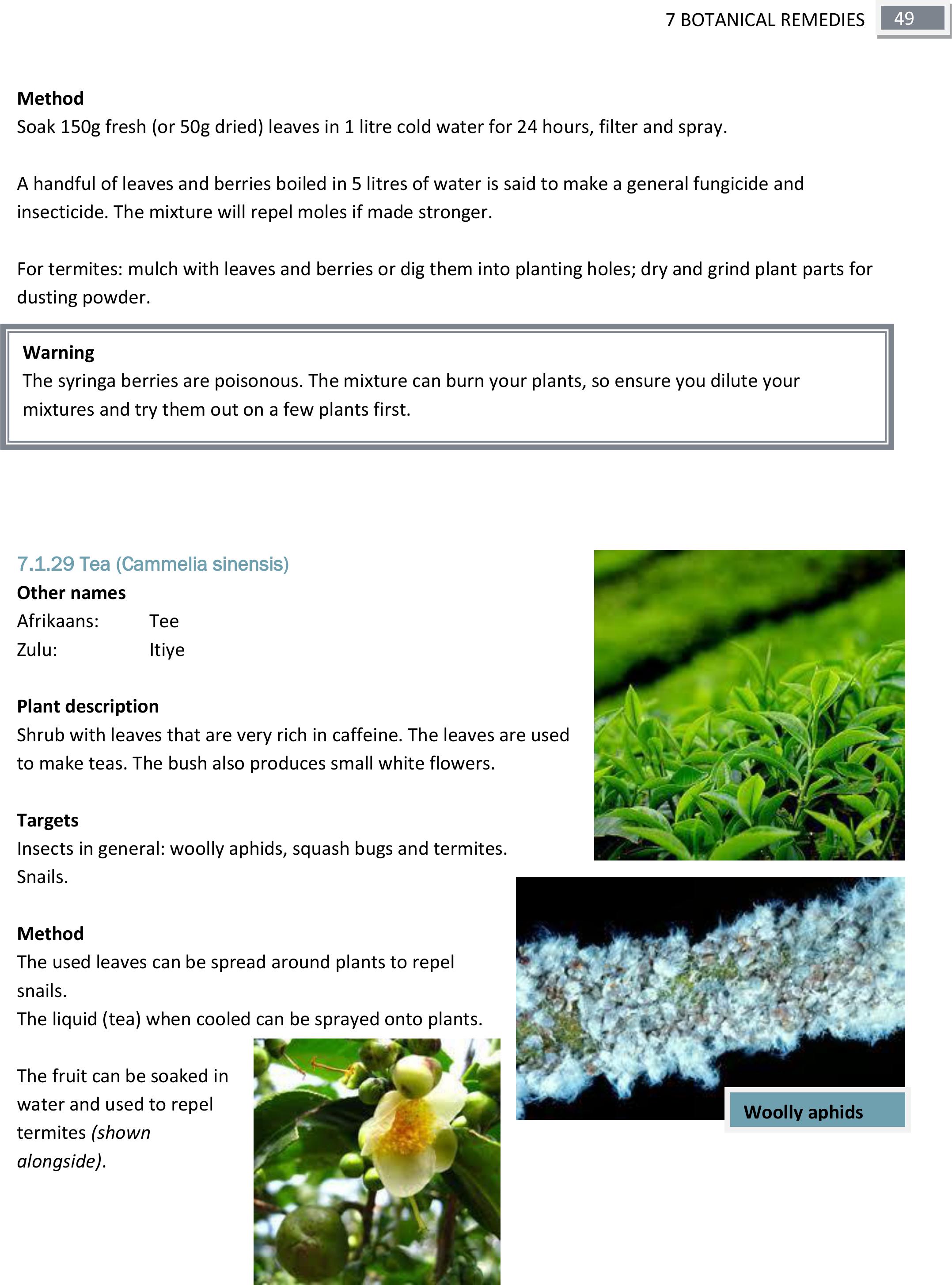
49
7 BOTANICAL REMEDIES
Method
Soak 150g fresh (or 50g dried) leaves in 1 litre cold water for 24 hours, filter and spray.
A handful of leaves and berries boiled in 5 litres of water is said to make a general fungicide and
insecticide. The mixture will repel moles if made stronger.
For termites: mulch with leaves and berries or dig them into planting holes; dry and grind plant parts for
dusting powder.
7.1.29 Tea (Cammelia sinensis)
Other names
Afrikaans: Tee
Zulu: Itiye
Plant description
Shrub with leaves that are very rich in caffeine. The leaves are used
to make teas. The bush also produces small white flowers.
Targets
Insects in general: woolly aphids, squash bugs and termites.
Snails.
Method
The used leaves can be spread around plants to repel
snails.
The liquid (tea) when cooled can be sprayed onto plants.
The fruit can be soaked in
water and used to repel
termites (shown
alongside).
Warning
The syringa berries are poisonous. The mixture can burn your plants, so ensure you dilute your
mixtures and try them out on a few plants first.
Woolly aphids
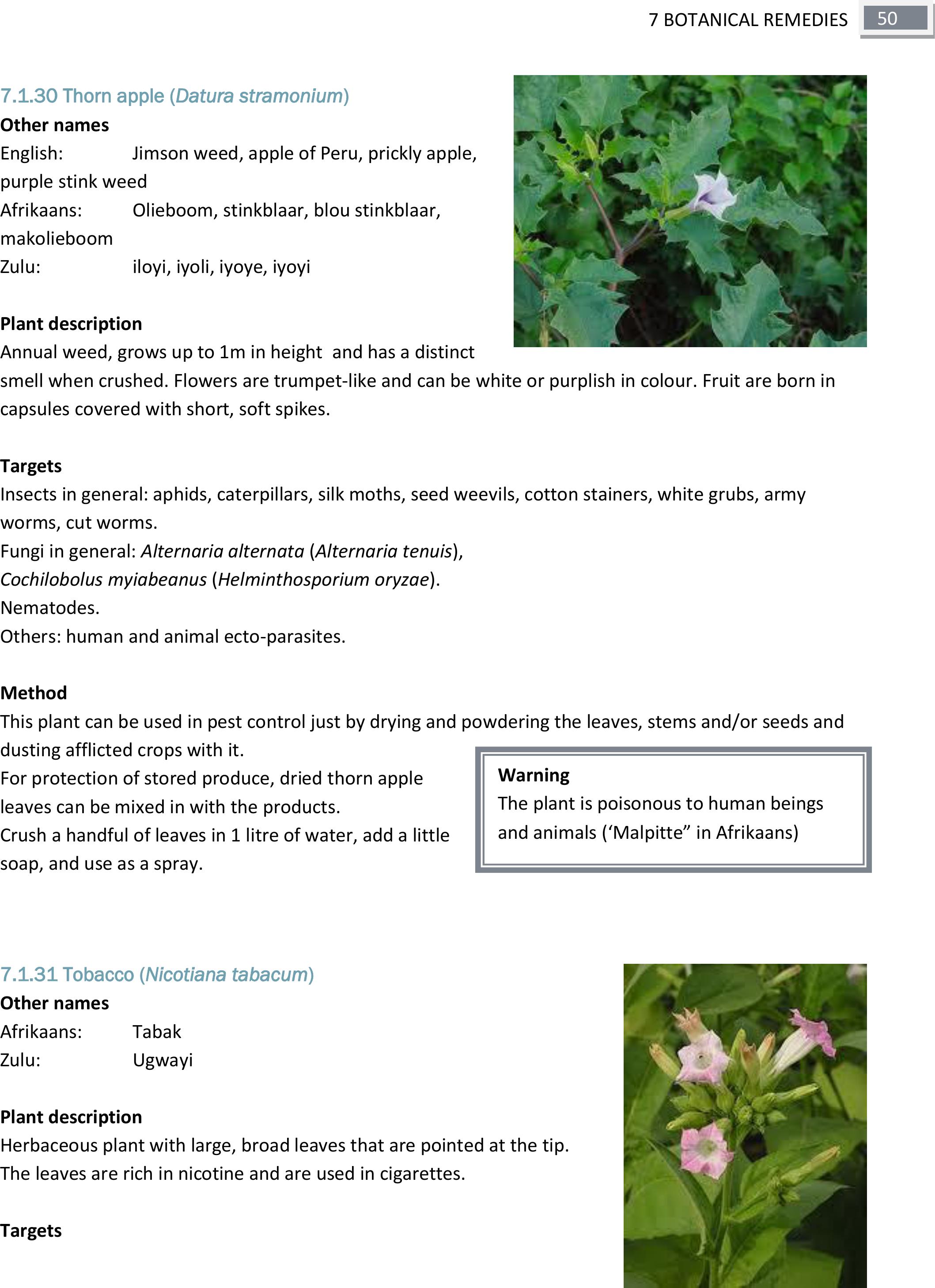
50
7 BOTANICAL REMEDIES
7.1.30 Thorn apple (Datura stramonium)
Other names
English: Jimson weed, apple of Peru, prickly apple,
purple stink weed
Afrikaans: Olieboom, stinkblaar, blou stinkblaar,
makolieboom
Zulu: iloyi, iyoli, iyoye, iyoyi
Plant description
Annual weed, grows up to 1m in height and has a distinct
smell when crushed. Flowers are trumpet-like and can be white or purplish in colour. Fruit are born in
capsules covered with short, soft spikes.
Targets
Insects in general: aphids, caterpillars, silk moths, seed weevils, cotton stainers, white grubs, army
worms, cut worms.
Fungi in general: Alternaria alternata (Alternaria tenuis),
Cochilobolus myiabeanus (Helminthosporium oryzae).
Nematodes.
Others: human and animal ecto-parasites.
Method
This plant can be used in pest control just by drying and powdering the leaves, stems and/or seeds and
dusting afflicted crops with it.
For protection of stored produce, dried thorn apple
leaves can be mixed in with the products.
Crush a handful of leaves in 1 litre of water, add a little
soap, and use as a spray.
7.1.31 Tobacco (Nicotiana tabacum)
Other names
Afrikaans: Tabak
Zulu: Ugwayi
Plant description
Herbaceous plant with large, broad leaves that are pointed at the tip.
The leaves are rich in nicotine and are used in cigarettes.
Targets
Warning
The plant is poisonous to human beings
and animals (‘Malpitte” in Afrikaans)

51
7 BOTANICAL REMEDIES
Insects in general: aphids, caterpillars, mites, stem borers, thrips, leaf miners, whitefly, leafhoppers, flea
beetles, grain weevils, fleas, lawn caterpillars, scale insects, termites, ticks and spider mites. Fungi in
general: rust.
Viruses in general: leaf curl virus.
Others: bilharzia snails, slugs and snails.
Method
It is estimated that nicotine extracts from tobacco have been used as insecticides since 1890.
The extract is more effective during warm weather, but degrades quickly.
The whole plant can be used: soak 1 kg of bruised leaves and stalks in 15 litres of water for 24 hours. The
solution is strained and a little soap added. The addition of slaked lime will increase the effectiveness of
the spray. When the nicotine is exposed to sunlight, it breaks down within a few days. Use as a general
spray.
A nicotine spray ban be made using 10 cigarettes (or 50g
pipe tobacco or 50g tobacco dust). Put in 5 litres of hot
water for 24 hours, strain, dilute with 25 litres of water
and spray.
Dry and grind the plant very finely into a powder for
dusting onto pests.
Dust on trees and crops to repel insects and to control leaf
curl virus.
Mulch with scrap leaves to repel
slugs and snails, nymphs and
larvae hiding in the soil, or in
other mulching material, and to
repel aphids, flea beetles and
thrips.
Warning
Tobacco is one of the natural remedies that is more poisonous than
some chemicals.
Avoid contact with the liquid forms, use protective clothing when
spraying or use a watering can. Be careful when using this spray as
tobacco can be absorbed through the skin.
Do not harvest plants within 3 days of spraying.
Tobacco sprays can burn the leaves of plants, do dilute and use
carefully.
Do not use the tobacco spray on the Solanacea family (tomatoes,
potatoes, brinjals and peepers), as you may transfer tobacco mosaic
virus to your plants.
Nicotine can kill earthworms and other beneficial soil organisms.
Nicotine is poisonous to fish.
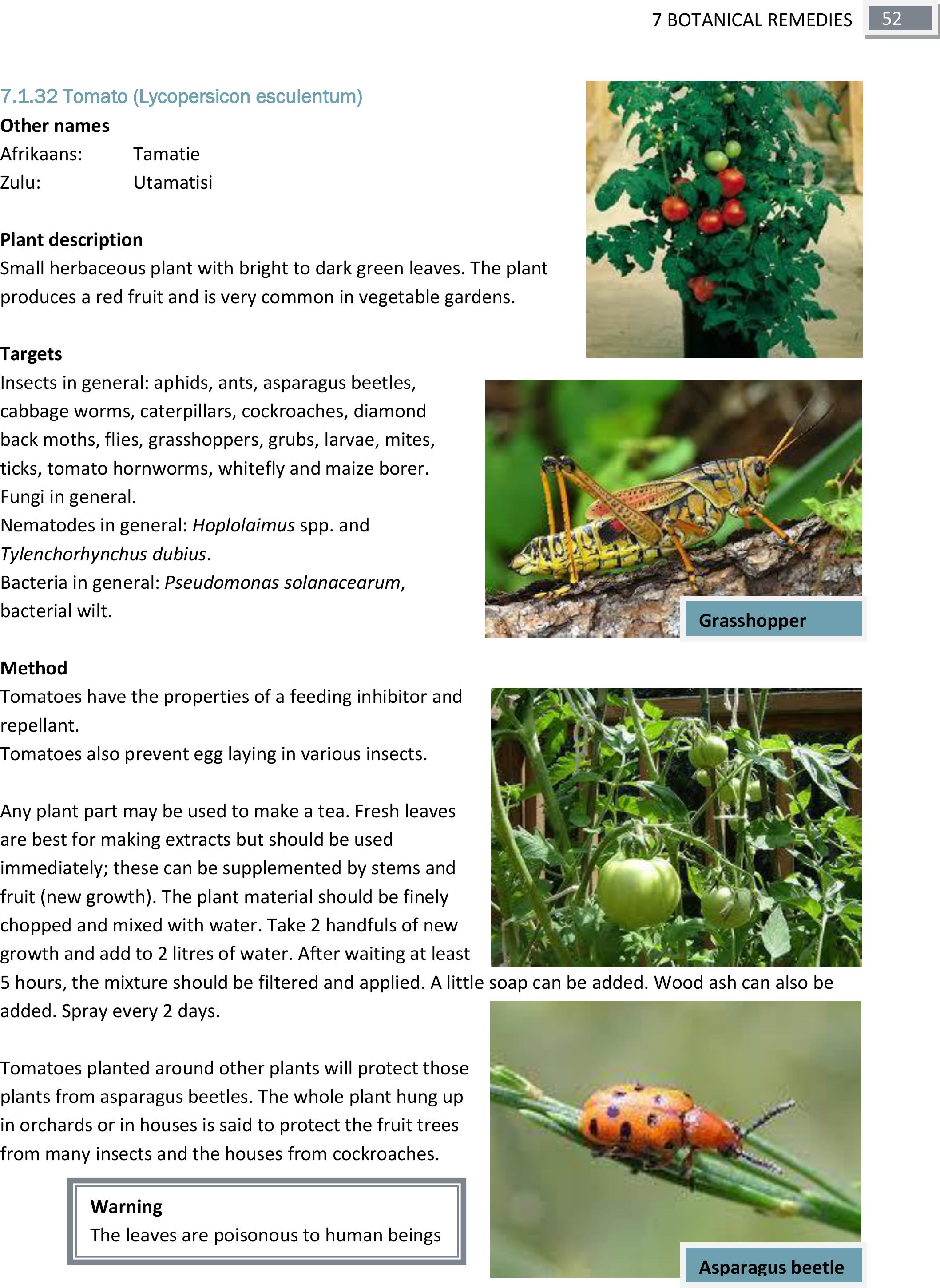
52
7 BOTANICAL REMEDIES
7.1.32 Tomato (Lycopersicon esculentum)
Other names
Afrikaans: Tamatie
Zulu: Utamatisi
Plant description
Small herbaceous plant with bright to dark green leaves. The plant
produces a red fruit and is very common in vegetable gardens.
Targets
Insects in general: aphids, ants, asparagus beetles,
cabbage worms, caterpillars, cockroaches, diamond
back moths, flies, grasshoppers, grubs, larvae, mites,
ticks, tomato hornworms, whitefly and maize borer.
Fungi in general.
Nematodes in general: Hoplolaimus spp. and
Tylenchorhynchusdubius.
Bacteria in general: Pseudomonassolanacearum,
bacterial wilt.
Method
Tomatoes have the properties of a feeding inhibitor and
repellant.
Tomatoes also prevent egg laying in various insects.
Any plant part may be used to make a tea. Fresh leaves
are best for making extracts but should be used
immediately; these can be supplemented by stems and
fruit (new growth). The plant material should be finely
chopped and mixed with water. Take 2 handfuls of new
growth and add to 2 litres of water. After waiting at least
5 hours, the mixture should be filtered and applied. A little soap can be added. Wood ash can also be
added. Spray every 2 days.
Tomatoes planted around other plants will protect those
plants from asparagus beetles. The whole plant hung up
in orchards or in houses is said to protect the fruit trees
from many insects and the houses from cockroaches.
Grasshopper
Asparagus beetle
Warning
The leaves are poisonous to human beings

53
7 BOTANICAL REMEDIES
7.2 ENRICHED SPRAYS
Enriched sprays are liquid manures/teas that assist both with fertility and protection against pest and
disease control.
These sprays build up the immunity of plant, assist with minor nutrient and mineral deficiencies
balancing the nutrient uptake of plants as well as the microbial populations on the plant and in the soil
around the plant. In the process of fermentation antibiotics develop that kill disease causing organism.
The plants’ resistance is stimulated in the process
The following sprays have been used in South America with great success, by Maria José Guazzelli, of
Future Earth:
7.2.1 Vegetable & weed spray
This is a good all purpose spray that can be used as a foliar feed and to water
the plants and the soil around the plants.
Mix the following ingredients in a 100 L container:
2.5 kg of chopped sugarcane
1 L milk
80 L of different vegetables - cabbage, cucumber, broccoli, fruit, etc.
Add the vegetables gradually over the standing period. (Diseased
produce can be used)
0.25 kg of crushed bones or bone meal
0.125 kg agricultural lime
0.75 wood ash
5 - 8 L chopped weeds
Top up the container with water and stir well
Wait 20 - 30 days to ferment and sieve the mixture.
Add 2 - 5 L of the juice extract to 100 L water.
Warning
It is important to dilute the mixture before use, as
it can burn the leaves of plants if too strong.
Tips on mixtures
If you do not have sugarcane or sugar, you can replace it with produce high in starch such as potatoes.
Urine can be used instead of milk, as it speeds up the fermentation process. Fish and cattle rumen can also be
used to ferment the mixture.
Bones and horn contain phosphorous, calcium (Ca) and magnesium (Mg)
Agricultural lime contains Ca and Mg and can be replaced by egg shells
Diseased produced can be used in the mixtures – the disease causing organism are killed by the fermentation
process
It is important to dilute the mixtures before applying them to the leaves of crops ,or they might burn the plants.
NB: Eucalyptus,Suringa and Lantana should not be used for any of the enriched sprays.
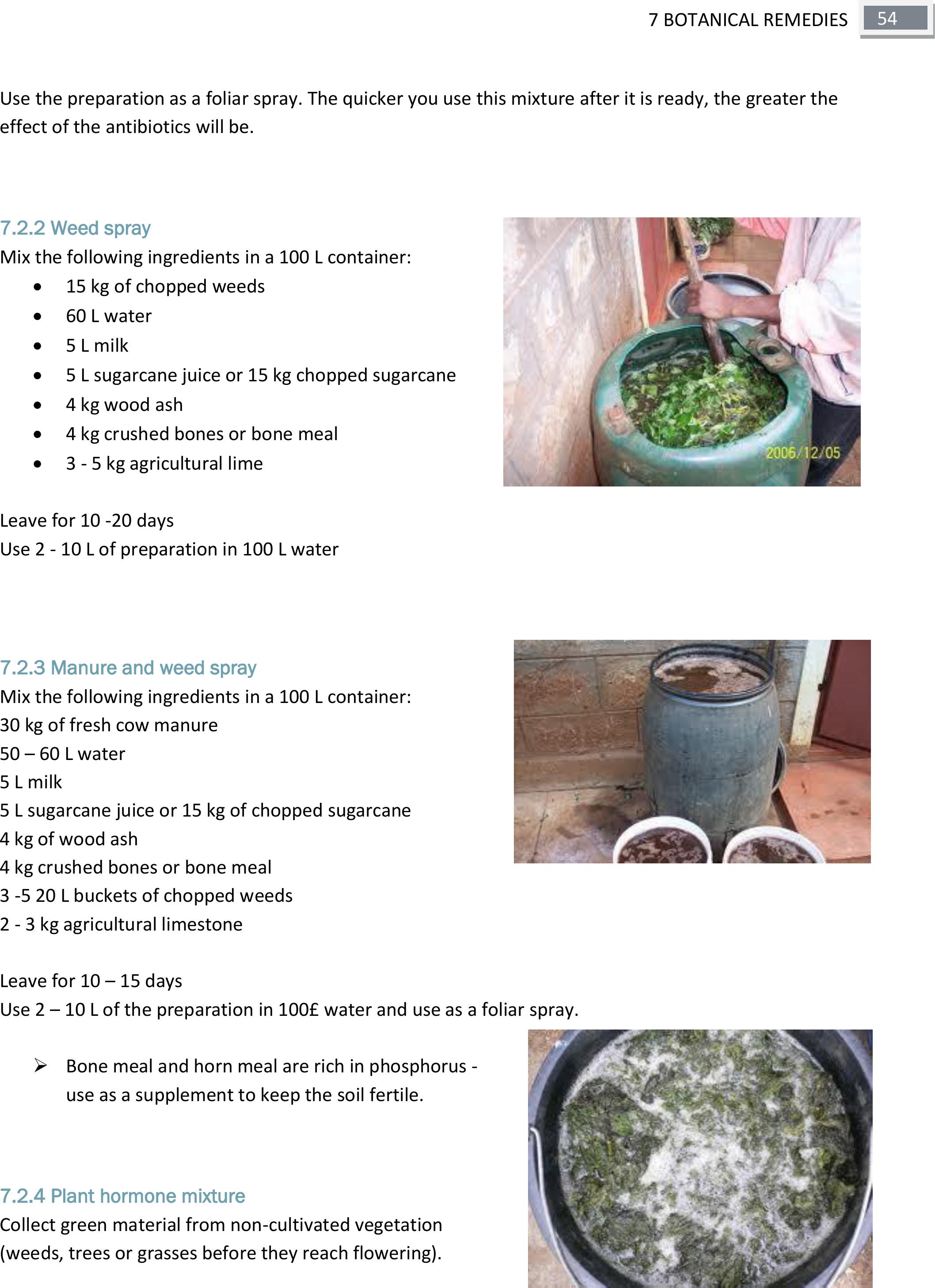
54
7 BOTANICAL REMEDIES
Use the preparation as a foliar spray. The quicker you use this mixture after it is ready, the greater the
effect of the antibiotics will be.
7.2.2 Weed spray
Mix the following ingredients in a 100 L container:
15 kg of chopped weeds
60 L water
5 L milk
5 L sugarcane juice or 15 kg chopped sugarcane
4 kg wood ash
4 kg crushed bones or bone meal
3 - 5 kg agricultural lime
Leave for 10 -20 days
Use 2 - 10 L of preparation in 100 L water
7.2.3 Manure and weed spray
Mix the following ingredients in a 100 L container:
30 kg of fresh cow manure
50 – 60 L water
5 L milk
5 L sugarcane juice or 15 kg of chopped sugarcane
4 kg of wood ash
4 kg crushed bones or bone meal
3 -5 20 L buckets of chopped weeds
2 - 3 kg agricultural limestone
Leave for 10 – 15 days
Use 2 – 10 L of the preparation in 100£ water and use as a foliar spray.
Bone meal and horn meal are rich in phosphorus -
use as a supplement to keep the soil fertile.
7.2.4 Plant hormone mixture
Collect green material from non-cultivated vegetation
(weeds, trees or grasses before they reach flowering).
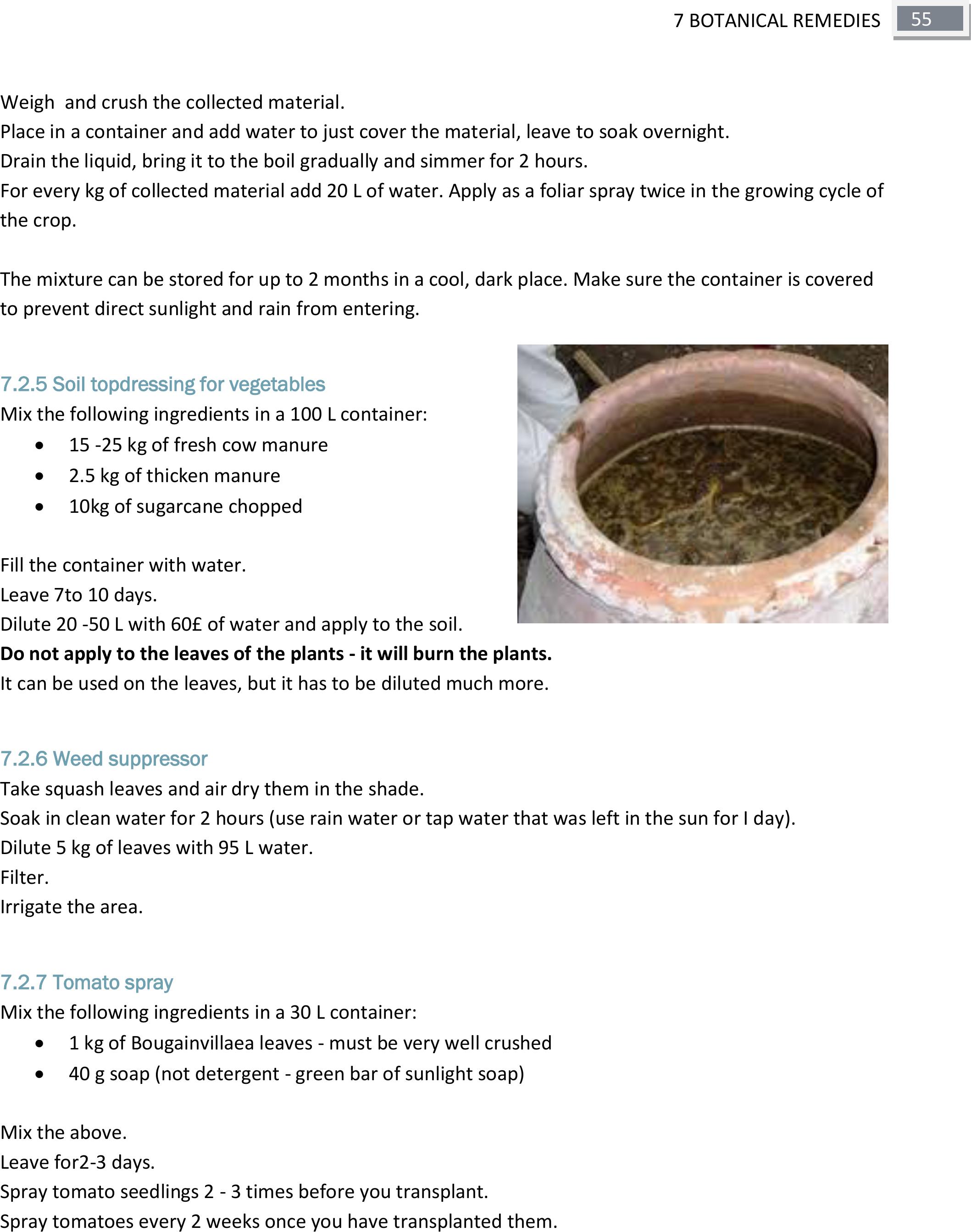
55
7 BOTANICAL REMEDIES
Weigh and crush the collected material.
Place in a container and add water to just cover the material, leave to soak overnight.
Drain the liquid, bring it to the boil gradually and simmer for 2 hours.
For every kg of collected material add 20 L of water. Apply as a foliar spray twice in the growing cycle of
the crop.
The mixture can be stored for up to 2 months in a cool, dark place. Make sure the container is covered
to prevent direct sunlight and rain from entering.
7.2.5 Soil topdressing for vegetables
Mix the following ingredients in a 100 L container:
15 -25 kg of fresh cow manure
2.5 kg of thicken manure
10kg of sugarcane chopped
Fill the container with water.
Leave 7to 10 days.
Dilute 20 -50 L with 60£ of water and apply to the soil.
Do not apply to the leaves of the plants - it will burn the plants.
It can be used on the leaves, but it has to be diluted much more.
7.2.6 Weed suppressor
Take squash leaves and air dry them in the shade.
Soak in clean water for 2 hours (use rain water or tap water that was left in the sun for I day).
Dilute 5 kg of leaves with 95 L water.
Filter.
Irrigate the area.
7.2.7 Tomato spray
Mix the following ingredients in a 30 L container:
1 kg of Bougainvillaea leaves - must be very well crushed
40 g soap (not detergent - green bar of sunlight soap)
Mix the above.
Leave for2-3 days.
Spray tomato seedlings 2 - 3 times before you transplant.
Spray tomatoes every 2 weeks once you have transplanted them.

56
7 BOTANICAL REMEDIES
7.2.8 Compost Spray
Compost targets most pests and diseases, as it gives the plants greater resistance to attack from pests
and diseases.
Use well-rotted compost and plant materials.
Spray the plants and the soil with a mixture of 1 shovelful of compost in 20 litres of water after the mix
has been standing for three days to several weeks. Compost supplies the plants with much needed
nutrients to help plants withstand attack and to increase yields. The longer the mix is left to stand, the
stronger and more effective it becomes. The spray is applied once a week when plants are still young.
By increasing the compost level in the soil, plants can be protected against all pests and diseases.
Apply the spray as a preventative measure and as a regular weekly treatment once the disease appears.

57
8 ORGANIC REMEDIES
8 ORGANIC REMEDIES
8.1 REMEDIES FROM ORGANIC MATERIAL
8.1.1 Ash
Targets
Insects in general: aphids, cabbage root fly, caterpillars, cucumber
beetles, cutworms, grasshoppers, larvae, potato moths, root
maggots, squash bugs, stalk borers, termites and weevils.
Fungi in general: mildew and clubroot.
Bacteria in general.
Others: slugs, snails, birds and nematodes.
Method
Spray with a mixture of I heaped tablespoon of wood ash
in 1 litre of water, leave overnight, strain to remove
solids, mix in 1 cup of sour milk and add 3 litres of water.
This treatment is said to be successful against mildew
and a range of pests.
Wood ash mixed with soapy water and/or lime can act as
a general insecticide.
Soaking seed in wood ash and water for 24 hours before planting gives protection against fungal and
bacterial diseases. If the juice or leaves of any strongly aromatic plant is added to the water it will also
deter birds from eating the seed. Some strong-smelling plants can, however, affect the viability of
seed.
Wood ash is a good alkaline fertilizer. Spreading a circle around the base of plants and soaking it in with
water can control maggots, cutworms, cucumber beetles, squash bugs and slugs. The dust dehydrates
soft-bodied insects. Ash can also be mixed with compost and dug into the soil.
Wood ash contains potassium, calcium and phosphorus.
Warning
Only wood ash can be sued. Never us ash from coal fires as this is poisonous to the soil
and plants.
Do not allow ash to touch the steams of plants, especially seedlings.
Protect eyes from ash
Ensure that ash has cooled down properly before using it in the garden.
Cabbage root fly maggots

58
8 ORGANIC REMEDIES
8.1.2 Bicarbonate of Soda
Targets
Insects: aphids and scale insects. Fungal diseases: mildew
and rust,
Method
Mix 1 teaspoon of bicarbonate of soda with 1 teaspoon of
liquid soap in 5 litres of water.
Use as a spray on affected plants.
8.1.3 Bordeaux mixture
Targets
Fungi in general: powdery mildew, downy mildew, tomato and potato
blight, black spot on beans, leaf curl on peaches, rust.
Right; Leaf curl on peaches, a fungal disease that can be easily treated
with Bordeaux mixture.
Method
Mix 90g of blue copper sulphate with 4.5 litres of water in a
nonmetallic container. In another non-metallic container, mix 125g of
slaked lime (builders lime) with 4.5 litres of water. Stir and make sure the lime is well dissolved. Mix the
two solutions and stir well. Test the mixture by putting an old nail in it for 30 seconds. If it turns blue,
there is not enough lime in the mixture or the lime is not sufficiently dissolved in the water. Allow the
lime to soak longer, otherwise the mixture will burn the leaves. Apply twice at 7 day
intervals, but only if necessary.
Warning
Bicarbonate of soda can burn the leaves of plants if it
is not diluted properly, and also if it is applied too
often
Warning
At high concentrations the mixture is toxic to soil
organisms, plants, animals and human beings.
Scale insects

59
8 ORGANIC REMEDIES
8.1.4 Builders’ lime
Targets
Insects: larvae.
Slugs and snails.
Method
Spray lime and water mixtures onto tender plant parts only after the
mixture has been allowed to stand for a few days for the heat of
hydration to disappear.
8.1.5 Clay, lime and other powdery materials
(Any fine powdery materials such as clay, lime, flour, chalk, etc.)
Targets
Insects in general: ants, aphids, beetles, caterpillars, codling moths, cutworms, insect eggs, larvae, mites,
scale insects, squash bugs, stink bugs, thrips and white fly.
Fungi: clubroot.
Others: slugs and snails.
Bacteria: canker.
Method
Dust onto leaves, the insects or their eggs, to suffocate them.
Dust around the base of plants to protect them from crawling insects.
Spray with a mixture of the powdery material in water.
Mix clay with fresh cattle manure to form a paste and paint the mixture on trunks of trees against
codling moths and other pests and to seal cuts on the trees after pruning.
Fill wounds in trees, including those caused
by cutting out canker, with moist clay
rammed in tight.
Warning
Do not apply dry dust onto tender plant parts such as
leaves.
Liming of acid soil reduces the incidence of cutworm
and clubroot.
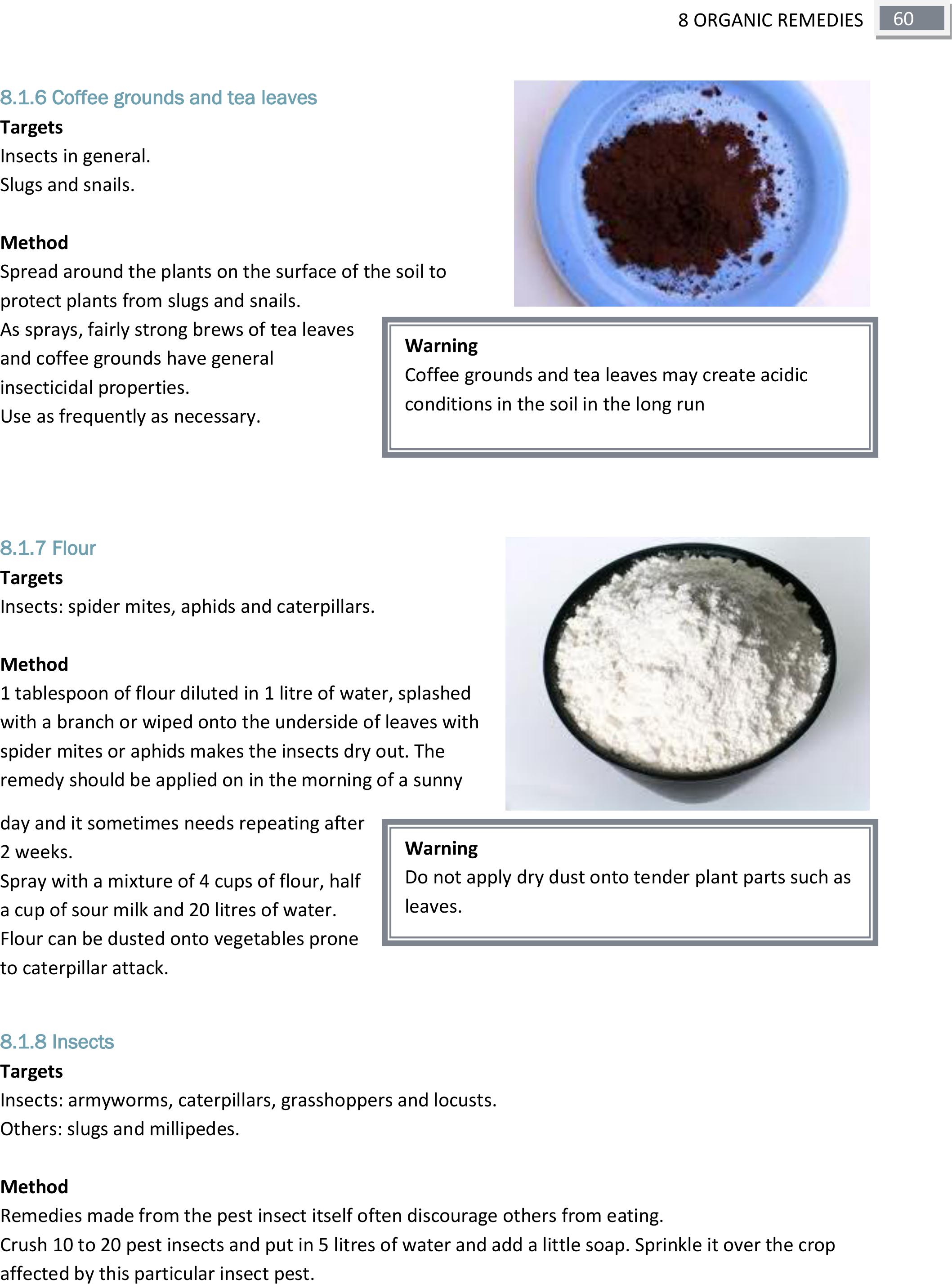
60
8 ORGANIC REMEDIES
8.1.6 Coffee grounds and tea leaves
Targets
Insects in general.
Slugs and snails.
Method
Spread around the plants on the surface of the soil to
protect plants from slugs and snails.
As sprays, fairly strong brews of tea leaves
and coffee grounds have general
insecticidal properties.
Use as frequently as necessary.
8.1.7 Flour
Targets
Insects: spider mites, aphids and caterpillars.
Method
1 tablespoon of flour diluted in 1 litre of water, splashed
with a branch or wiped onto the underside of leaves with
spider mites or aphids makes the insects dry out. The
remedy should be applied on in the morning of a sunny
day and it sometimes needs repeating after
2 weeks.
Spray with a mixture of 4 cups of flour, half
a cup of sour milk and 20 litres of water.
Flour can be dusted onto vegetables prone
to caterpillar attack.
8.1.8 Insects
Targets
Insects: armyworms, caterpillars, grasshoppers and locusts.
Others: slugs and millipedes.
Method
Remedies made from the pest insect itself often discourage others from eating.
Crush 10 to 20 pest insects and put in 5 litres of water and add a little soap. Sprinkle it over the crop
affected by this particular insect pest.
Warning
Coffee grounds and tea leaves may create acidic
conditions in the soil in the long run
Warning
Do not apply dry dust onto tender plant parts such as
leaves.

61
8 ORGANIC REMEDIES
Remedies made from insects are more effective when diseased
insects are added. Sometimes a paralysed grasshopper can be
found on top of a stalk of grass. A fungus grows inside it and when
added to an insect remedy one can help to spread the disease to
infect more grasshoppers.
8.1.9 Milk
Targets
Insects: spider mites and caterpillars.
Fungi in general: blights and mildews.
Viruses in general: mosaic virus.
Method
Spray 1 litre of milk diluted with 10 to 15 litres of water. The spray has to
be repeated after 10 days for diseases and after 3 weeks for insects.
Stir 1 heaped teaspoon of wood ash vigorously into 1 litre of water, leave
overnight, strain to remove solids, add 1 cup of sour milk and add 3 litres
of water. This mixture has been found to be effective in controlling
mildew, when applied as a full-cover spray.
Sprays of skimmed milk have been used to control many viral diseases.
8.1.10 Paraffin
Targets
Birds.
Method
Dip seeds in paraffin before planting. It will prevent birds from digging up the newly-planted seeds.
Warning
Many colourful insects, such as blister beetles for
example have poison in their bodies and a remedy
made form them should be handled with care.
Blister beetle
Warning
Don’t use seed as food after treating with paraffin. Keep paraffin away from
children and make sure it is stored in appropriate containers (not cool drink bottles)

62
8 ORGANIC REMEDIES
8.1.11 Salt preparations
Targets
Insects in general: aphids, cabbage worms, caterpillars and
whitefly.
Others: slugs and snails.
Method
Spray aphid and whitefly with a mixture of 1 teaspoon of salt
to 1 tablespoon of vinegar and mix with 1 litre of water. Add
half a teaspoon of liquid soap.
The above mixture has been recommended for use on
aphids, cabbage worm and caterpillars and as a general
repellant.
Sprinkle a few grains of dry salt on slugs and snails to
make them shrivel up and die.
8.1.12 Soap solutions
Targets
Insects in general: aphids, crickets, armyworms, caterpillars, leaf
miners, mites, psyllid, whitefly, small beetles and thrips.
Fungi in general.
Others: slugs and snails.
Method
Soap has been used for the control of soft-bodied plant pests since
1787. Most of these soaps were derived from either plant oils
(cottonseed, olive, palm or coconut) or from animal fat (whale oil or
fish oil). Soap breaks down the membranes of insects and causes
them to die, or it suffocates them.
Soap can be added to many of the plant remedies to increase the effectiveness of the solution. Soap
makes the solution stick easily on plants and pests. Soap is also added in small quantities to other
preparations as it helps the spray to stay on the leaves and to spread out into a thin coating. Many soft-
bodied pests such as aphids, caterpillars and whitefly can be controlled with soap alone.
Take 50g soap and dissolve in 2 to 5 litres of water. Spray onto the pests and plants.
Stronger soap solutions are needed for bigger insects. Some soaps are said to have a slight fungicidal
effect.
Warning
Too much salt can damage the structure
of the soil
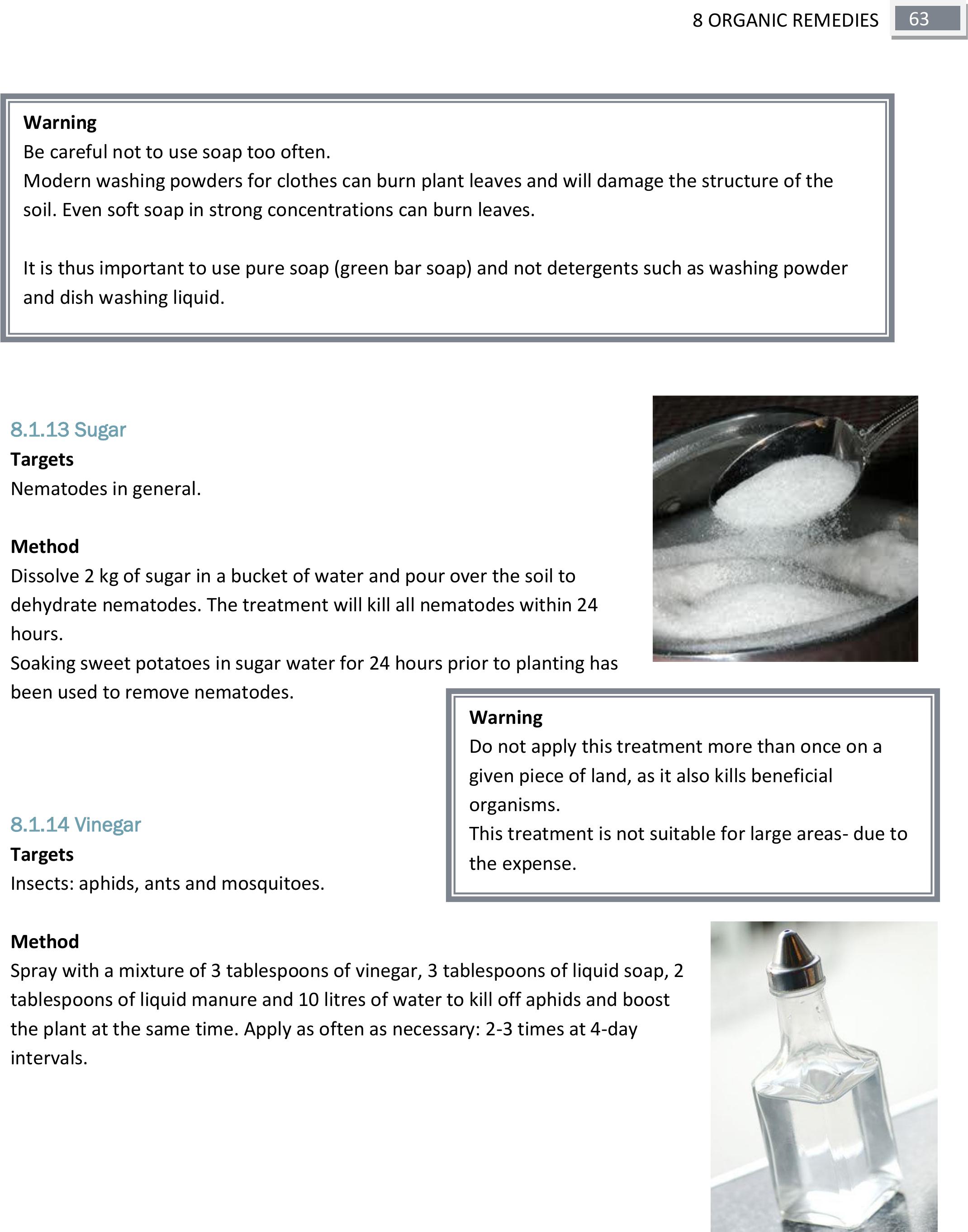
63
8 ORGANIC REMEDIES
8.1.13 Sugar
Targets
Nematodes in general.
Method
Dissolve 2 kg of sugar in a bucket of water and pour over the soil to
dehydrate nematodes. The treatment will kill all nematodes within 24
hours.
Soaking sweet potatoes in sugar water for 24 hours prior to planting has
been used to remove nematodes.
8.1.14 Vinegar
Targets
Insects: aphids, ants and mosquitoes.
Method
Spray with a mixture of 3 tablespoons of vinegar, 3 tablespoons of liquid soap, 2
tablespoons of liquid manure and 10 litres of water to kill off aphids and boost
the plant at the same time. Apply as often as necessary: 2-3 times at 4-day
intervals.
Warning
Do not apply this treatment more than once on a
given piece of land, as it also kills beneficial
organisms.
This treatment is not suitable for large areas- due to
the expense.
Warning
Be careful not to use soap too often.
Modern washing powders for clothes can burn plant leaves and will damage the structure of the
soil. Even soft soap in strong concentrations can burn leaves.
It is thus important to use pure soap (green bar soap) and not detergents such as washing powder
and dish washing liquid.

64
8 ORGANIC REMEDIES
8.1.15 Mulch
(Dead plant material: crop residues, hay, leaves, weeds, etc.)
Targets
Insects: cutworms, grasshoppers, ground beetles, lawn caterpillars,
moths, termites and thrips.
Others: nematodes, slugs and snails.
Method
Cover the soil with mulch, one finger deep, preferably. The mulch
should consist of as wide a variety of plant material as possible.
Mulches of aromatic herbs are recommended for protecting plants
from cutworms, ground beetles, thrips, slugs and snails. Covering
the bare soil with mulch discourages grasshoppers, moths and
certain beetles from laying their eggs in the soil. It also reduces the
number of harmful nematodes in the soil.
To repel termites, include banana stems and mixtures of aromatic
plants mid weeds. Wood chips can help in aerating the soil and
increasing soil moisture.
8.1.16 Manure, dung and urine
(Cow, donkey, goat, predatory animal and poultry manure, and
human and animal urine.)
Targets
Insects: aphids, bagrada bugs, caterpillars, codling moths,
cutworms, fruit flies, grasshoppers, mealy bugs, mites, stalk
borers and thrips.
Birds.
Fungi in general: mildew and scab.
Bacteria in general.
Viruses in general.
Method
Spray with a mixture of 1 shovelful of dry cow manure mixed
thoroughly into 10 litres of water after it has been stirred once
daily for 14 days. Clay dust can be sprinkled into the bucket to
Stalk borer
Bagrada bug
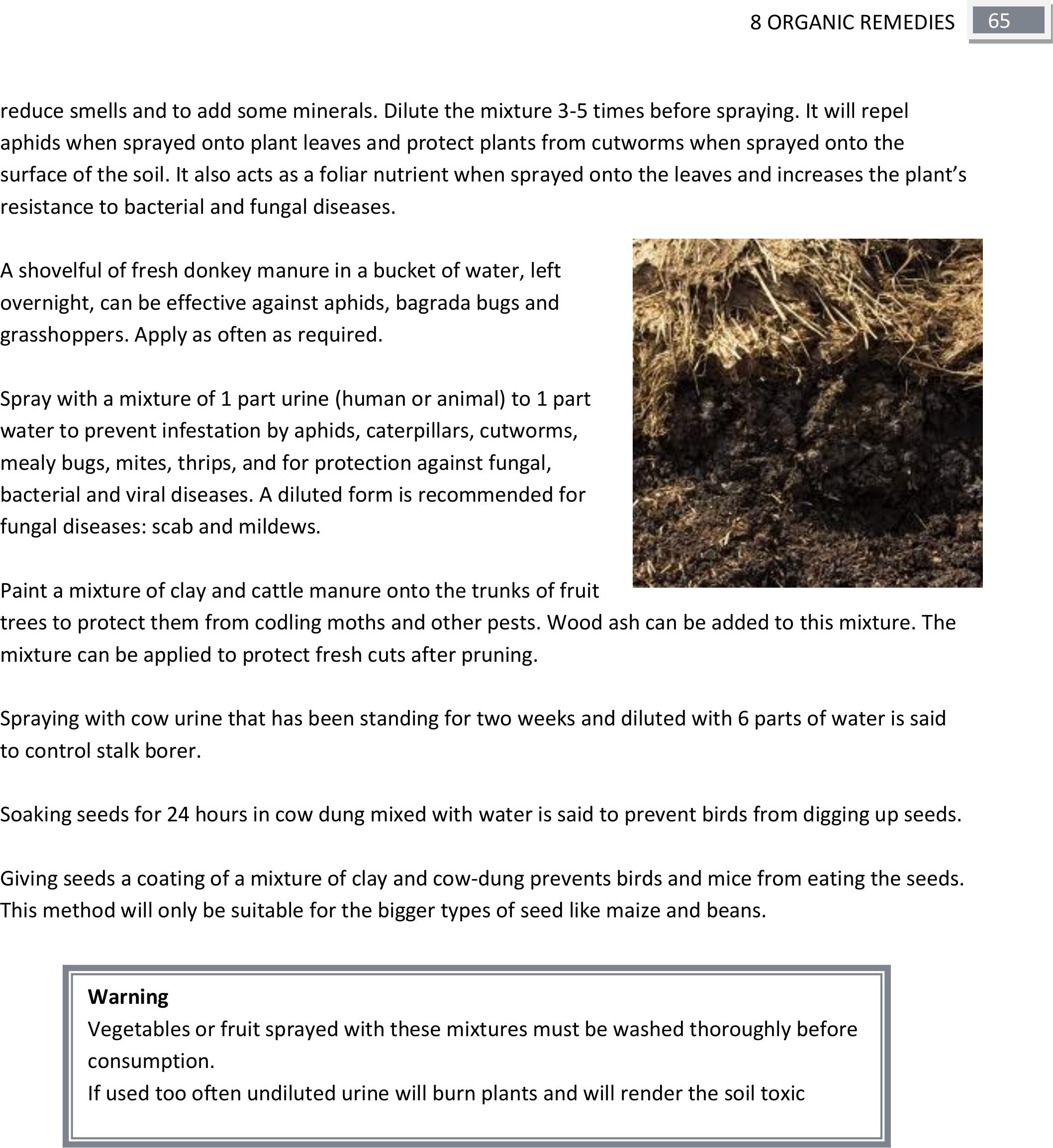
65
8 ORGANIC REMEDIES
reduce smells and to add some minerals. Dilute the mixture 3-5 times before spraying. It will repel
aphids when sprayed onto plant leaves and protect plants from cutworms when sprayed onto the
surface of the soil. It also acts as a foliar nutrient when sprayed onto the leaves and increases the plant’s
resistance to bacterial and fungal diseases.
A shovelful of fresh donkey manure in a bucket of water, left
overnight, can be effective against aphids, bagrada bugs and
grasshoppers. Apply as often as required.
Spray with a mixture of 1 part urine (human or animal) to 1 part
water to prevent infestation by aphids, caterpillars, cutworms,
mealy bugs, mites, thrips, and for protection against fungal,
bacterial and viral diseases. A diluted form is recommended for
fungal diseases: scab and mildews.
Paint a mixture of clay and cattle manure onto the trunks of fruit
trees to protect them from codling moths and other pests. Wood ash can be added to this mixture. The
mixture can be applied to protect fresh cuts after pruning.
Spraying with cow urine that has been standing for two weeks and diluted with 6 parts of water is said
to control stalk borer.
Soaking seeds for 24 hours in cow dung mixed with water is said to prevent birds from digging up seeds.
Giving seeds a coating of a mixture of clay and cow-dung prevents birds and mice from eating the seeds.
This method will only be suitable for the bigger types of seed like maize and beans.
Warning
Vegetables or fruit sprayed with these mixtures must be washed thoroughly before
consumption.
If used too often undiluted urine will burn plants and will render the soil toxic
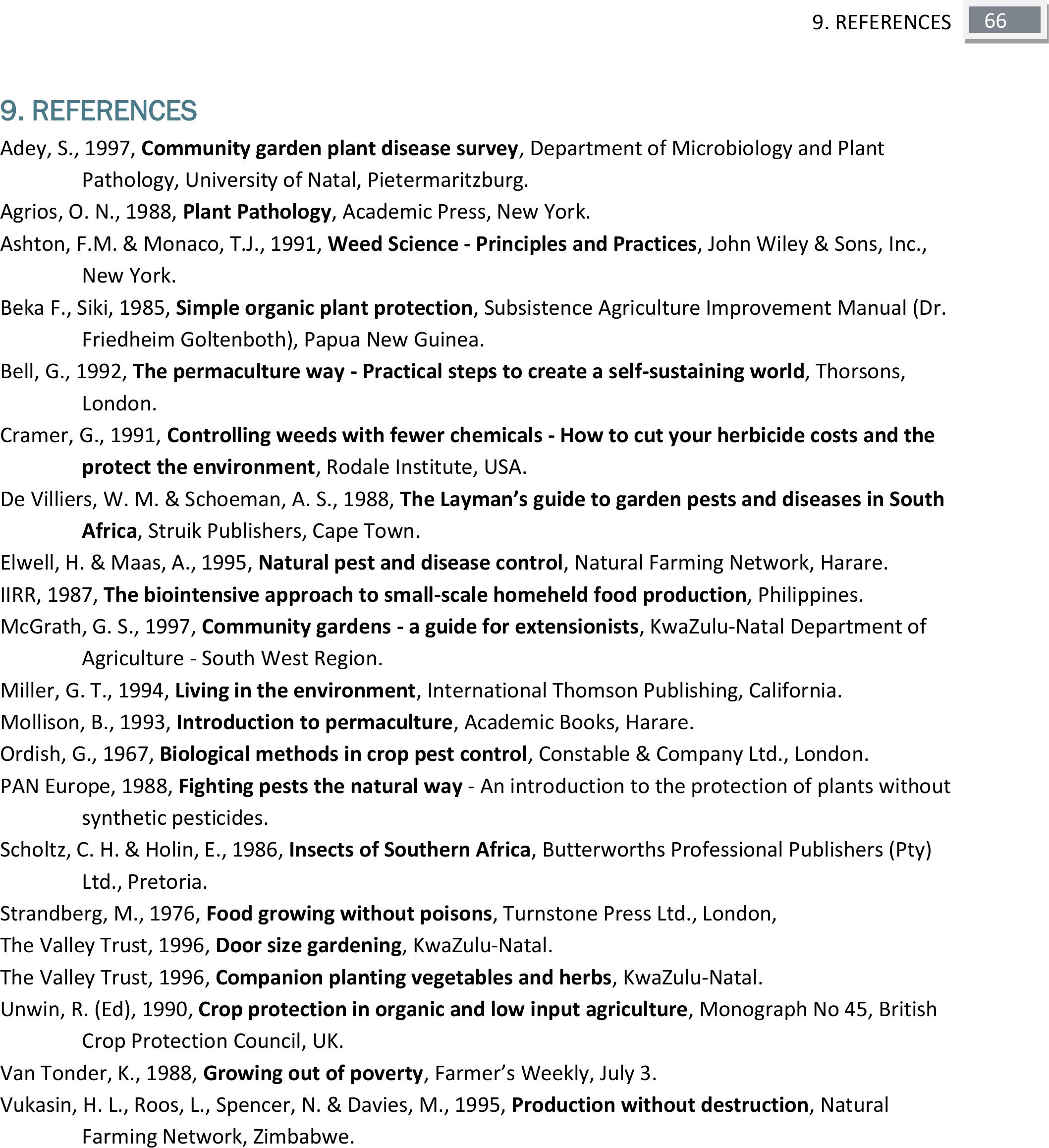
66
9. REFERENCES
9. REFERENCES
Adey, S., 1997, Community garden plant disease survey, Department of Microbiology and Plant
Pathology, University of Natal, Pietermaritzburg.
Agrios, O. N., 1988, Plant Pathology, Academic Press, New York.
Ashton, F.M. & Monaco, T.J., 1991,Weed Science - Principles and Practices, John Wiley & Sons, Inc.,
New York.
Beka F., Siki, 1985, Simple organic plant protection, Subsistence Agriculture Improvement Manual (Dr.
Friedheim Goltenboth), Papua New Guinea.
Bell, G., 1992, The permaculture way - Practical steps to create a self-sustaining world, Thorsons,
London.
Cramer, G., 1991, Controlling weeds with fewer chemicals - How to cut your herbicide costs and the
protect the environment, Rodale Institute, USA.
De Villiers, W. M. & Schoeman, A. S., 1988, The Layman’s guide to garden pests and diseases in South
Africa, Struik Publishers, Cape Town.
Elwell, H. & Maas, A., 1995,Natural pest and disease control, Natural Farming Network, Harare.
IIRR, 1987, The biointensive approach to small-scale homeheld food production, Philippines.
McGrath, G. S., 1997, Community gardens - a guide for extensionists, KwaZulu-Natal Department of
Agriculture - South West Region.
Miller, G. T., 1994, Living in the environment, International Thomson Publishing, California.
Mollison, B., 1993, Introduction to permaculture, Academic Books, Harare.
Ordish, G., 1967, Biological methods in crop pest control, Constable & Company Ltd., London.
PAN Europe, 1988, Fighting pests the natural way - An introduction to the protection of plants without
synthetic pesticides.
Scholtz, C. H. & Holin, E., 1986, Insects of Southern Africa, Butterworths Professional Publishers (Pty)
Ltd., Pretoria.
Strandberg, M., 1976, Food growing without poisons, Turnstone Press Ltd., London,
The Valley Trust, 1996, Door size gardening, KwaZulu-Natal.
The Valley Trust, 1996, Companion planting vegetables and herbs, KwaZulu-Natal.
Unwin, R. (Ed), 1990, Crop protection in organic and low input agriculture, Monograph No 45, British
Crop Protection Council, UK.
Van Tonder, K., 1988, Growing out of poverty, Farmer’s Weekly, July 3.
Vukasin, H. L., Roos, L., Spencer, N. & Davies, M., 1995, Production without destruction, Natural
Farming Network, Zimbabwe.